
Touropia Travel
Discover the World

25 Top Tourist Attractions in Mexico
By Mike Kaplan · Last updated on May 4, 2024
Mexico is one of the world’s most popular vacation destinations with over 20 million foreign visitors a year. Famous for its tequila, the Aztecs and the Mayas , Salma Hayek, Day of the Dead, drug wars, Lucha libre, Corona beer and the beach resorts on the Pacific and Caribbean side, Mexico can offer something for every sort of traveler.
From Pre-Columbian ruins and historic colonial towns to white powdery beaches and huge canyons, this country offers visitors a wide range of things to do. For ideas on the best places to visit check out our list of the top tourist attractions in Mexico.
25. Monte Alban
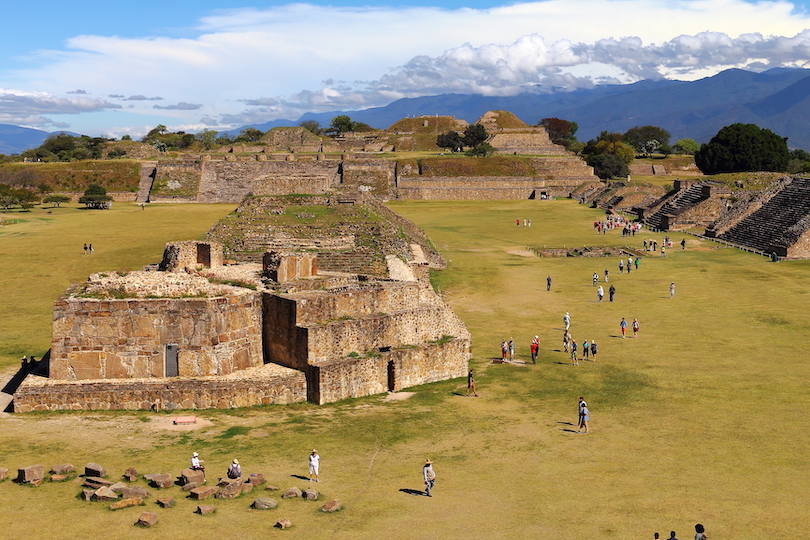
Monte Alban, or White Mountain, was once the ancient capital of the Zapotec people. Overlooking the Valley of Oaxaca, Monte Alban is one of the top archeological sites in Mexico. In addition to spectacular views over the valley, visitors will be able to see the ruined buildings around a broad, flat hilltop terrace, the Gran Plaza, that runs north to south.
Two large pyramid mounds terminate the great plaza at the ends, and the sides of the space are lined with stepped platforms and terraces.
24. San Miguel de Allende
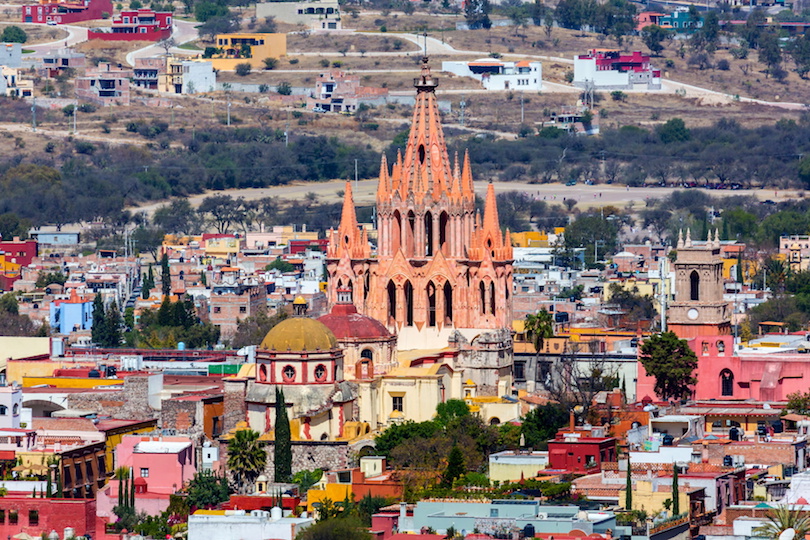
In the Bajio mountains of Central Mexico, there is a small colonial destination known as San Miguel de Allende. The city is bursting with history: It was founded by a San Franciscan Monk, played a big role in the war for Mexican independence from Spain and was a vital spot on the Mexican silver trail.
Today, it is best known for its colonial architecture and enchanting cobblestone streets. Historic buildings like the pink Teatro Angela Peralta and the Santuario de Atotonilco, an enormous church complex, are among the top attractions in the city.
23. Monarch Butterfly Biosphere Reserve
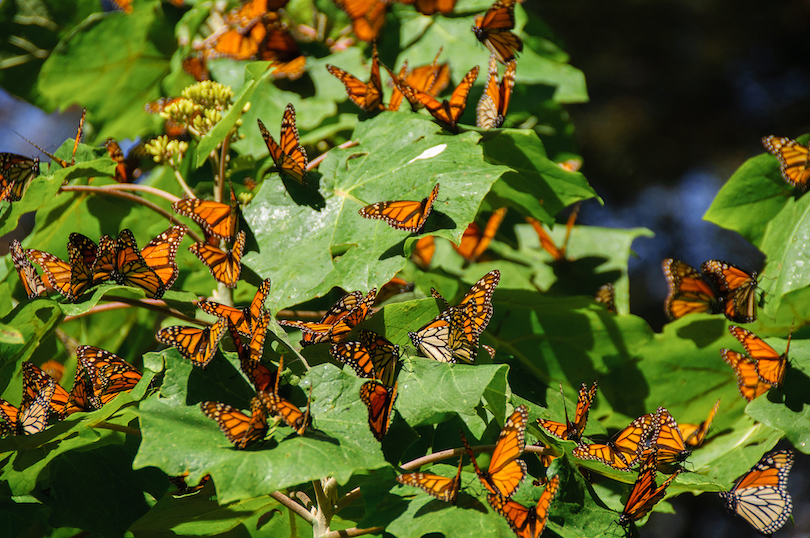
The annual Monarch butterfly migration is one of nature’s great spectacles and a top attraction for visitors to Mexico’s central highlands. Each year, millions of Monarch Butterflies make the journey from eastern Canada to the forests of western central Mexico, a journey that spans up to 3,000 miles.
The Monarch butterflies spend their winter hibernation clustered in small areas of the Monarch Butterfly Biosphere Reserve in Michoacan, before they travel to the north again.
22. Great Pyramid of Cholula
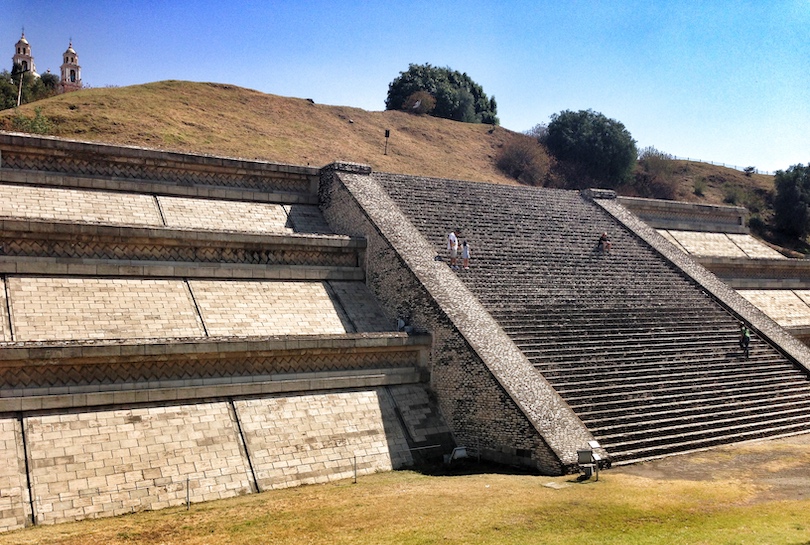
Outside of Puebla is the Great Pyramid of Cholula, an archeological site that is home to the largest pyramid in the world. Also known as Tlachihualtepetl, the Great Pyramid of Cholula was built in four stages, the first of which began 2,300 years ago. Much of the pyramid is now overgrown though and appears to be a natural hill topped by a Catholic church.
This is the “Iglesia de Nuestra Señora de los Remedios” which was built by the Spanish in 1594. Visitors are able to tour more than four miles of underground tunnels that showcase the sheer size and scope of this incredible landmark.
21. El Malecon
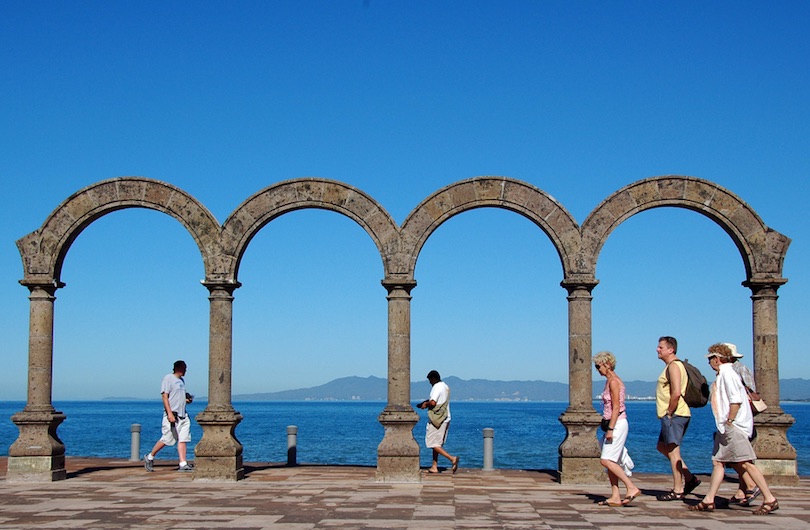
The boardwalk in Puerto Vallarta , also known as El Malecon, is a marvelous seaside promenade that border the blue waters of the Pacific. Most of El Malecon is exclusively for pedestrians, making it a safe place to take photos and admire the view.
Statues line the boardwalk, there are often elaborate sand displays on the beach, and there are also countless local establishments that cater to visitors. It is possible to stroll along El Malecon and stop for handmade souvenirs, some fresh seafood or a few tropical drinks at a local bar.
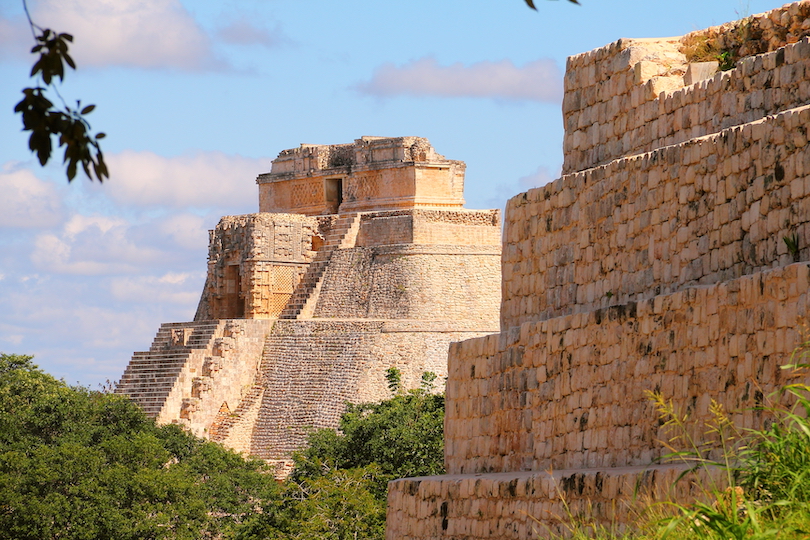
The ancient Mayan city of Uxmal is one of the most historically and culturally significant attractions in Mexico. Roughly 55 km (35 miles) south of Merida in Yucatan, the city was constructed primarily in the ninth century. Uxmal was once the capital of the region, and it is a prime example of Puuc architecture.
Various stone levels, along with elaborate stonework, gives the pyramid structures a grand appearance. Not to be missed is the Magician’s Pyramid, the tallest of the pyramids at Uxmal.
19. Zipolite
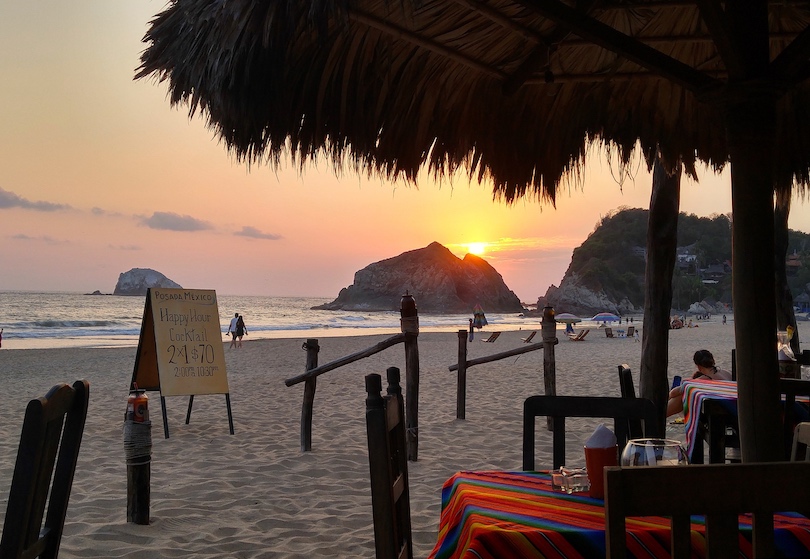
Along the Pacific Coast in the Oaxaca region is Zipolite, a one-mile beach that retains a progressive, hippie vibe. In decades past, Zipolite was a nude beach, although that is far less common today.
Zipolite attracts travelers in search of a counter-culture vibe, and it still retains an authentic Mexican atmosphere despite the tourists from all around the world. While the beach itself is the main attraction, Zipolite is also well known for Av Roca Blanca, a street just off the beach that offers bars, shops and cafes.
18. Museo Nacional de Antropologia
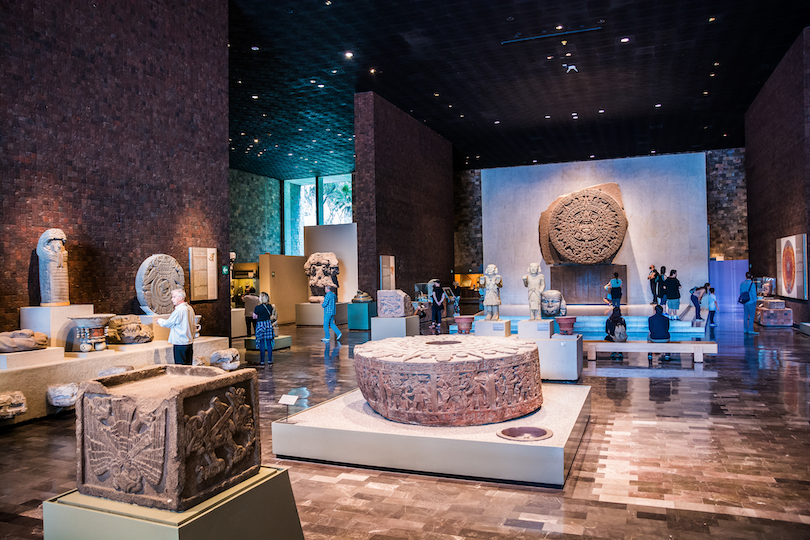
The Museo Nacional de Antropologia, or National Museum of Anthropology, is both the largest and most visited museum in all of Mexico. Located in Mexico City’s Chapultepec Park, the museum boasts an enormous collection of artifacts and exhibits relating to the pre-Columbian heritage of the country. This includes Mayan and Aztec pieces, such as the famed Stone of the Sun, which is the original Aztec calendar stone.
17. El Tajin
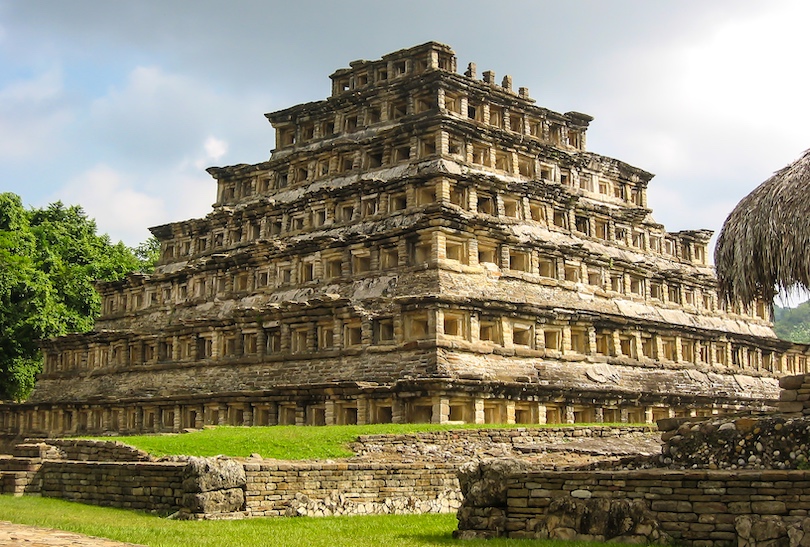
El Tajín was an important gulf coast city, founded by the Classic Veracruz culture. Most of the buildings at the site were constructed between 600 – 900 AD. Surrounded by the green jungle, these ruins are believed to have been the political and administrative center of the entire civilization.
Today, visitors can see more than 150 identified buildings, although just a dozen are restored and open to the public at any given time. Of note is the Pyramid of Niches, the most impressive structure at the site.
16. San Ignacio Lagoon
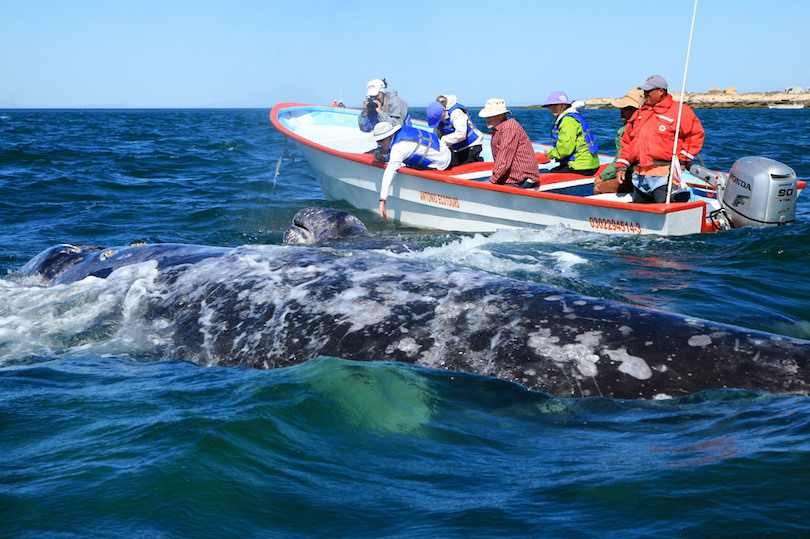
There are several places to go whale watching in Mexico, but none is so spectacular than San Ignacio Lagoon. Located off the coast of Baja California Sur, the lagoon is the winter home to a number of Eastern Pacific gray whales.
During the winter months, gray whales come to give birth in the shallowest parts of the lagoon. San Ignacio Lagoon is now Latin America’s largest wildlife sanctuary, and there are many guided boat tours that allow visitors to get up close and personal with the gray whales.
15. Bonampak Murals
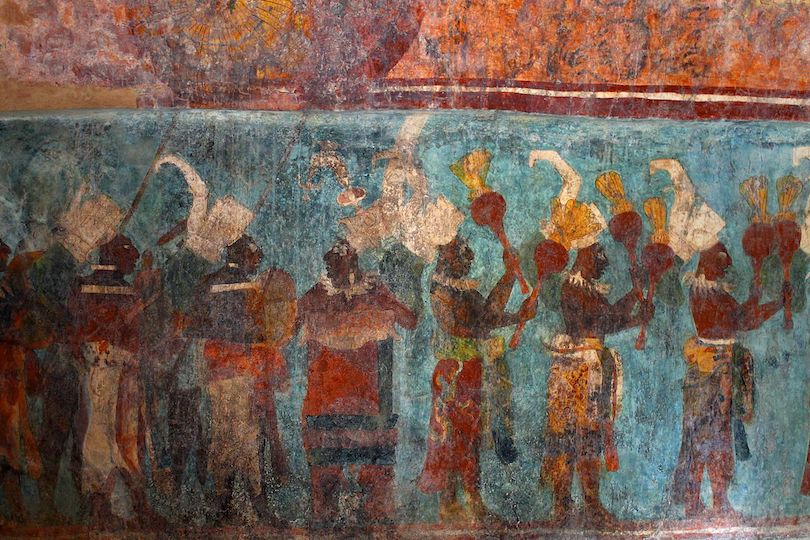
Bonampak is an ancient archeological site in the state of Chiapas. While there are many Mayan structures at Bonampak worth exploring, the most famous is the Temple of Murals. This temple is where the Bonampak Murals can be found, a collection of ancient art that helps explain the history and culture of the Mayans. Hundreds of figures were painted in three different rooms, each of which tells a part of a narrative in bold turquoise, red and yellow hues.
14. Isla Mujeres
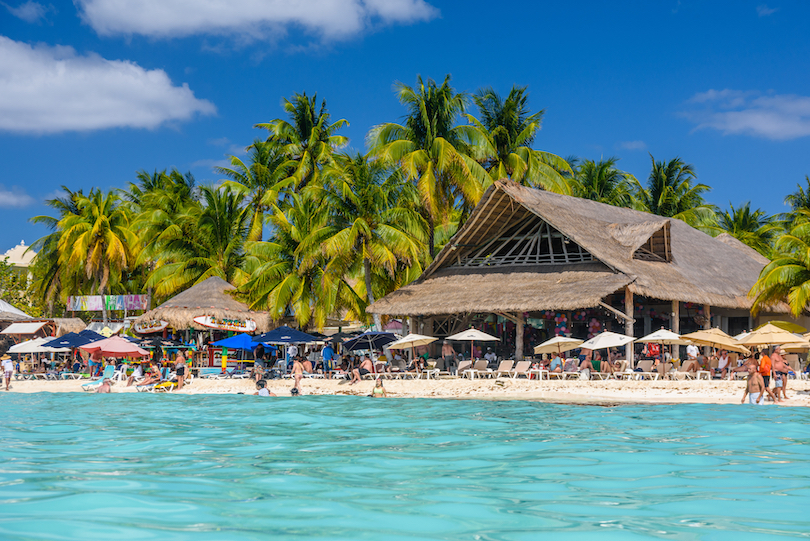
Surrounded by the blue waters of the Caribbean Sea, just eight miles from Cancun , is Isla Mujeres. This island is a hotspot today, but it also has significance for the region’s cultural heritage. Isla Mujeres, which translates to the island of women, was sacred to the Mayan goddess of childbirth.
Today, travelers arrive by ferry from Cancun to relax on the scenic beaches, visit the local turtle farm, scuba dive or snorkel in the clear waters or just relax away from the Cancun beach crowds.
See also: Where to Stay in Cancun
13. Santa Prisca Church in Taxco
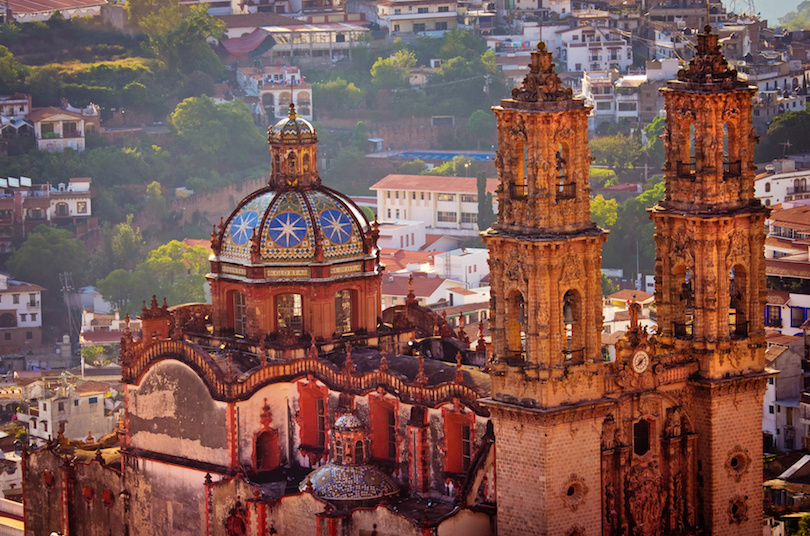
El Templo de Santa Prisca, or the Santa Prisca Church, is a magnificent Baroque structure located in the city of Taxco . Built in the 18th century, the church is a colonial landmark that was commissioned by a prosperous Spanish mine owner.
Made from pink stone, boasting large twin towers and decorated with tiles, this is an ornate monument that no architecture enthusiast would want to miss. Inside, nine enormous altarpieces stretch from the floor to the ceiling, and each is covered in gold.
12. Acapulco Cliff Divers
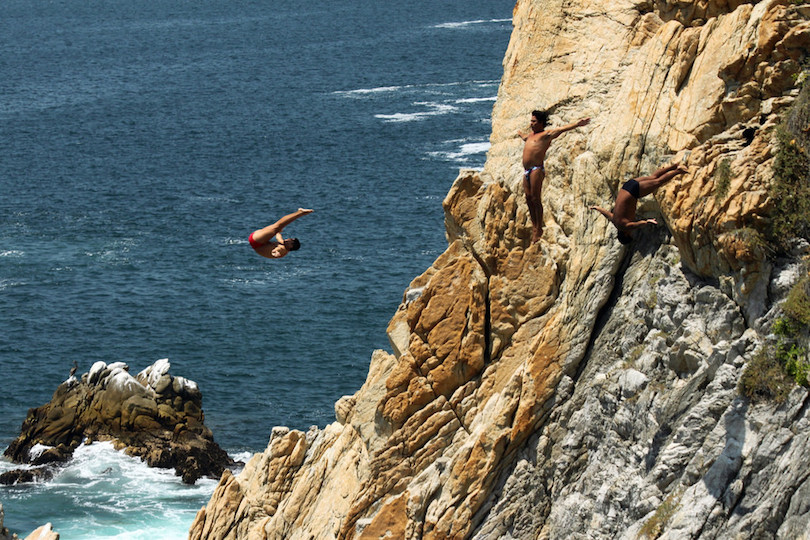
Acapulco is the original Mexican resort town which came into prominence by the 1950s as a getaway for Hollywood stars and millionaires. No visit to Acapulco is complete without watching the cliff divers perform their impressive jumps into ocean.
They have been doing it since the 1930s, although today the divers are professionals. You can see the dives from a small platform by the cliff for a small entrance fee, or eat at the La Perla restaurant which offers a good view of the divers.
11. Cenote Dos Ojos
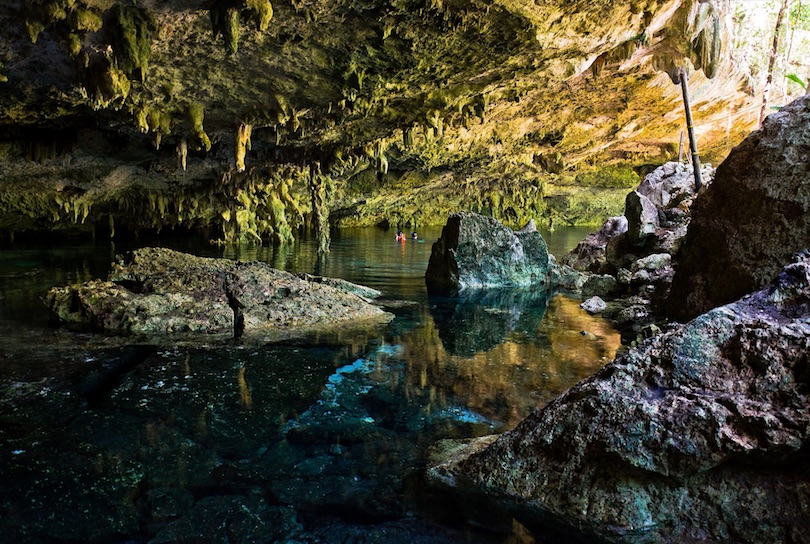
Just outside of Tulum is Cenote Dos Ojos, one of the country’s largest underwater cave systems. The name means the cavern of two eyes, referring to the two sinkholes connected by a long passageway.
The water in the caverns is filtered through limestone, making it exceptionally clear. As a result, Cenote Dos Ojos is wildly popular with both snorkelers and more serious scuba divers, some of whom head deep into the underwater cavern.
10. Catedral Metropolitana
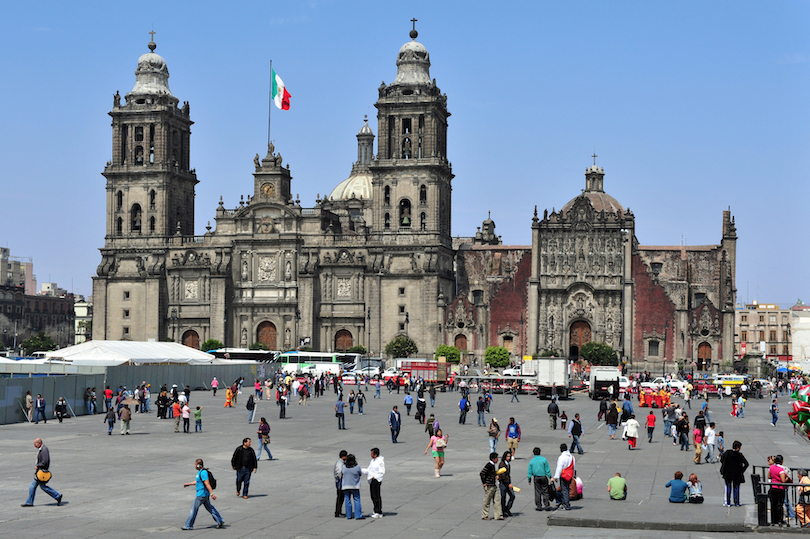
There is no shortage of things to do, see and explore in Mexico City, but a top attraction is unquestionably the Catedral Metropolitana. It is the oldest and the largest cathedral in Latin America, and the 16th century structure dominates the city’s central plaza, known as the Zocalo.
The architecture is a blend of styles, including heavy influences from baroque and Mexican churrigueresque design. In addition to the architecture, the Catedral Metropolitana boasts an extensive art collection as well as catacombs beneath the main structure.
See also: Where to Stay in Mexico City
9. Guanajuato
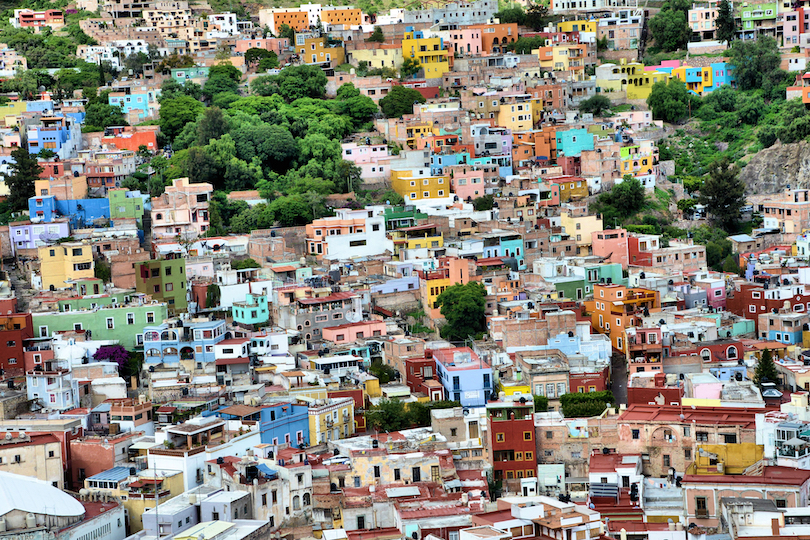
Nestled in the mountains of the Sierra de Guanajuato lies the beautiful colonial city of Guanajuato . The city was founded in 1554 next to one of the richest silver mining areas of Mexico. The 16th-century mining boom led to the construction of beautiful haciendas and fine colonial buildings.
Guanajuato streets and many colorful alleyways spread out in every direction while most of its traffic is served by a network of underground tunnels making it an excellent city for pedestrians.
8. Dias des los Muertos, Oaxaca
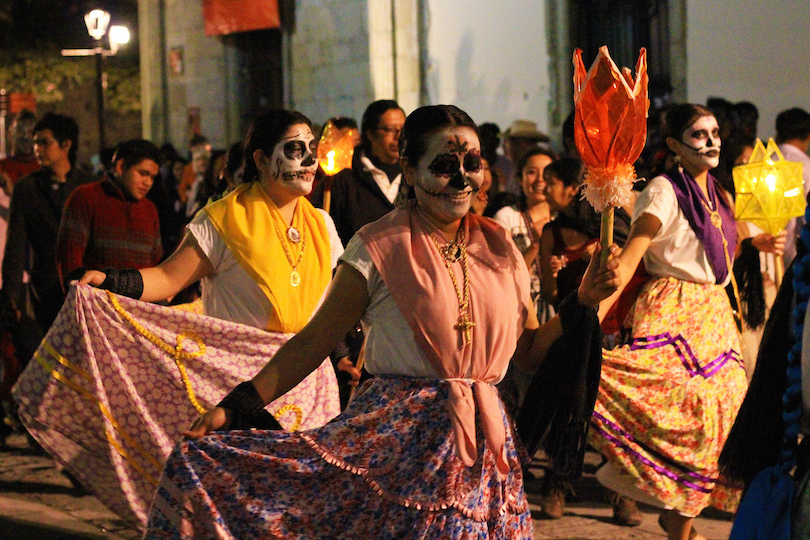
The city of Oaxaca is well-known for having one of the best Dia de Los Muertos festivals in Mexico, a holiday celebrated in many parts of Latin America. In Mexico the festival can be traced back thousands of years ago to indigenous cultures such as the Zapotec and Aztec.
In Oaxaca the Day of the Dead Festival starts at the end of October when families prepare the tombs for the return of the spirits. During this time tombs and home altars are decorated with flowers and families leave offerings for the spirits in the cemeteries.
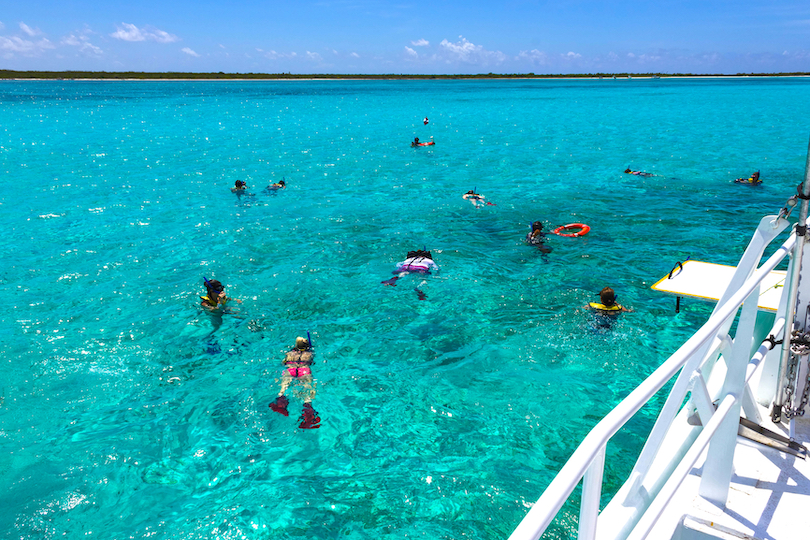
Located just off the Yucatan Peninsula, Cozumel is a popular destinations for scuba diving and snorkeling. The underwater world around Cozumel was discovered by Jacques Cousteau in 1959 who called it one of the best diving areas in the world. Since that time Cozumel has become a National Marine Park to protect the delicate balance of it’s beautiful coral reefs and amazing variety of tropical fish.
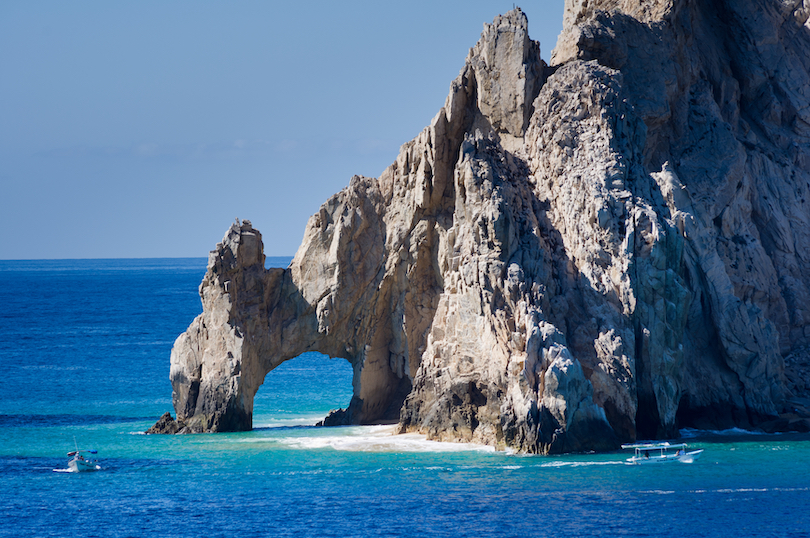
El Arco is an incredible arch found in Cabo San Lucas . This unique rock formation marks the spot where the Pacific Ocean becomes the Gulf of California. The arch has become an icon of Cabo San Lucas, and it can be viewed from several angles.
A stroll along the beach gives the opportunity for amazing pictures of El Arco, not to mention views of the blue waters, the gray whales that frequently frolic in the ocean and additional rock formations along the coastline.
5. Palenque

Palenque is an archaeological site that was located on the western edge of the Maya empire in the present-day state of Chiapas, Mexico . Palenque is much smaller than some of its Mayan neighbor cities, but it contains some of the finest architecture and sculptures the Maya ever produced. Most structures in Palenque date from about 600 AD to 800 AD including the Temple of Inscriptions, the only Mesoamerican pyramid built as a funerary monument.
4. Copper Canyon
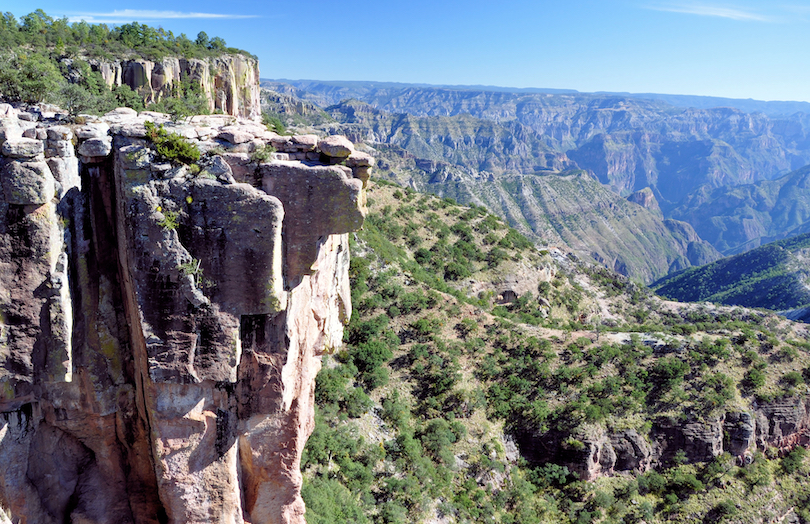
The Copper Canyon is in fact a network of canyons which together are several times larger than the Grand Canyon. The most popular way to explore the Copper Canyon is on the “Chihuahua al Pacifico” Railway. The track passes over 37 bridges and through 86 tunnels, rising as high as 2,400 meter (7,900 feet) above sea level featuring spectacular views of the canyons below.
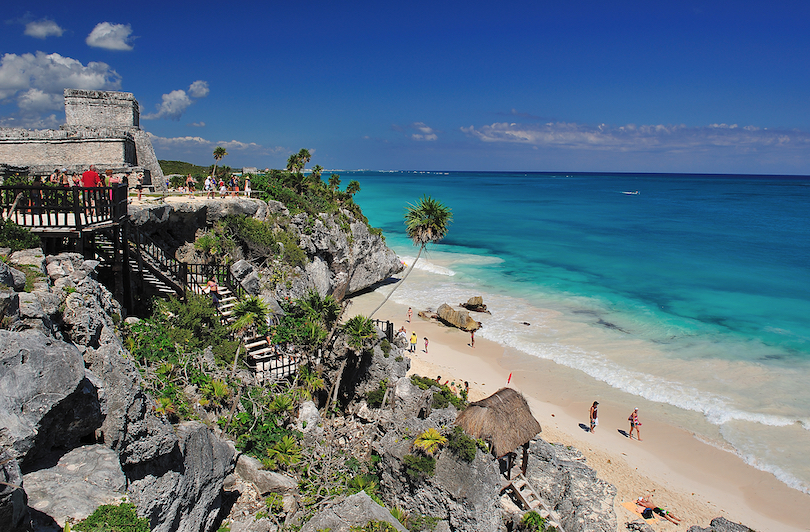
Tulum is situated on the east coast of the Yucatán Peninsula. It once served as the major port of the Mayan city of Coba. Tulum was built around 1200 AD when the Mayan civilization was already in decline and therefore lacks the elegance of some other famous sites.
The tropical beach backdrop however makes this a stunning top attraction which should not be missed. Accommodation in Tulum can range from simple cabanas to 5 star luxury resorts.
2. Chichen Itza
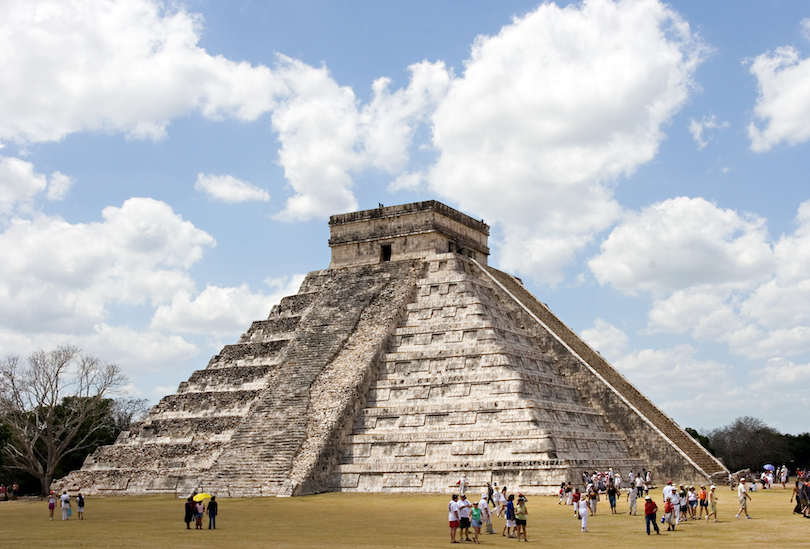
Chichen Itza is the largest of the Maya cities in the Yucatan Peninsula and one of Mexico’s most visited tourist destinations. The most famous landmark of Chichen Itza is the temple-pyramid of El Castillo. The design of the temple has special astronomical significance.
Each face of the pyramid has a stairway with 91 steps, which together with the shared step at the top, add up to 365, the number of days in a year. Other highlights of Chichen Itza include the Great Ballcourt and El Caracol, a circular temple which served as an astronomical observatory.
1. Teotihuacan

In the 2nd century BC a new civilization arose in the valley of Mexico. This civilization built the flourishing metropolis of Teotihuacán and it’s huge pyramids. The Pyramid of the Sun was built around 100 AD and is the largest pyramid in Teotihuacán and all of Mexico. The construction of the smaller Pyramid of the Moon started a century later and was finished in 450 AD.
Seven centuries after the demise of the Teotihuacán empire the pyramids were honored and utilized by the Aztecs and became a place of pilgrimage. Mesoamerica’s greatest city is just 31 miles (50km) northeast of Mexico City and can be reached by bus or taxi.
Map of Tourist Attractions in Mexico
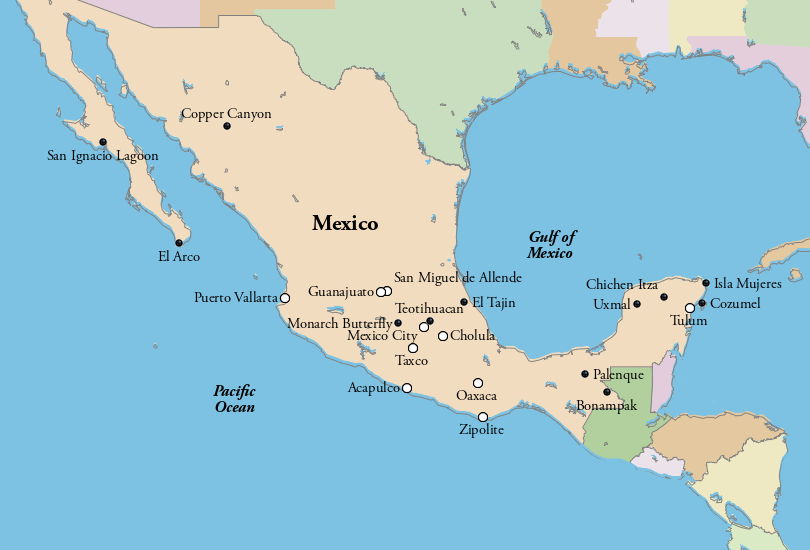
Share this post:
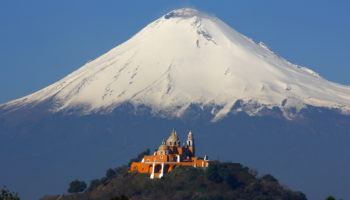
12 Most Amazing Volcanoes in Mexico
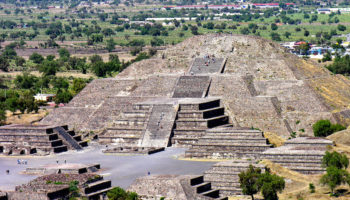
7 Most Amazing Pyramids in Mexico

10 Best All-Inclusive Resorts in Mexico
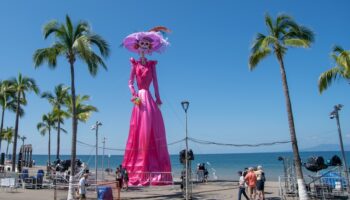
17 Best Places to Visit in Mexico
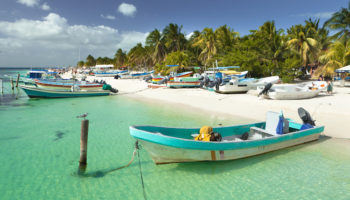
10 Best Beaches in Mexico
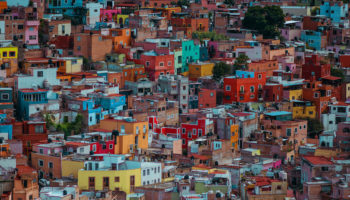
9 Most Beautiful Regions in Mexico
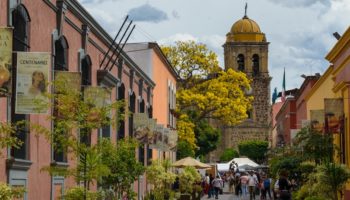
12 Prettiest Small Towns in Mexico
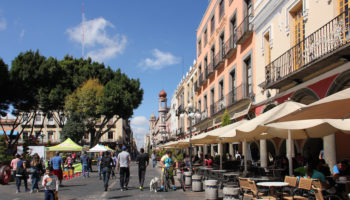
15 Best Cities to Visit in Mexico
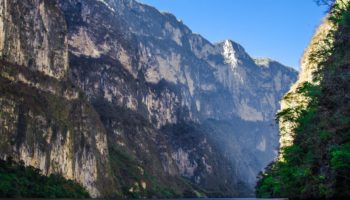
15 Most Beautiful National Parks in Mexico
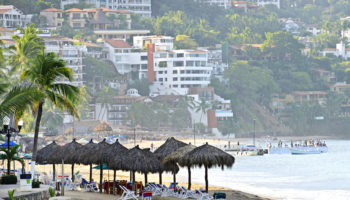
10 Best Vacation Spots in Mexico
Reader interactions.
June 17, 2019 at 2:08 pm
Acapulco with all its problems is still absolutely gorgeous and always has been. It’s ashamed they don’t protect it more.
February 5, 2017 at 7:41 pm
Monarch butterfly is pretty good place to visit mostly during February and March
August 22, 2016 at 9:21 am
We just went this summer to Teotihuacan, it was awesome!!! We have been to Mexico 5 times in the last 15 years but this is the first time we have gone anywhere besides visiting my husband’s family. We need to see some of these other places also someday!!!
March 31, 2016 at 1:41 pm
Don’t forget Uxmal ruins, much more beautiful than Chichen Itza in my opinion.
October 28, 2014 at 8:59 pm
What about Guadalajara?!
March 17, 2014 at 1:51 pm
This is a great list of attractions in Mexico. Those who are visiting should consider trying to visit at least a couple of these during their vacation.
February 26, 2013 at 11:41 pm
Attractive Pictures, makes one feel like Catching a Plane immediately to few destinations as above. Good Luck to the people from Touropia who made the research. Thanks and best regards. Raj
January 23, 2013 at 2:42 pm
Excellent research! This is a wonderful resource for travellers to the region.
November 13, 2012 at 3:51 pm
Nice job on the tourist attractions! They are beautiful and acurrately correct. This also helped me very much on my project about Mexico. So thank you so so so much!!!!!!!!!! The only flaw is the paragraph about Palenque because where it says Palenque is much smaller than it Mayan neighbor cities, “it” is supposed it’s.
August 19, 2012 at 4:50 pm
Guanajuato is really an amazing little city, happy to see it made the list!
January 31, 2012 at 12:40 pm
Chichen Itza is a beautiful place ! I was there viewing the temple pyramid . It is amazing ! You should visit , xoxo Day Day
August 31, 2011 at 12:53 pm
Acapulco and Tulum have beautiful beaches. I was there watching the cliff divers jump into the see. Awesome. But cozumel will make you fall in love with the underwater.
Leave a Reply Cancel reply
Your email address will not be published. Required fields are marked *
This site uses Akismet to reduce spam. Learn how your comment data is processed .
- Search Please fill out this field.
- Manage Your Subscription
- Give a Gift Subscription
- Newsletters
- Sweepstakes
- Destinations
24 Most Beautiful Places in Mexico
From charming small towns to stunning islands, these are the most beautiful places to visit in Mexico.
:max_bytes(150000):strip_icc():format(webp)/Lauren-Dana-Ellman-1cd58a16cf194beaad4749c08ba31269.jpeg)
shalamov/Getty Images
Beautiful beaches, ancient ruins, rugged landscapes, and colorful cities galore: Find all this and more in Mexico. While our neighbor to the south is teeming with awe-inspiring locales, narrowing down which are worth a spot on your must-see list can be tricky, especially considering how vast the country is. For this reason, working with someone with in-depth knowledge of the country and its many regions is crucial, says Zachary Rabinor, a T+L A-List Travel Advisor specializing in Mexico and the founder of Journey Mexico . According to the pro, these individuals can offer valuable insights and recommendations based on your interests and preferences, whether that’s searching for the best street food, securing a coveted dinner reservation, or arranging a private driver to take you to and from Mexico’s most iconic attractions.
Ready to start planning your Mexico escape? Travel + Leisure can help: From hidden-gem beaches and mountain towns to world-famous archaeological sites and major metropolises, we’ve rounded up 24 of the most beautiful places in Mexico, according to experts.
El Pescadero, Baja California Sur
Cavan Images/Getty Images
Rabinor describes El Pescadero as a “hidden gem along the Pacific Coast,” just an hour’s drive from Cabo San Lucas . The small farming community boasts gorgeous swaths of sand — most notably, Cerritos — which, per the pro, are “ideal for surfing and sunbathing.” Rabinor also tells T+L that no trip here is complete without stopping at Barracuda Cantina (conveniently located just steps from Cerritos) to try the Baja fish tacos.
Todos Santos, Baja California Sur
Marc Romanelli/Getty Images
Just eight miles north of El Pescadero lies the town of Todos Santos , which, according to Rabinor, is renowned for its thriving arts scene and colorful colonial architecture. If that’s not enough to wow you, then the pristine beaches, such as Punta Lobos and Playa La Cachora, definitely will. Rabinor also describes Todos Santos as “a foodie’s paradise” — his personal picks include Docecuarenta “for some of Baja’s best roasted coffee and freshly baked pastries;” Jazamango , a farm-to-table restaurant led by one of Mexico’s renowned chefs, Javier Plasencia; and “fresh oysters at Oystera .”
Oaxaca City, Oaxaca
Mardoz/Getty Images
Oaxaca was named the best city in the world in T+L's 2022 World's Best Awards — and it’s easy to see why. What’s more, says Rabinor, this colorful, vibrant city is renowned for its 17th-century architecture, buzzy downtown area, rich Indigenous heritage, and artisan communities. The greenery-filled Jardín Etnobotánico de Oaxaca and the 18th-century Oaxaca Cathedral are also must-visit spots. And, if all of the above weren’t enough to lure you in, then the food and drink scene — famous for its mezcal and moles — certainly will.
La Paz and Isla Espiritu Santo, Baja California Sur
MattGush/Getty Images
According to Rabinor, the capital of Baja California Sur beckons travelers with its “tranquil beaches, Malecón waterfront promenade, and the opportunity to swim with gentle whale sharks.” Plus, says Rabinor, no trip here is complete without a boat ride to the breathtaking Isla Espiritu Santo. A UNESCO World Heritage Site , this small rocky island is known for its secluded beaches and excellent snorkeling and kayaking opportunities — and you may even spot some playful sea lions.
Mexico City, State of Mexico
Jorge Castro/Travel + Leisure
According to Rabinor, Mexico’s capital city “seamlessly blends cosmopolitan vibrancy with a rich Indigenous past and history.” He also goes on to describe the cityscape itself as “a fascinating tapestry of old and new — soaring modern skyscrapers stand alongside meticulously preserved colonial architecture.” Must-visit attractions include Templo Mayor, Palacio de Bellas Artes, Castillo de Chapultepec, and The Pyramids of Teotihuacan (but more on those a bit further down).
Isla Holbox, Quintana Roo
This idyllic island — known for its gorgeous natural surroundings, including powdery white-sand beaches and shallow turquoise waters — is about three hours from Cancun . “Holbox exudes a relaxed and laid-back vibe with car-free and unpaved sandy streets, making it the epitome of a barefoot chic vacation,” says Rabinor. The island, part of the Yum Balam Nature Reserve, is home to abundant marine life and birds, including whale sharks, flamingos, herons, dolphins, and manta rays. For the ultimate adventure, book a bioluminescence kayak tour.
Merida, Yucatán
S. Greg Panosian/Getty Images
Hope Smith, a travel advisor at Montecito Village Travel , a Virtuoso Agency, tells T+L that some of the richest displays of Mexican culture can be found in Merida , “a city full of wonderful food, beautiful mansions, haciendas, and lush gardens.” Additionally, she says, “You will also find historic Mayan archaeological sites, including Uxmal, La Ruta Puuc, and Chichén Itzá.” For a stay just as eclectic as the city itself, Smith recommends Chablé Yucatán , which she describes as a “five-star experience in a hacienda-style setting.”
Morelia, Michoacán
Arturo Peña Romano Medina/Getty Images
“History enthusiasts will fall in love with Morelia, Michoacán, a UNESCO World Heritage Site surrounded by lake and mountain views,” says Smith. That’s because it’s chock-full of centuries-old architecture, with the landmark Morelia Cathedral being one of its most famous attractions. Travelers can also carve out an afternoon to explore nearby towns like Pátzcuaro, which, per Smith, is home “to one of the largest plazas in Mexico and great local art shops.”
Puerto Escondido, Oaxaca
Alex Borderline/Getty Images
According to Fora travel advisor Natalie Stegman , this under-the-radar Oaxaca beach town is known for its beaches, surfing, and laid-back atmosphere. Here, you’ll find a stretch of sand for every type of traveler, be it bustling Zicatela Beach, which has an abundance of waterfront bars and cafes; the scenic Playa Carrizalillo, where you’ll find golden sand, swaying coconut palms, and turquoise waters; and the tranquil Playa Manzanillo, which, with its calm waters, is perfect for families. And, per Stegman, no trip is complete without taking a detour to nearby Playa del Palmarito, one of the largest turtle nesting beaches along the Mexican Pacific Coast (just note that nesting season takes place between July and January). After a fun-filled day in the sun, rest your head at Casona Sforza (located directly on the beach) or Hotel Terrestre (where each of the 14 villas has a private pool ).
San Miguel de Allende, Guanajuato
Anna Haines/Travel + Leisure
“With its unique blend of Mexican culture and European influences, San Miguel de Allende is a visual masterpiece that will capture your heart,” says Fora travel advisor Elizabeth Kaczka . The city — a UNESCO World Heritage Site — is home to well-preserved buildings adorned with colorful facades and intricate details, which, per Kaczka, “create a picturesque setting.” She also recommends leaving ample time to wander the cobblestone streets, visit the pink-hued Parroquia de San Miguel Arcángel, and explore the local arts and shopping scenes. And, despite the destination’s charming small-town vibe , it’s teeming with top-rated hotels ranging from the ultra-luxe Rosewood San Miguel De Allende to the boutique Casa Delphine .
Valle de Guadalupe, Baja California Sur
cesar fernandez dominguez/Getty Images
According to Fora travel advisor Swaylah Faroqi , Valle de Guadalupe is considered the premier wine-producing area of Mexico — hence why it’s referred to as Mexico’s very own Napa Valley. Per the travel pro, the region has also “gained international recognition for its high-quality wines and stunning landscapes.” Splurge on a stay at the recently opened Montevalle Health & Wellness Resort . This luxury adults-only all-inclusive resort, set on 10 hectares of land dotted with olive trees, lavender plants, and vineyards, offers villa accommodations and state-of-the-art wellness facilities such as a spa, meditation labyrinth, and reflexology path.
Bacalar, Quintana Roo
loeskieboom/Getty Images
The aptly named town of Bacalar is located on Lake Bacalar (sometimes called Bacalar Lagoon) and is known as The Lake (or Lagoon) of Seven Colors for its vibrant shades of blue. “Take a boat ride across the lagoon, visit the cenotes that dot its shores, or simply relax in a hammock while gazing at the mesmerizing hues of the water,” says Kaczka. The destination is home to a handful of unique boutique hotels like Boca de Agua and Habitas Bacalar ; meanwhile, Banyan Tree Vega Bacalar — which will feature a spa designed to resemble a cenote, 35 suites, and an overwater restaurant — is slated to open its doors in 2025.
Islas Marietas National Park, Nayarit
ferrantraite/Getty Images
Accessible only by boat, Islas Marietas National Park is about one hour from Puerto Vallarta and 15 minutes from Punta Mita. These uninhabited islands are home to abundant marine life, including dolphins, manta rays, and tropical fish galore. As such, they’re especially popular for snorkeling, explains Fora travel advisor Nadia Bess . It’s also here where you’ll find an Instagram-famous hidden beach inside a cave .
Tepoztlán, Morelos
©fitopardo/Getty Images
“ Situated just a few hours outside of Mexico City, Tepoztlán is similar in feel to San Miguel de Allende but is not as well known,” says Fora travel advisor and co-founder Henley Vazquez . She continues, telling T+L, “It’s designated as a ‘Pueblo Mágico,’ which means it is sacred to Mexican culture.” This charming mountain town is also home to El Tepozteco, an ancient Aztec temple dedicated to Ometochtli-Tepoztēcatl, the god of pulque (an alcoholic beverage), fertility, and drunkenness.
Sumidero Canyon, Chiapas
The Sumidero Canyon was carved by the Grijalva River and dates back 35 million years. Here, you’ll find 3,000-foot-tall rock walls, lush vegetation, and cascading waterfalls. Fora travel advisor Sara Wilcox recommends booking a scenic boat tour for the best views of the canyon. And, if you’re lucky, you may spot majestic wildlife like spider monkeys, crocodiles, jaguars, and snakes.
Las Coloradas, Yucatán
Karliux_/Getty Images
Located on the tip of the Yucatán Peninsula — about 3.5 hours from Tulum and the Riviera Maya — Las Coloradas is an Instagram dream come true with its pink-hued waters. (According to Wilcox, this is due to a high concentration of red-colored algae and shrimp.) ”The beautiful pink tones continue thanks to a large population of flamingos, which are attracted to the salt ponds,” says the travel advisor.
Cabo Pulmo, Baja California Sur
MartinaPal/Getty Images
“Home to one of the most diverse coral reefs in North America, this National Marine Park is truly spectacular,” says Fora travel advisor Amy Shamus of Cabo Pulmo. In addition to pristine beaches, the UNESCO World Heritage Site boasts a coral reef-filled shallow bay that hundreds of marine species call home, including but not limited to sea turtles, humpback whales, manta rays, and whale sharks. With all this in mind, it’s no surprise that diving, snorkeling, and swimming are so popular here.
Suytun Cenote, Yucatán
Simon Dannhauer/Getty Images
Cenotes are natural swimming holes that are considered sacred by the Maya. And, while the Yucatán Peninsula boasts several thousand cenotes — each of which is nothing short of awe-inspiring — Suytun Cenote is amongst the most picture-perfect with its circular platform, which makes the perfect setting for your photo. Post-picture, enjoy a refreshing soak in the crystalline waters and take a moment to bask in the subterranean surroundings, with fascinating stalactites and stalagmites from nearly every angle.
Hierve El Agua, Oaxaca
Msznz/Getty Images
Whether you choose to hike, swim, or just sit back and admire the natural formations, a trip to Hierve El Agua is truly one for the books. “This absolutely gorgeous historical and natural site is roughly an hour outside of Oaxaca and features travertine rock formations, a petrified waterfall, and multiple natural warm pools, all overlooking jaw-dropping views of the valley below,” says Bess. If you don’t mind waking up early, the travel pro recommends arriving here “just before sunrise” so that you can soak up the gorgeous views and have the place “(almost) all to yourself!”
Teotihuacan Pyramids, State of Mexico
benedek/Getty Images
These ancient pyramids, which are thought to date back to 100 B.C.E., are just one hour from bustling Mexico City. Its main attraction, the Pyramid of the Sun, clocks in at over 215 feet tall. According to Bess, those who truly want to appreciate the pyramids’ vast size and beauty should take a sunrise hot air balloon ride over them.
Playa del Carmen, Quintana Roo
Itzel Garrido/Travel + Leisure
“ Nestled along the Caribbean Sea, Playa del Carmen is a tropical paradise that entices visitors with its turquoise waters and powdery white-sand beaches,” says Kaczka. Beyond the beaches, travelers can choose from an array of activities, be it swimming in cenotes, exploring ancient Mayan ruins, or dancing the night away in one of the clubs that line Quinta Avenida (Fifth Avenue, Playa del Carmen’s main strip). The town also boasts an abundance of hotels and resorts , which include some of Mexico’s best all-inclusive resorts.
Guanajuato, Guanajuato
As the capital of the eponymous Mexican State, Guanajuato — a UNESCO World Heritage Site — attracts travelers with its breathtaking architecture and art. You can easily spend hours wandering the quaint cobblestone alleys adorned with vibrant buildings and ornate plazas. Some of Kaczka’s must-dos: Explore the famous Callejón del Beso (Alley of the Kiss), visit the majestic Basilica of Our Lady of Guanajuato, and immerse yourself in the lively atmosphere of the city's numerous festivals.”
Chichén Itzá, Yucatán
Gerard Puigmal/Getty Images
Chichén Itzá is one of the most famous archaeological sites in Mexico, and best of all, it’s an easy day trip from Cancun . These ancient Mayan ruins span about four square miles, and the massive El Castillo (also known as the Temple of Kukulcan), which towers over the other monuments at 78 feet, is arguably the most famous of the bunch. The Great Ballcourt features intricate stone carvings, as does the Temple of the Warriors. Don’t miss the Wall of Skulls, where you’ll find hundreds of, yes, stone skull carvings.
Copper Canyon, Chihuahua
jejim/Getty Images
Also known as the Grand Canyon of Mexico, Copper Canyon is comprised of not one but six separate canyons. This natural wonder, a UNESCO World Heritage Site, encompasses over 25,000 square miles in the Sierra Madre Occidental mountain range. While many choose to experience Copper Canyon and its postcard-worthy surroundings on foot or horseback, those aren’t the only options. Instead, says Kaczka, “Hop aboard the Chihuahua al Pacífico railway, also known as the Copper Canyon Train, for a scenic journey through rugged landscapes, towering cliffs, and picturesque villages.”
Related Articles

37 Best Places to Visit in Mexico You’ll Love
By: Author Amanda OBrien
Posted on Last updated: 16/02/2024
Nestled in the southern portion of North America, Mexico is a long-standing favourite vacation destination. This vibrant country is home to rich culture with an intriguing mix of native traditions and Spanish influences.
In Mexico, you’ll come across an abundance of stunning scenery, beautiful beaches, awe-inspiring architecture, cultural attractions, and historical landmarks. There is so much to explore in the country, but a few spots certainly deserve to be on your bucket list.
To help you compile the perfect travel itinerary when touring Mexico, I’ve highlighted the best destinations for an unforgettable trip. From resort towns to natural attractions, you can find them all below.
37 Best Places to Visit in Mexico
Whether you’re looking to visit a breathtaking beach vacation spot or explore a historic city, you’ll find a variety of diverse destinations in Mexico. Here are the top spots that you should visit.
1. Mexico City
Mexico City is one of the most popular travel destinations in the country. If you’re a culture-loving adventurer looking for an affordable trip, visiting this capital city would be perfect for you.
Tourists flock to the city for its lively atmosphere, renowned arts, delicious cuisine, and vibrant cultural scene. A stroll in the downtown area will allow you to experience the city’s colonial-style architecture and intriguing past.

Some of the top attractions and famous landmarks in the city include the Frida Kahlo Museum, Museo Nacional de Antropologia, and Mexico City Metropolitan Cathedral. Another must-visit location is the Palacio de Bellas Artes. It is a notable cultural centre in the city that has hosted esteemed events in music, theatre, dance, opera, and literature.
Located on the Caribbean coastline of Yucatán Peninsula, Tulum is a must-visit location. This ancient city boasts well-preserved Mayan ruins and beautiful white sand shores with turquoise waters.
After soaking up the sun at the beach, you can tour the Tulum Archaeological Site, where you’ll learn more about the area’s fascinating history. For more spectacular experiences in the area, check out Playa Paraiso, Cenote Calavera, Coba Ruins, and Sian Ka’an Biosphere Reserve.

Tulum offers spectacular experiences with a range of accommodation options. Whether you want to stay at a 5-star resort or beachside bungalow, there are plenty of options to fit your taste.
Don’t Miss my Post on 33 Fantastic Things to do in Tulum .
3. Cabo San Lucas
Cabo San Lucas is one of the top beach destinations in Mexico. This resort city is situated on the southern tip of the stunning Baja California Peninsula. Here you’ll come across several beautiful beaches and scuba diving locations.
Some of the marine life you can expect to see in the dazzling waters include striped marlin, stingrays, and mahi-mahi. When visiting, be sure to check out the Arch of Cabo San Lucas, El Medano Beach, Playa del Amor (Lovers Beach), and Mt. Solmar for a fun outing.

In Cabo, you’ll also find numerous world-class resorts and deluxe villas. A few of the best resorts include the Villa del Palmar Beach Resort , Hotel Tesoro Los Cabos , and Riu Palace Cabo San Lucas .
Oaxaca is a vibrant destination that offers a taste of the real Mexico. It comprises a fascinating mix of native Indian and Spanish elements and has remained mostly untouched throughout the years. As such, it has maintained much of its natural beauty.

This unspoiled city is home to plenty of captivating old architecture. Here you’ll also come across several weekly markets, colourful fiestas, and a vibrant art scene. Other must-see attractions include the UNESCO-listed Historic Centre of Oaxaca and the nearby Monte Alban.
Don’t Miss my post on 23 Must-See Landmarks in Mexico .
5. Copper Canyon
If you’re looking for a destination that’s rich in biodiversity and cultural history, the Copper Canyon is certainly worth visiting. Nestled in northern Mexico, you can find this group of deep canyons in the Sierra Madre Occidental mountains.

This renowned natural attraction gets its name from the distinctive copper-green colour of the canyon walls. When visiting this scenic destination, you can enjoy several activities, including hiking, zip-lining, and horseback riding.
One of the best ways to explore the area is aboard the Ferrocarril Barrancas del Cobre (Copper Canyon Railway). On this scenic trail ride, you’ll have stunning views of tropical valleys, alpine forests, and rocky landscapes of the canyons.
You might enjoy reading my article on Mexico Fun Facts.
6. Cancún
Cancún is a lively resort and beach destination located on the eastern edge of the Yucatan Peninsula. The bustling city attracts countless travellers each year and is a popular spring break holiday destination among university students.

There are plenty of fun things to do in this city, including snorkelling, jet skiing, and swimming among reefs and tropical fish. Another exhilarating experience is exploring the Cancún Underwater Museum . Here you’ll come across a stunning collection of sculptures submerged in water that will leave you in awe.
7. Guanajuato
Nestled in central Mexico, Guanajuato is renowned for its silver mining history and stunning colonial architecture. The historic city was founded in the early 16th century and became a UNESCO World Heritage Site in 1988.
Today, it’s a charming vacation spot that offers spectacular experiences. If you’re looking for a central location to tour the city, the Jardin de la Union plaza is ideal. It’s the perfect location to explore the winding lanes and tunnels on foot.

You’ll also find numerous fine art galleries, intriguing museums, and an abundance of architectural gems. Some notable attractions to check out include the Museum of the Mummies of Guanajuato, Juarez Theater, and the Basilica of Our Lady of Guanajuato.
8. Puerto Vallarta
Located on the Pacific coast in Jalisco state, Puerto Vallarta promises exceptional experiences for those looking for a beach holiday. There are plenty of enjoyable water activities for every kind of traveller.

Whether you want to swim with the dolphins or relax on a luxury yacht sightseeing tour , adventure is abundant in the sparkling sea. In addition to the city’s stunning shores, you’ll find several boutique stores and a range of restaurants along the cobblestone streets. When touring the city, be sure to visit the Puerto Vallarta Pier, Los Muertos Beach, and Parroquia de Nuestra Señora de Guadalupe.
Cozumel is a popular Mexican island located just off the Yucatan Peninsula. It is an ideal destination for sun-seekers wanting to explore the magnificent marine life found in the Caribbean Sea.

Cozumel is renowned for its scuba diving spots around its coral reefs. You’ll also find diverse marine life such as manatees, sea turtles, and dolphins in the glistening waters.
A few of the top beaches on the island include Palancar Beach, Paradise Beach, and Playa Punta Morena. Other notable attractions in the area are Zona Arqueológica San Gervasio, Discover Mexico Park, and Punta Sur Ecological Beach Park.
If you want to discover the magnificent Mayan sites in Yucatan, Merida is the place to be. In the city, you can easily access historical attractions such as the Chichen Itza and Tulum.
This capital city is one of the most outstanding old colonial areas in Mexico. Merida is known as the “white city” due to its collection of white stone mansions. While it is called the white city, Merida is a truly colourful and vibrant place, filled to the brim with rich culture and history.

You’ll find eye-catching European influences with French architecture in the area. And there are plenty of admirable places to visit, such as the Mayan World Museum of Merida, Paseo de Montejo, and Plaza Grande.
11. Chichen Itza
The spectacular Chichen Itza is one of the most visited archaeological sites in Mexico. You’ll find this massive and well-restored site situated on the Yucatan Peninsula.
The ancient city is home to magnificent structures that have been around for thousands of years. Chichen Itza thrived from around 600 A.D. to the 1200s. Today, it is visited by countless travellers seeking to experience the rich Mayan culture.

One of the most popular points of interest in the area is the massive step pyramid, El Castillo (Temple of Kukulkan). Many travellers enjoy a Chichen Itza day trip to this magnificent location during their stay in Merida, Cancun, or Playa del Carmen.
12. San Miguel de Allende
San Miguel de Allende is a colonial-era city nestled amongst central Mexico’s Sierra Madre Mountains. It is known for its Colonial and Spanish architecture and visual arts.
This city features a romantic atmosphere and is perfect for couples. It’s also a top spot for travellers looking to explore the thriving art scene, music, food, and culture festivals.

In the historic city centre, you can enjoy strolls through the 500-year-old narrow walkways. Along the way, you’ll find plenty of artisan shops that sell stunning jewellery, crafts, and handmade accessories. Other top spots to visit include the Parroquia de San Miguel Arcángel, Fábrica la Aurora, and Charco Del Ingenio.
13. Morelia
Located in the central state of Michoacán, Morelia is a delightful place to explore in Mexico. Here you’ll find more than 200 well-preserved historic buildings from the 17th and 18th centuries.
Additionally, the colonial city’s downtown area has been designated as a UNESCO World Heritage Site. The picturesque Plaza de Armas is a great starting point to explore the city on foot.

In this large public space, you can easily access several restaurants, cafes, and shopping spaces. There are also spectacular sightseeing opportunities, from statues of revolutionary heroes to scenic gardens.
14. Acapulco
Acapulco is a renowned beach resort town situated on the Pacific coast. In the 1950s, it was a popular getaway destination in Mexico. And today, this iconic spot is making a comeback with increasing popularity as a vacation destination for travellers seeking a lively atmosphere.

Acapulco is best known for its beautiful beaches and vibrant nightlife. So, if you’re a beach bum or party lover, this epic location is certainly worth visiting. It is also a popular getaway for spring breakers and those looking to indulge in international cuisine.
15. Guadalajara
Guadalajara is a fun city located in western Mexico. It is the capital of the state of Jalisco, where mariachi music and tequila were born. Guadalajara is the second-largest city in the country, and there are plenty of exciting things to do here.

The city’s historic centre is filled with colonial plazas and famous landmarks, including the Teatro Degollado, Palacio del Gobierno, and the Baroque Guadalajara Cathedral. Additionally, you can discover the vibrant Mexican culture all around the city. From the mariachi music to the delicious foods, Guadalajara offers an enjoyable experience for all.
Situated in east-central Mexico, Puebla is renowned for its colonial architecture, pottery, and culinary history. Here you’ll come across an extensive display of awe-inspiring pre-Hispanic art that includes mural fragments and ceramics.
If you’re looking for a getaway filled with rich traditions and eye-catching arts, exploring Puebla is a great choice. There are several attractions in the area that are worth visiting such as the Zona Arqueologica de Cholula, Catedral de Puebla, and Museo Amparo.

Puebla is also well-known for its sweet and spicy cuisine. One of the top dishes to try is Mole Poblano. This traditional Mexican dish is made with delicious ingredients, including chocolate, chilis, fruits, nuts, and seeds.
17. Zacatecas
If you’re looking for a Mexican getaway with fewer crowds, Zacatecas is the perfect place to visit. This spectacular state is located in north-central Mexico. It is home to a rich heritage that you can experience through the local foods and captivating cultural sites.

A notable landmark in the area is the La Quemada archaeological site. At this massive pre-Columbian hilltop settlement, you’ll come across a magnificent museum, pyramid and columns. More must-visit attractions for art enthusiasts are the Museo Pedro Coronel and the 16th-century mine, El Eden.
18. San Cristóbal de las Casas
San Cristóbal de las Casas is situated in the state of Chiapas. It features a combination of Mayan culture and colonial architecture.

The highland town features a combination of Mayan culture and colonial architecture, which includes the yellow San Cristobal Cathedral. When touring the downtown area, be sure to check out the Centro de Textiles del Mundo Maya. At this striking museum, there are several breathtaking displays of colourful, traditional textiles and historical exhibits.
19. Todos Santos
Todos Santos is located at the foothills of the Sierra de La Laguna Mountains on the Pacific coast of Baja California Peninsula in Mexico. This charming vacation spot offers both warm hospitality and weather for a well-deserved getaway.

Todos Santos is a haven of natural beauty and an excellent option for adventure-seeking travellers. Many individuals are attracted to this location for its arts, healthy lifestyle, and surfing opportunities.
You’ll find many beautiful beaches in the town as well as art galleries. Some of the top spots to visit include Los Cerritos Beach, Punta Lobos, and Casa de la Cultura Profr Nestor Agundez.
20. Cabo Pulmo
Cabo Pulmo is one of the best places to visit in Mexico for epic scuba diving experiences. This protected National Marine Park is located on the east coast of the Baja California Peninsula, spanning between Pulmo Point and Los Frailes Cape.

At Cabo Pulmo, you can rediscover the dazzling beauty of the underwater world. You can expect to see an abundance of horse-eye jacks and triggerfish, as well as black coral bushes. Larger marine life that you might spot includes whale sharks and spy hammerhead sharks.
21. Costa Maya
If you’re seeking an intimate holiday with quiet beaches, Costa Maya promises a peaceful stay. This stretch of the Caribbean coast is situated on the eastern Yucatan Peninsula in Mexico. Here you’ll find quaint fishing villages, spectacular scenery, and a laid-back atmosphere.

There are also exceptional diving sites for those looking for some extra adventure. Some of the best places to visit in the area include Mahahual Beach, Costa Maya Port Mexico, and Maya Lost Mayan Kingdom.
22. Riviera Nayarit
The Riviera Nayarit is a nearly 322 kilometre stretch of sandy shores and charming villages north of Puerto Vallarta. Natural beauty is abundant in Riviera Nayarit, making it one of the top places to visit in the country. The most popular cities in Riviera Nayarit include Sayulita, Bucerias, and Nuevo Vallarta.

If you want to catch some waves or watch the best sunsets , there are plenty of breathtaking beaches in the area. Some of the best unique beaches to visit are Sayulita Beach, Playa San Pancho, and Nahui Beach.
23. The Monarch Butterfly Biosphere Reserve
The Monarch Butterfly Biosphere Reserve, or Reserva de la Biósfera Santuario, is a beautiful nature preserve in Mexico. You’ll find this breathtaking biosphere within the rugged forested mountains northwest of Mexico City. It supports the wintering habitat of the gorgeous monarch butterfly.

This picturesque site is a must-see for outdoor enthusiasts, especially during the annual migration and overwintering of the monarch butterfly. Popular months to visit to witness these phenomenal golden-orange butterflies are between mid-November and mid-March.
24. Volcan Paricutin
If you’re looking to climb a volcano, Paricutin is certainly worth checking out. It is a cinder volcano in the state of Michoacan. Paricutin is the youngest volcano in the world and gained popularity after it surged in 1943.

This dormant volcano stands at around 2,800 metres in elevation and offers an exhilarating climb. Here you’ll walk through the scenic forest before making your way over a sea of lava rocks. Once at the top, the stunning vistas will leave you in awe.
25. Isla Espiritu Santo
Isla Espiritu Santo is a stunning island that offers a relaxing escape in Mexico. You can find this protected ecological reserve located in the Gulf of California off Baja California Sur. A day trip to the island promises a spectacular experience.

Here you can enjoy several water activities, including kayaking, snorkelling, and diving. It is also an excellent spot for wildlife watching. Some of the species that you can expect to see include sea lions, corals, starfish, manta rays, blowfish, and hawksbill sea turtles.
26. Pico de Orizaba
If you want a thrilling trek, visiting Pico de Orizaba would be worthwhile. Pico de Orizaba, also called Citlaltepetl Volcano, lies on the border of Veracruz and Peubla in south-central Mexico. At 5,636 metres in elevation, it is the highest mountain in the country and the third highest in North America.

If you’re ready to get your hiking boots dirty, this hike will not disappoint. You’ll have breathtaking views of the surrounding mountainous terrain as well as the domes and bell towers of historic churches in the distance.
27. Isla Mujeres
Isla Mujeres is a small Mexican island off the coast of Cancun. It’s an ideal destination for a Isla Mujeres catamaran tour exploring the Caribbean Sea. The island is known for its crystal-clear waters, where you can enjoy snorkelling, diving, and swimming with whale sharks.

As Isla Mujeres is relatively small, it’s easy to explore nearby attractions on foot. Additionally, you can rent a golf cart, bicycle, or scooter to get around on the island. A few notable points of interest on the island include Playa Norte, Garrafon Natural Reef Park, and Avenida Miguel Hidalgo.
28. Huasteca Potosina
Huasteca Potosina is situated in San Luis Potosi in central Mexico. The remote region offers an idyllic escape surrounded by tropical gardens. It is also home to an impressive network of rivers and cascading waterfalls.

From admiring tropical flowers to exploring the caves, there are plenty of enjoyable activities for all. In addition to the breathtaking scenery, you can also discover the rich culture of local Huastec people in the region. Top attractions in Huasteca Potosina include the Bridge of Gods, Media Luna Swimming Park, and Tamasopo Waterpark and Waterfalls.
29. Isla Holbox
If you want a peaceful island getaway, a trip to Isla Holbox is a great option. It is located in Quintana Roo State, north of the Yucatan Peninsula in Mexico. Isla Holbox is also an excellent choice for a day trip if you want a break from the bustling city of Cancún.

The island features colourful Caribbean houses, a lack of cars, and a laid-back atmosphere. Although the seawater is not as clear as other areas in Yucatan, visitors can swim alongside sea turtles and whale sharks during summer.
The island is also home to more than 150 bird species, including pelicans, white ibis, pink spatulas, and flamingos. When visiting Isla Holbox, be sure to check out the Punta Mosquito, Playa Holbox, and Playa Punta Cocos.
Nestled in Yucatan, Izamal is one of the most photogenic towns that you’ll find in Mexico. This small town is nicknamed “Ciudad Amarilla” which means “Yellow City” in English.

In this magical town, you’ll find countless buildings painted in yellow. This bright colonial city is certainly worth visiting, even just for a day trip from Merida. And you definitely wouldn’t want to forget your camera to get those Instagram-worthy pictures.
In addition to the striking buildings, there are several historical sites to see in Yellow City. Some of the top sights include the Kinich Kakmo Pyramid, the Archaeological Zone of Izamal, and Convento de San Antonio de Padua.
31. Palenque
Palenque was a Maya city-state in Southern Mexico. It was anciently known as Lakamha and perished in the 7th century. Today, you can discover the rich history in a scenic setting at the Palenque Archaeological Zone.

The Mayan ruins at Palenque are just as remarkable as those of Chichen Itza. The ruins are positioned in the middle of the jungle which is filled with mahogany, cedar, and sapodilla trees, as well as gorgeous waterfalls.
32. Manzanillo
Located in the state of Colima, Manzanillo is a popular place to visit for sun-seekers and sea lovers. It’s a Pacific Ocean port city and resort that features two bays, Bahía de Manzanillo and Bahía de Santiago.
Bahia de Santiago is well-known for its stunning shores, such as Playa La Boquita and Playa La Audiencia. The beautiful beaches bustle with water sports and offer calm waters, perfect for beginners.

The waters off the coast are great for exploring the captivating coral reefs, dive sites, and shipwrecks. There is also plenty of marlin in the sea. As such, the area is also a popular deep-sea sportfishing site.
33. Sumidero Canyon
If you’re visiting the state of Chiapas, taking a trip to the Sumidero Canyon should certainly be on your itinerary. Located in the city of Chiapa de Corzo, this natural beauty is a major tourist attraction.

Sumidero Canyon is a deep and narrow canyon that offers a picturesque setting for outdoor adventures. Here you can enjoy several activities, such as picnicking, swimming, hiking, and camping.
You can also enjoy the stunning views with a thrilling Sumidero Canyon tour along the river between the canyon’s walls. And if you’re an extreme sports enthusiast, the area is excellent for rock climbing as well as mountain bike rides.
Akumal is a stunning coastal resort on Riviera Maya, on the Yucatan Peninsula. In the Mayan language, Akumal means “Place of the Turtle”. It is also a popular nesting ground for sea turtles.
Akumal is also a renowned snorkelling destination. So if you’re exploring the sparkling waters, you might just find a sea turtle beside you.

Other marine life that you may see include coral reefs, stingrays, and tropical fish. In addition to Akumal Beach, other top attractions in the area include Aktun Chen, Yal-Ku Lagoon, and Akumal Monkey Sanctuary.
35. Mazatlan
Mazatlan is a resort town located along the Pacific shoreline in Sinaloa, Mexico. It is home to numerous historic sites, intriguing museums, and golden beaches. The area is also famous for big-game fishing. So if you’re an eager angler, it would be a great spot to visit.

In Mazatlan, you’ll find spectacular historical landmarks such as the Teatro Angela Peralta and Cathedral Basilica of the Immaculate Conception. Other points of interest include the Plaza Machado, Acuario Mazatlan, and Parque Acuático Mazagua.
36. Gran Cenote
Gran cenote is a popular tourist attraction situated just outside Tulum. A cenote is a natural sinkhole created by a collapse of limestone bedrock that uncovers the groundwater. This large cenote has relaxing mineral-rich waters for swimming, a massive cave, and plenty of wooden platforms to relax in nature.

The Yucatan Peninsula is home to many cenotes. Of course, the Gran Cenote would be a top choice if you’re visiting Tulum or nearby areas. Other famous cenotes in Mexico include Cenote Azul and Cenote Yokdzonot.
37. Agua Azul Waterfalls
Last but certainly not least is the picturesque Agua Azul Waterfalls. It is a series of waterfalls situated in the state of Chiapas in southern Mexico that’s certainly worth visiting.

⇒ If you’re enjoying this article you’ll love my articles on 15 North America Landmarks , the 10 Most Famous Landmarks in the US , 7 Most Beautiful Bridges American Bridges , 60 Most Famous Landmarks in the World, 9 Gorgeous Lakes Canada has on offer , 23 Must See Landmarks in Mexico , 15 Most Beautiful States in the US , 31 California Landmarks , 16 Most Beautiful Cities in Canada , 17 Washington DC Landmarks Not to Miss , 29 Arizona Landmarks , 11 Beautiful Canada Landmarks and the 20 Most Beautiful Cities in the United States .
Here you’ll find a magnificent stretch of shallow canyons and cliffs where you can admire the bright blue water thundering down into natural pools. The spectacular Agua Azul is in the heart of the jungle. So, you can expect to see a variety of native flora and fauna as well.
Ready to Explore the Best Places in Mexico?
A trip to Mexico would not be complete without visiting one of these spectacular destinations. The endless sunshine, sand, and sea provide the perfect combination for a relaxing getaway.
Whether you’re looking to explore the Mayan ruins or soak up the sun on the white sand beaches, there is a suitable place for every kind of traveller. Regardless of the destination you visit, all offer epic experiences with a vibrant atmosphere.
Looking for more places to explore in North America? Check out this guide on the most beautiful US states .
I covered all of the costs associated with writing this article. However, this best places to visit in Mexico post includes affiliate links. That means if you click through and end up making a purchase I will receive a small commission. I wanted to make sure you were aware of this.

Amanda O’Brien is the creator and editor of The Boutique Adventurer. She has visited 80 countries and is a member of the British Guild of Travel Writers as well as the IFTWTA. She is passionate about wine had has just completed Level 3 of the WSET. Born in Australia, she lives in London.
This site uses Akismet to reduce spam. Learn how your comment data is processed .
Like this post? Why Not Share It?
Thanks for Sharing!

Famous Landmarks in Mexico | 22 Top Tourist Attractions
The famous landmarks in Mexico are an assortment of ancient temples and fascinating natural wonders.
This exotic paradise, known for introducing jalapenos, Tequila, and Salma Hayek to the world, is more than a spring break vacation spot. It’s also a must-visit country filled with heaps of culture, history, and tradition – not to mention an amazing Mexico music festival scene.
Mexico is breathtaking and a fascinating place to travel to. It’s an inexpensive destination with so much to offer anyone who sets their navigators in its direction. So, here are the best of Mexico’s attractions and landmarks you must see to feed your ravenous travel bug.
1) Chichen Itza
Chichen Itza is one of the man-made Seven Wonders of the World. It sits near Mexico’s eastern coast, showing off the famous Temple of Kukulcán. The temple made its Hollywood debut as the execution spot in Mel Gibson’s Apocalypto.
The sprawling archaeological complex dates back over 1500 years, Chichen Itza is one of the most visited Mexico tourist attractions. The design of the temple has special astronomical significance.
Each face of the pyramid has a stairway with 91 steps. Together with the shared step at the top, they add up to 365 – the number of days in a year.
Other highlights of Chichen Itza include the Great Ballcourt and El Caracol, a circular temple that served as an astronomical observatory. For those who relish in facts and figures, and marvel at the achievements of ancient civilizations, Chichen Itza is an absolute must.
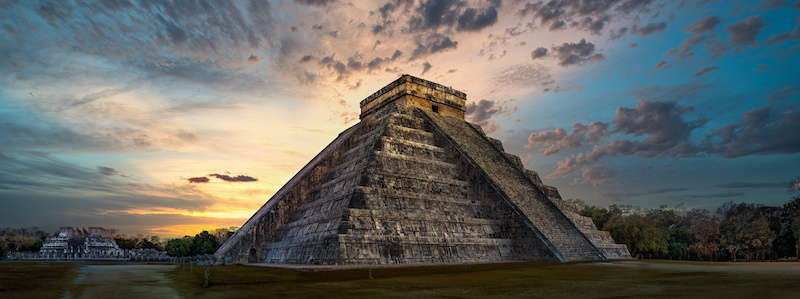
2) El Castillo
Situated on the east coast of the Yucatán Peninsula, Tulum once served as the major port of the Mayan city of Coba. Built around 1200 AD, these ruins are the only ones built by the sea.
The main pyramid at Tulum is named El Castillo and was used as a lighthouse during ancient times. This is due to the positioning of the pyramids’ windows at the top of the tower. This mythical place was originally built to be a fortress. The Mayans felt they needed protection and chose to build this overwhelming fortress to keep an eye on possible invaders.
The tropical beach backdrop however makes this a stunning Mexico top attraction that should not be missed.
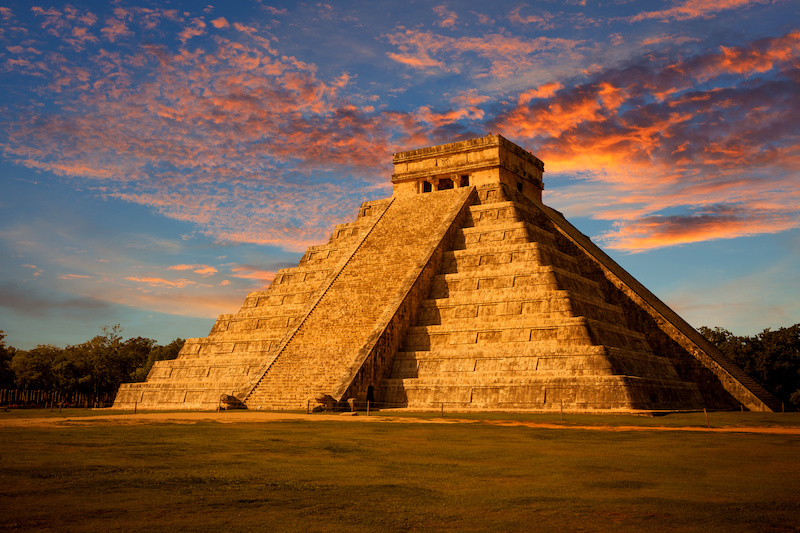

3) Palenque Ruins
Deep within the Mexican jungle, surrounded by incredible wildlife that could only be documented in a Netflix series, lies the Palenque temples. Discovered in the 16th century by a Spanish explorer, it is believed that the temples date as far as 200 AD.
The most interesting part of Palenque is the tomb of Pakal the Great that lies inside. After becoming ruler at the tender age of 12, Pakal ordered that most of Palenque be rebuilt. In doing so, he demanded that events should also be recorded in detail. Thanks to his genius, this offered archeologists incredible insight into what life was like there.
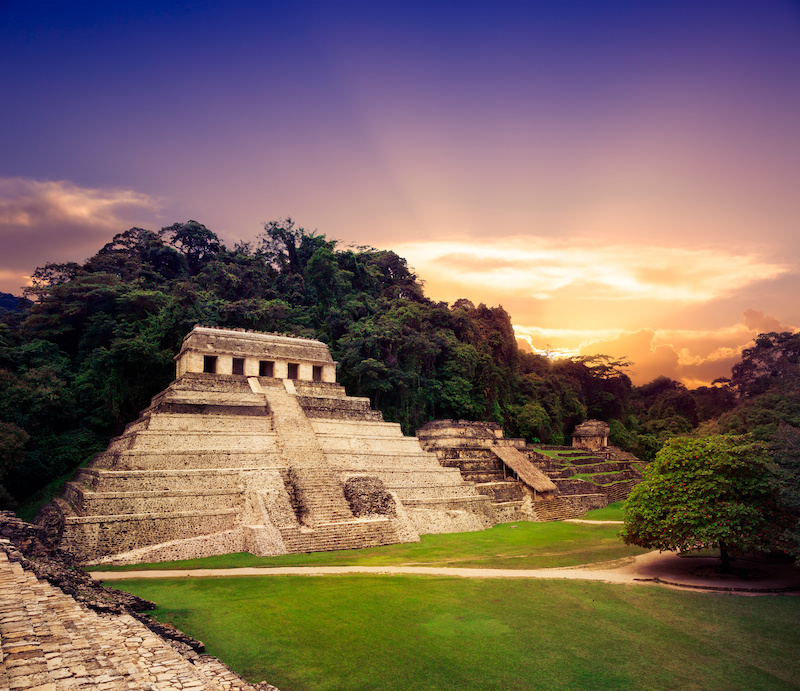
4) Copper Canyon
The Copper Canyon is in a network of canyons that together are in fact, several times larger than the Grand Canyon. The best way to discover Copper Canyon is by riding the Copper Canyon Railway.
The journey through the canyon lets you explore incredible scenery as your train weaves in and out of the thick jungle and ravines. Depending on the route you travel through, the canyon journey can take between 9 and 16 hours. It’s recommended that visitors plan a stop or two while sightseeing the canyon to visit local villages and sites.
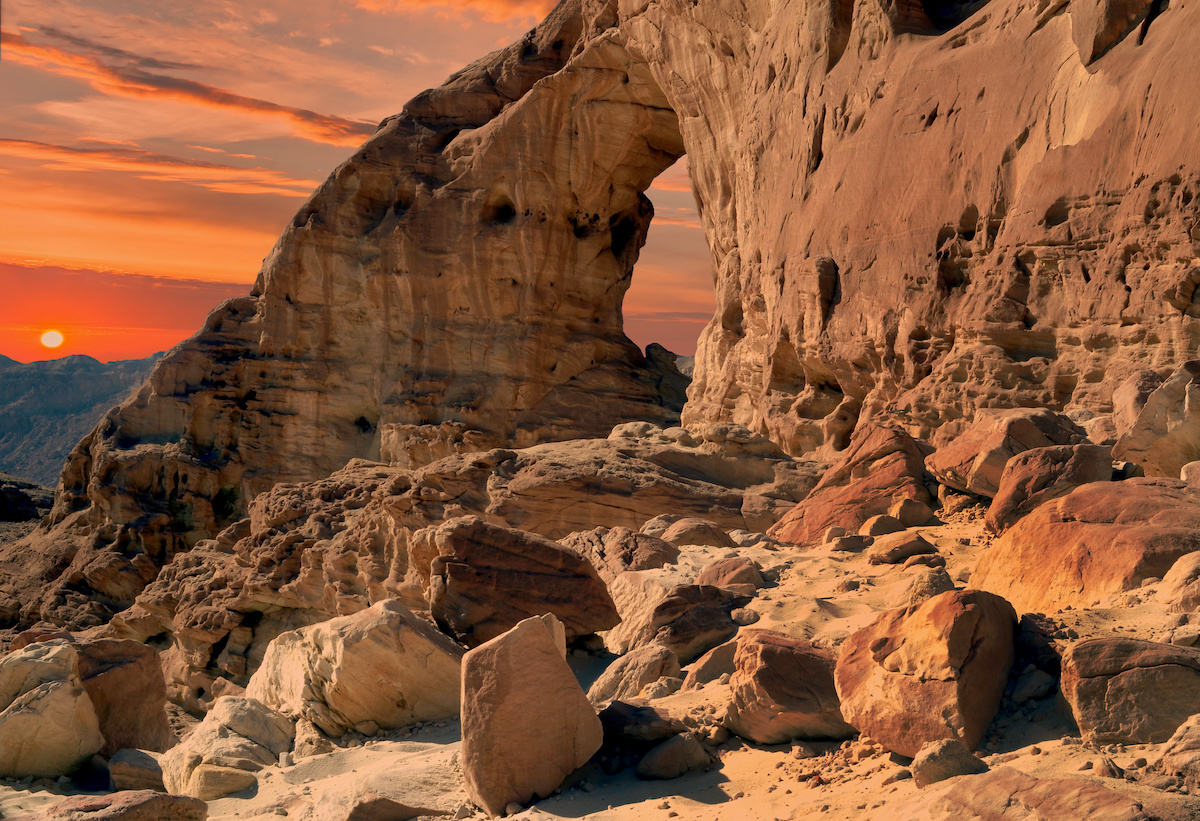
5) The National Museum of Anthropology
The National Museum of Anthropology is an important Mexico city landmark. It showcases a large and impressive collection of artifacts from the indigenous people of Mexico. The collection features a giant carved head of a fire serpent, a celestial calendar, and many other ceremonial headdresses of Aztec rulers.
The museum is a collection of minimalistic buildings with large courtyards and immaculate gardens. It’s a great place to learn more about the roots of Mexican heritage.
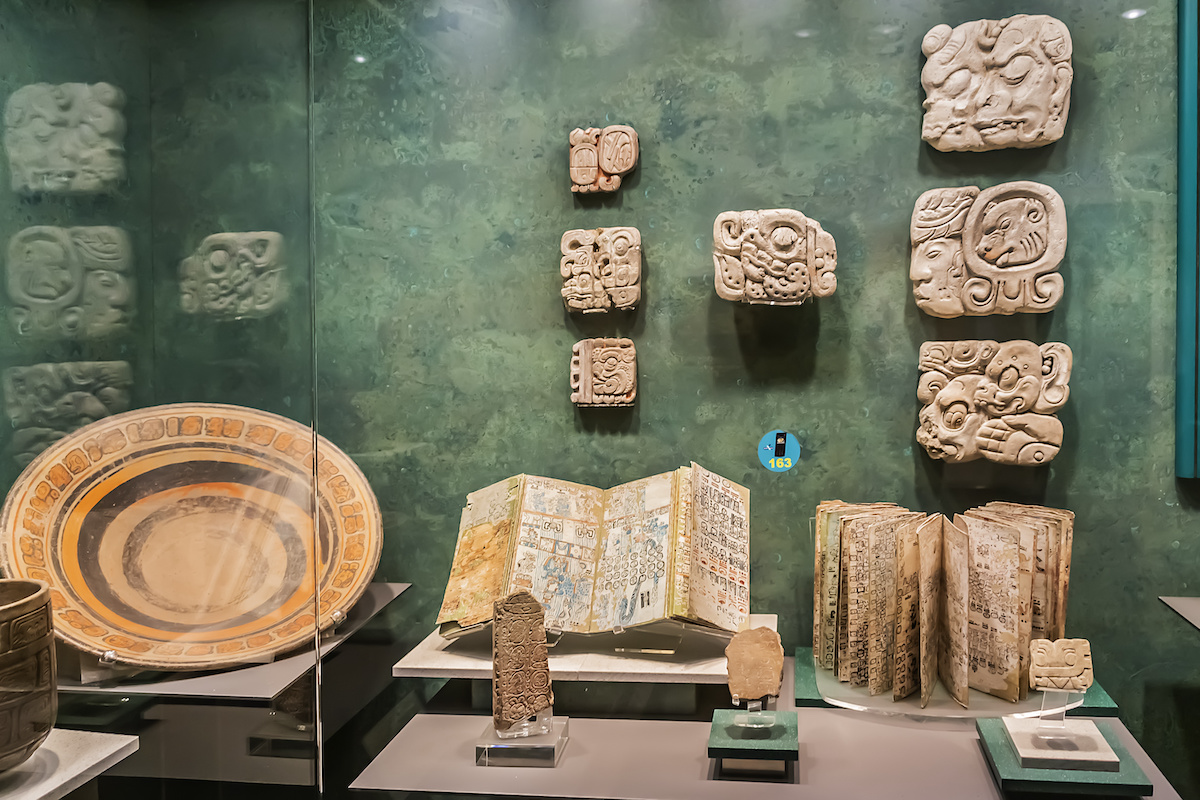
6) El Arco
El Arco (The Arch) is a unique rock formation that marks the spot where the Pacific Ocean becomes the Gulf of California . The arch, found in Cabo San Lucas, has become an icon of the city and can be viewed from several different angles.
The natural attraction runs down to the water’s edge at Land’s End, the southern tip of Cabo San Lucas, and into the Sea of Cortez. From a distance, the rock formation is said to look like a dragon, while up close, the arch frames the sky, sea, and sand.
A stroll along the beaches of Cabo San Lucas will tempt you to take some amazing pictures of El Arco. Not to mention, the views of the blue waters and the gray whales that frequently frolic in the ocean will be the cherry on top.
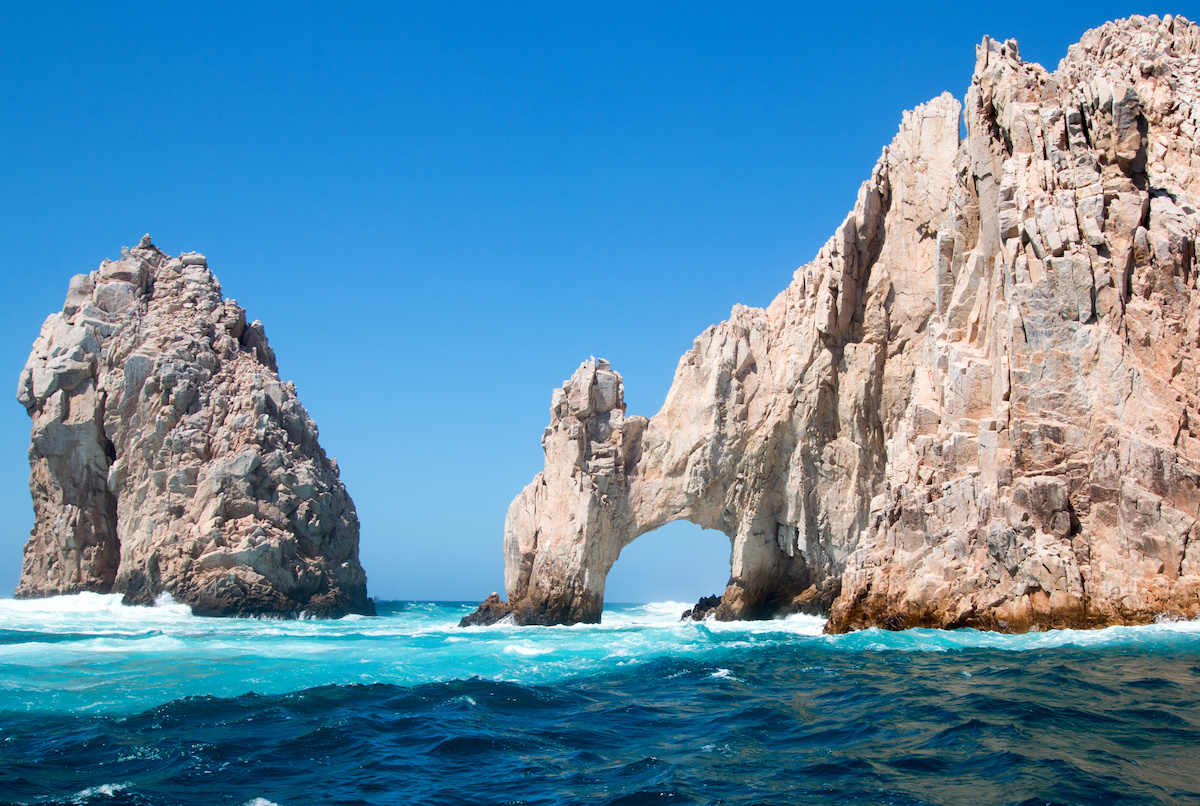
7) Cozumel
Cozumel is an underwater world located just off the Yucatan Peninsula. It’s a popular landmark in Mexico for scuba diving and snorkeling. Discovered by Jacques Cousteau in 1959, it has since become a National Marine Park to protect the delicate balance of its beautiful coral reefs and tropical fish.
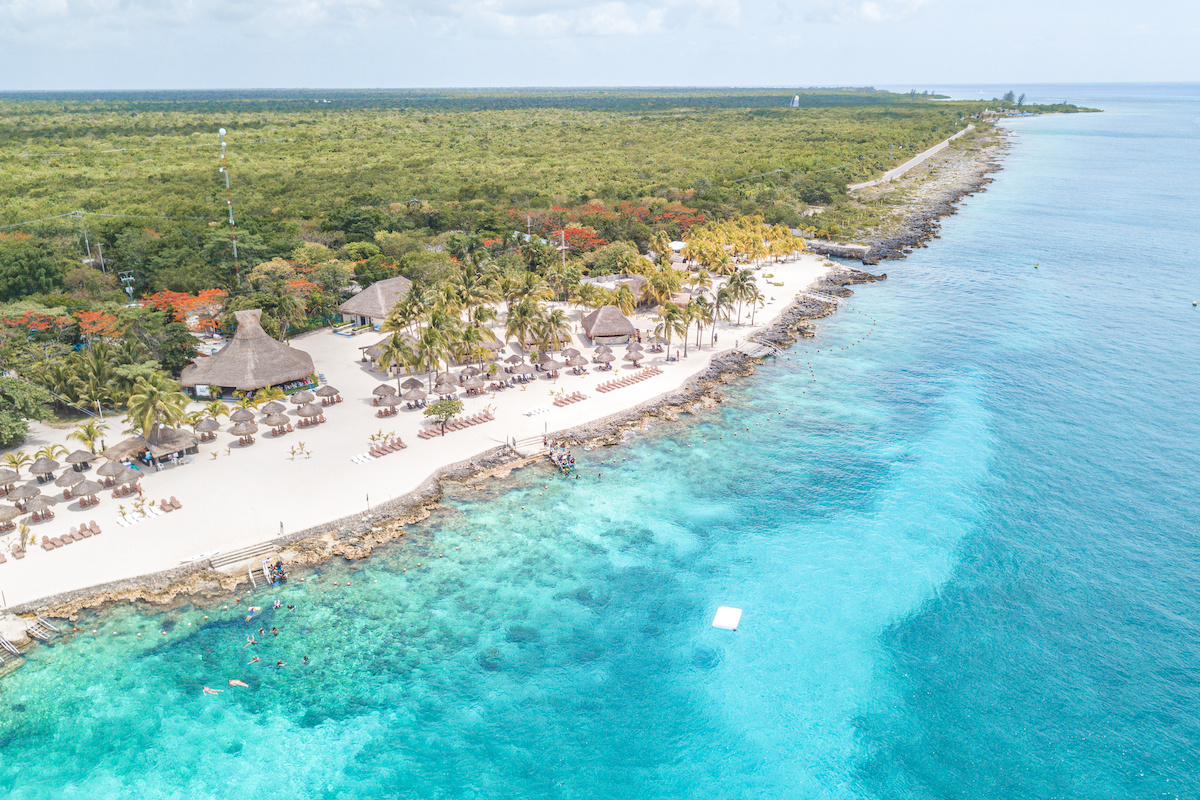
8) Ángel de la Independencia
The towering Ángel de la Independencia monument stands on Paseo de la Reforma, one of Mexico City’s principal avenues. While visiting this iconic landmark, you can’t help but to also soak up the attractive surrounding areas.
During the presidency of Porfirio Díaz in 1910, Ángel de la Independencia was dedicated to those who fought for independence and is topped with the recognizable golden Greek goddess of victory, Nike. It now also acts as a mausoleum to the heroes of the revolution.

9) Catedral Metropolitana
Catedral Metropolitana is another one of Mexico city’s famous landmarks. This grand building dates back to 1573 and has been featured on some popular Netflix telenovelas.
Besides its iconic TV debuts, the Catedral has the most exquisite Baroque architecture. Recently, it underwent some extensive restorations to ensure it’s preserved for future generations.
The entrance to the Catedral is guarded by two large towers which are encrusted in the mother of pearl. Inside, the decor is grand and impressive with a marble altar and many gilded carvings. It’s also home to a remarkable collection of religious and historical artifacts.
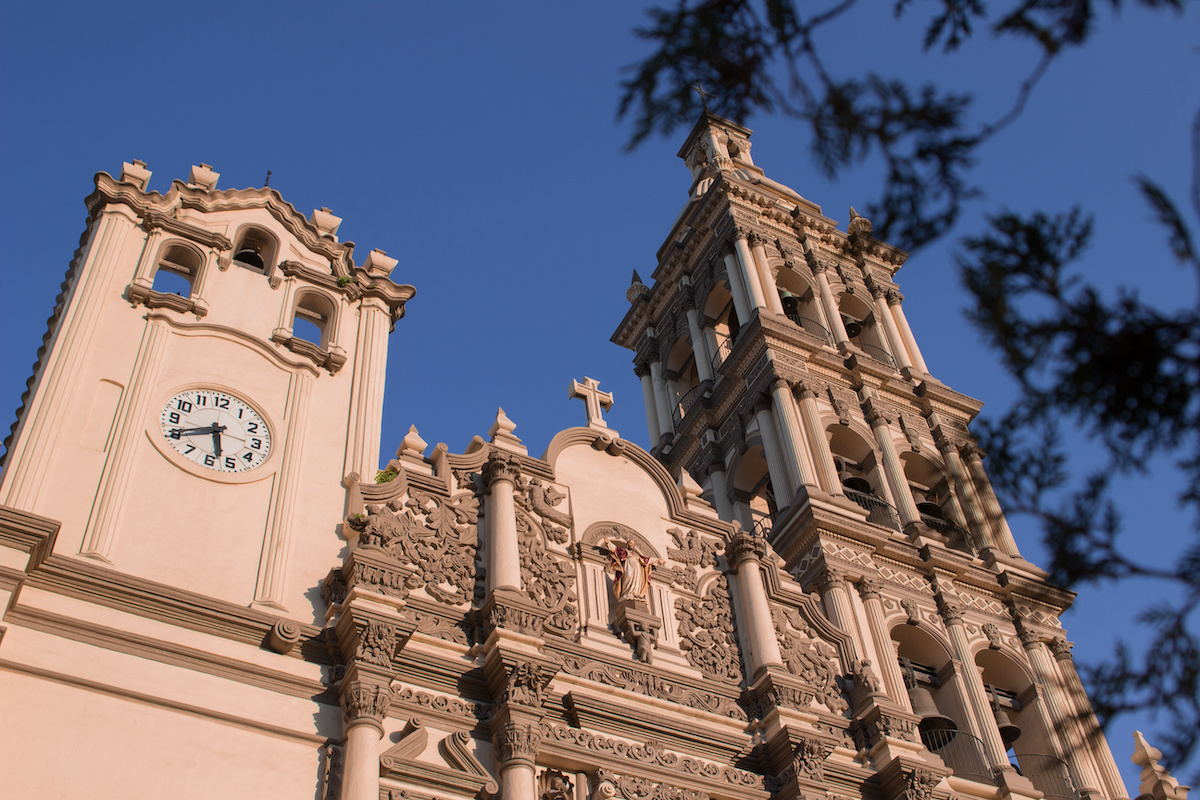
10) Guanajuato
Quietly tucked away in the mountains of the Sierra de Guanajuato, is the enchanting colonial city of Guanajuato. The city was founded in 1554 next to one of the richest silver mining areas of Mexico.
The Guanajuato streets and their many colorful alleyways spread out in every direction while most of its traffic is served by a network of underground tunnels. This makes Guanajuato a pedestrian-friendly city. The city of Guanajuato has such an interesting history, culture, and beauty that it’s no wonder many flock to see it.
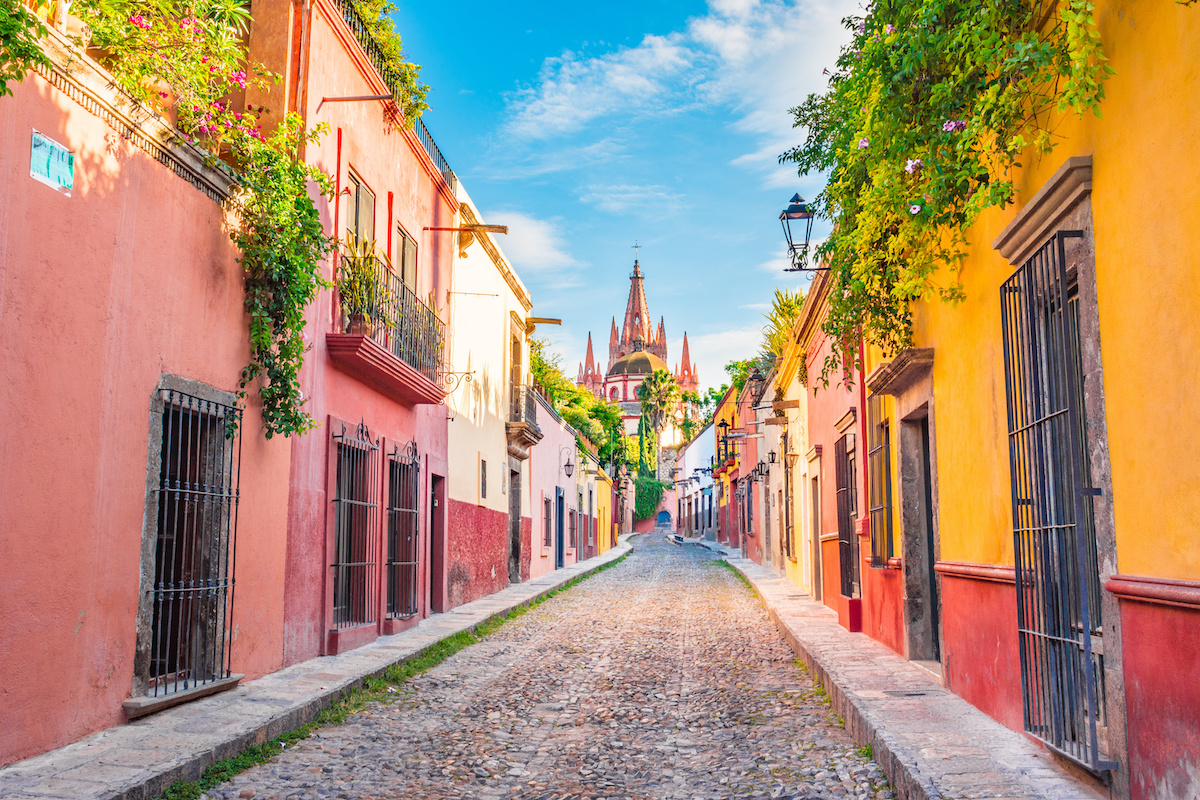
11) Cenote Dos Ojos
Just outside of Tulum is Cenote Dos Ojos, also known as the ‘cavern of two eyes’. This is one of the country’s largest underwater cave systems. Its name refers to the two sinkholes connected by a long passageway within it.
The water in the caverns is filtered through limestone, making it crystal clear. As a result, Cenote Dos Ojos is a popular tourist attraction in Mexico among snorkelers and serious scuba divers.
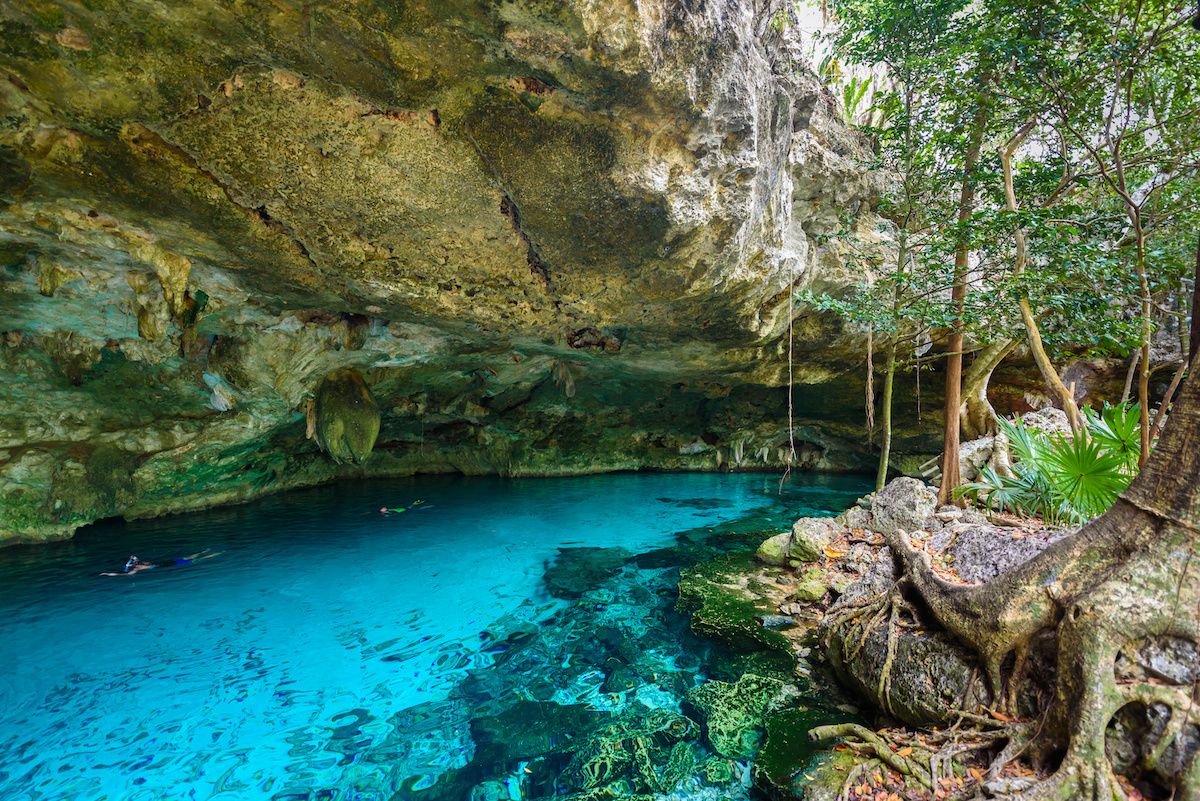
12) Santa Prisca Church
In the city of Taxco is the majestic Baroque El Templo de Santa Prisca, or otherwise known as Santa Prisca Church. Built in the 18th century, the church is a colonial landmark of Mexico that was commissioned by a prosperous Spanish mine owner.
Made from pink stone, boasting exceptionally colossal twin towers, and decorated with tiles. This is an ornate monument that no architecture enthusiast or historian would want to miss. The interior holds nine enormous altarpieces that stretch from the floor to the ceiling, and each is wrapped in gold.
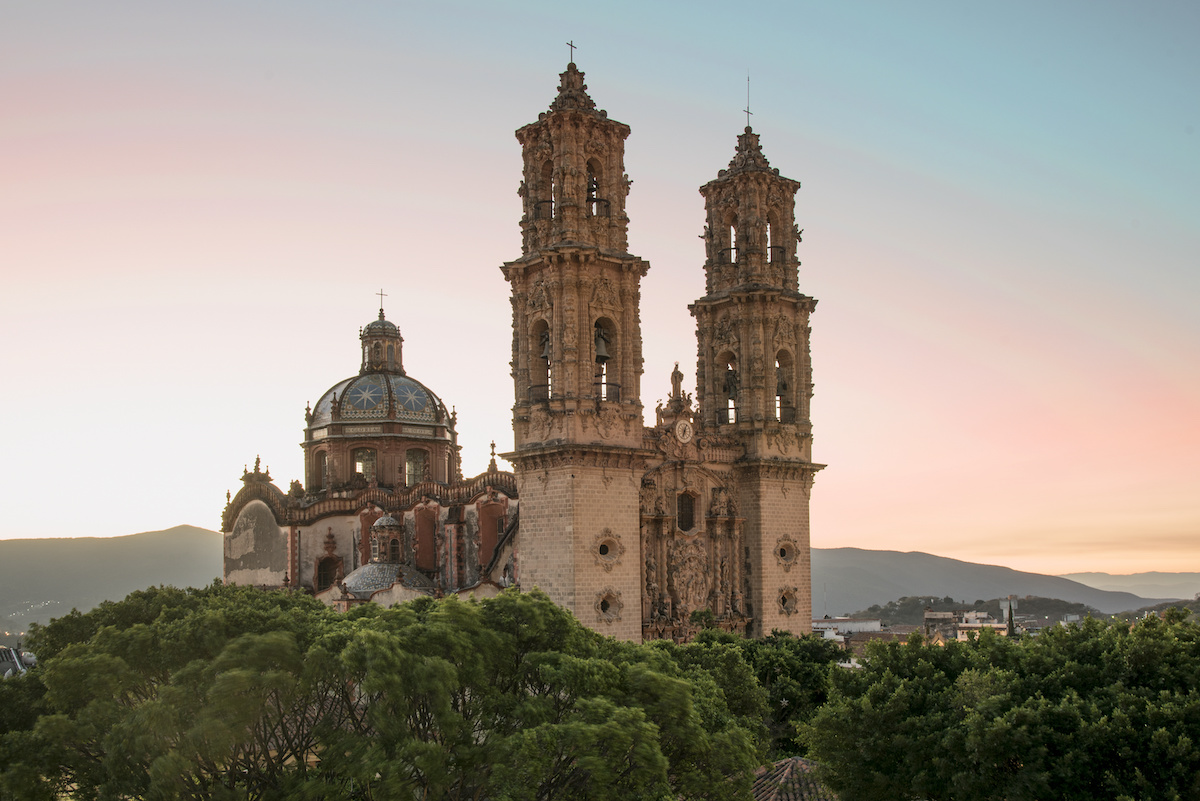
13) Isla Mujeres
Just eight miles from Cancun is Isla Mujeres. The island is surrounded by the blue waters of the Caribbean Sea and not only is it a top tourist attraction in Mexico, but it’s also a place with significant cultural heritage.
Isla Mujeres, which loosely translates to the island of women, was sacred to the Mayan goddess of childbirth. Today, visitors arrive by ferry from Cancun to relax on the scenic beaches, visit the local turtle farm, scuba dive, and just escape the crowds of the neighboring city.
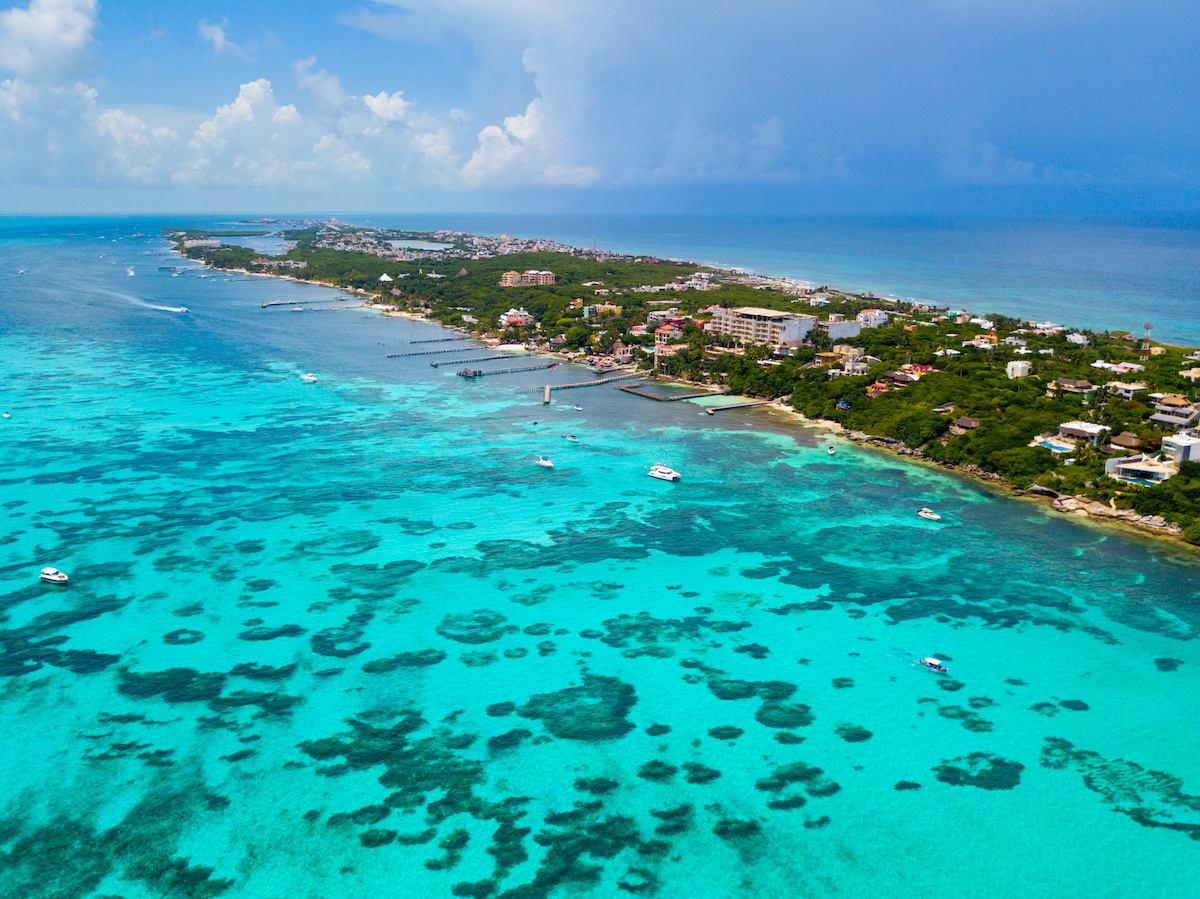
14) Monte Alban
Monte Alban is a series of ruins dating back to 500 BC. It’s where Mexico’s indigenous Zapotec people lived, worked, and worshipped on the hillside. It was then inhabited by the tribe people for over 1500 years. The Zapotec people had built canals, pyramids, and terraces on the hills.
The site is situated on high ground to form a defense against attacking tribes. Because of this location, Monte Alban has incredible views over the surrounding landscapes.
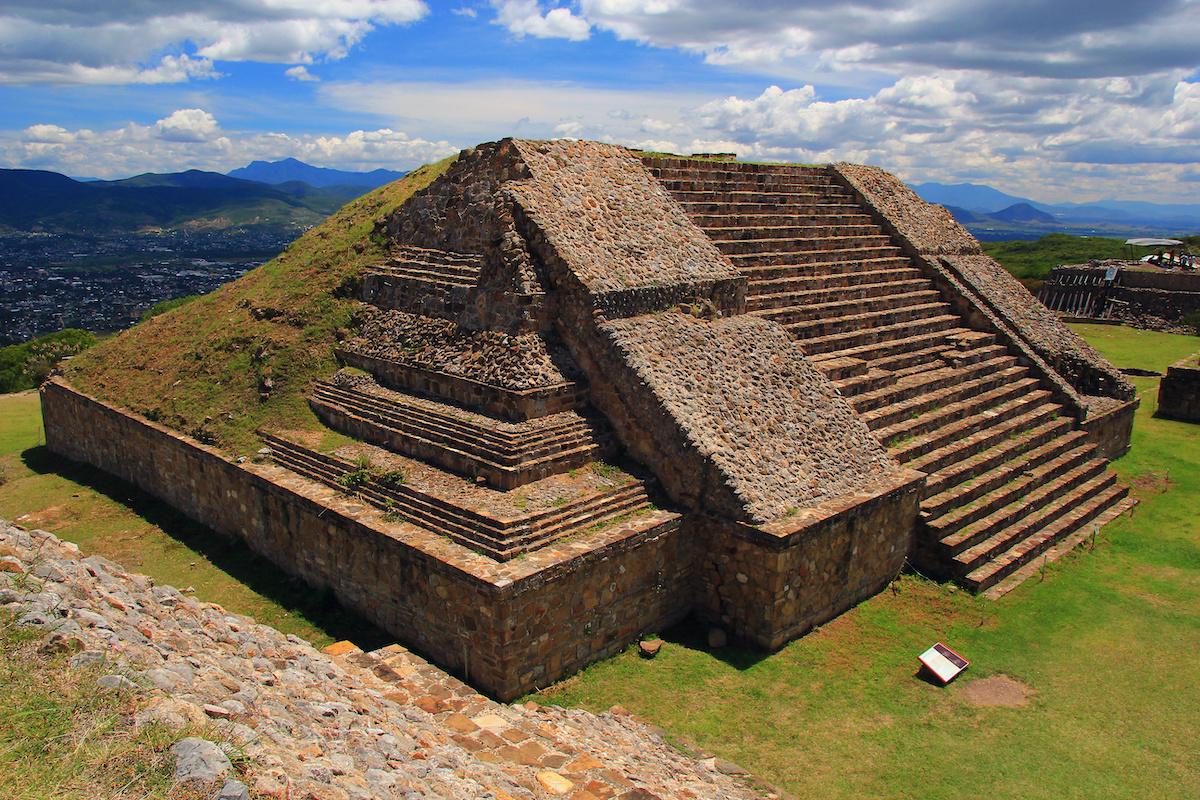
The ancient Mayan city of Uxmal is one of the most historically and culturally significant sites to see in Mexico. Uxmal was built in the 9th century and the various stone levels and elaborate stonework give the pyramid structures within the city a grandiose feel. One of the Uxmal’s pyramids known as ‘ The Magician’s Pyramid’ is the tallest one.
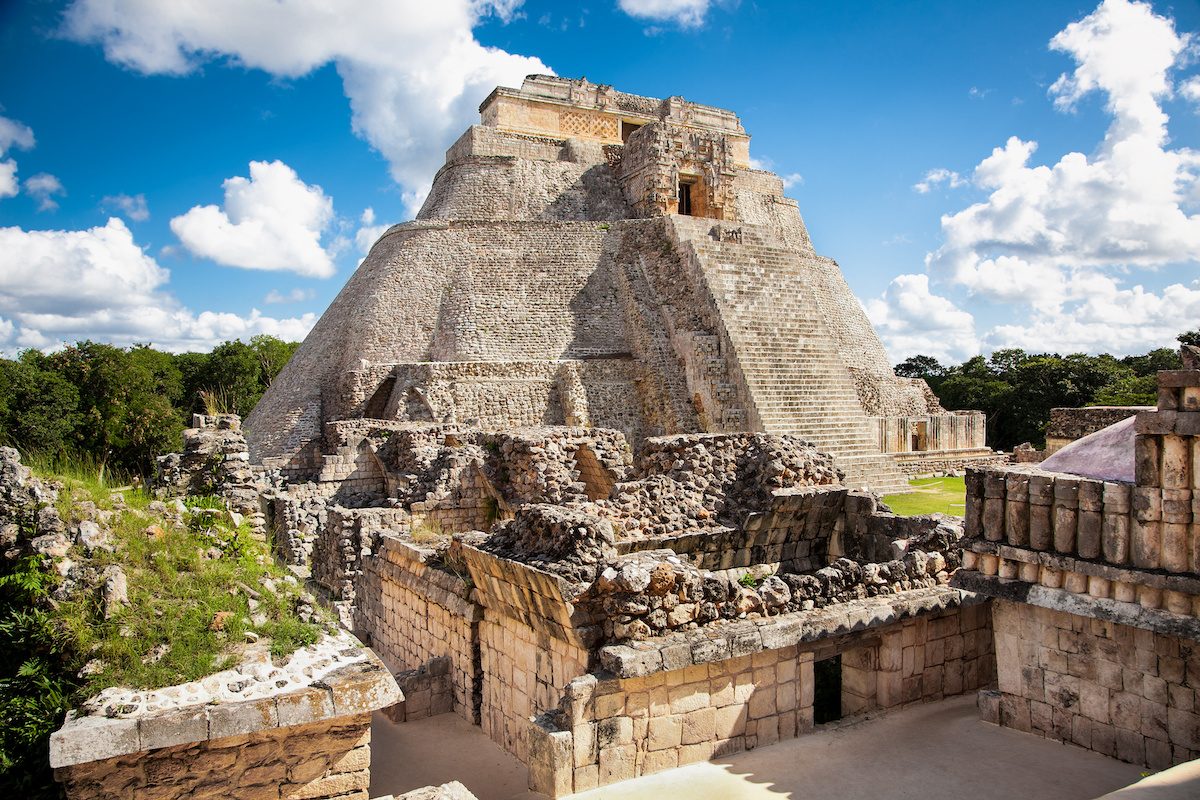
16) San Miguel de Allende
San Miguel de Allende is a small colonial town in the Bajio mountains of Central Mexico.
Although this is not a landmark, this city’s history is inspiring. Founded by a San Franciscan monk who would later play a pivotal part in the town’s independence from Spain.
Today, San Miguel de Allende is best known for its colonial architecture and European-influenced cobblestone streets. Historic buildings like the pink Teatro Angela Peralta and the Santuario de Atotonilco are enormous church complexes that are among the top attractions in Mexico.
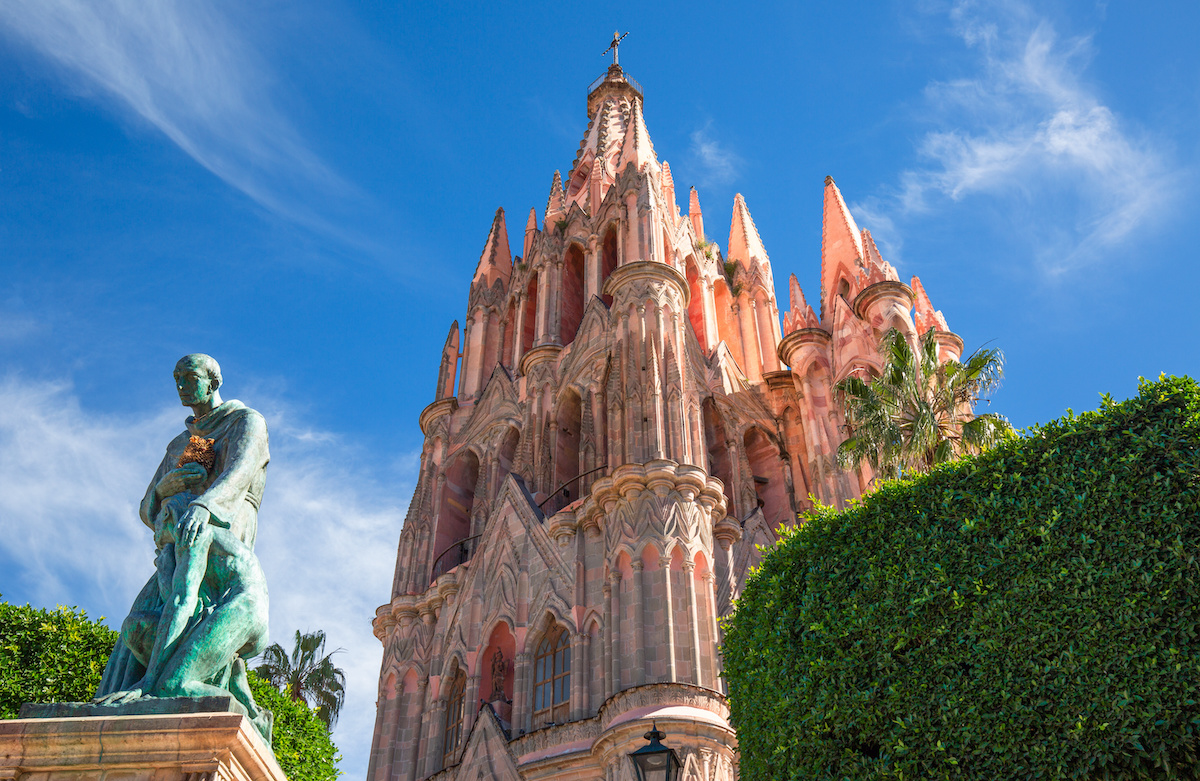
17) El Malecon
The boardwalk in Puerto Vallarta known as El Malecon borders the seaside promenade. Statues line the walkway as well as countless local establishments that cater to visitors. Most of El Malecon is exclusively for pedestrians, making it a great spot to admire the view.
Along El Malecon, you can stop to shop handmade souvenirs by the locals, sample some fresh seafood, or simply enjoy a few tropical drinks at a local bar.
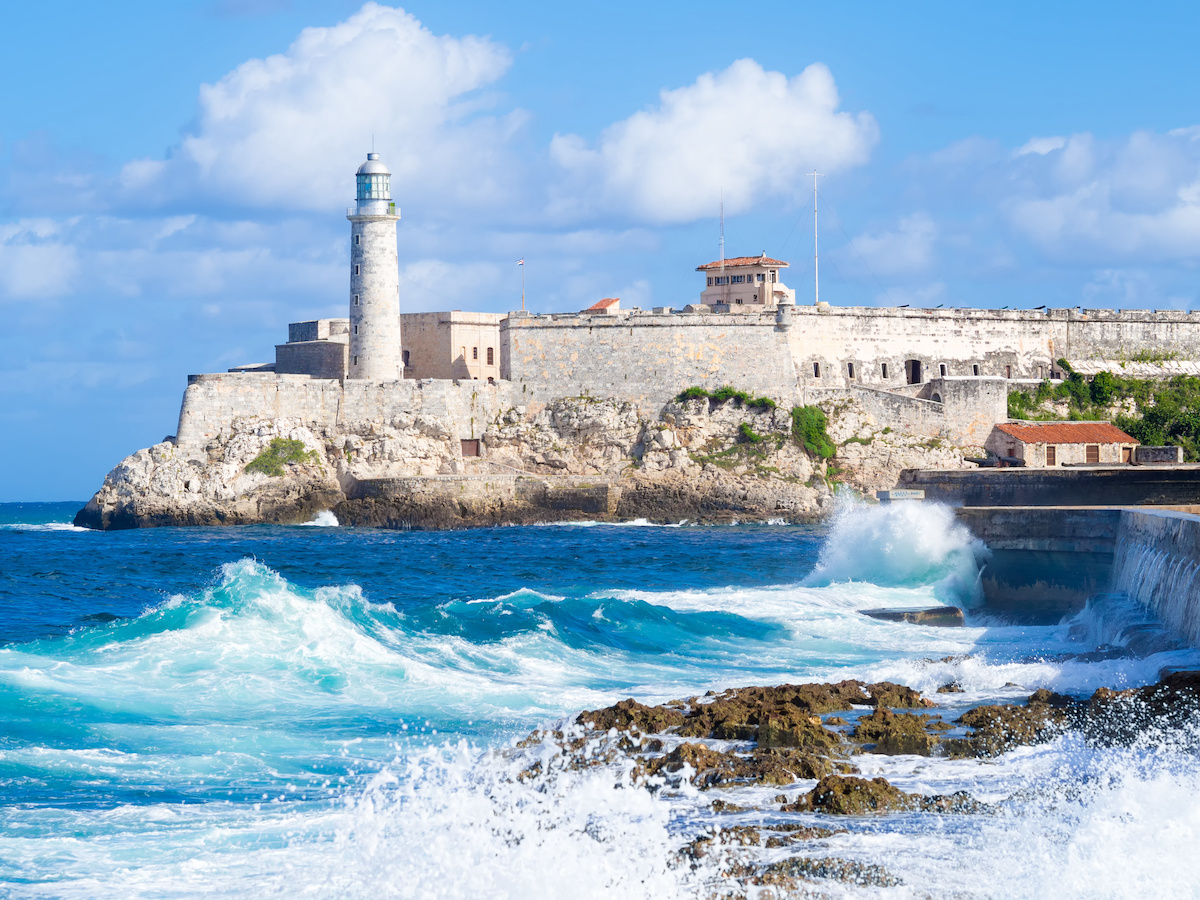
18) Arqueologica Teotihuacan
The site of Arqueologica Teotihuacan (ancient ruins), is located northeast of Mexico City. It is believed to have been built during the year 100 BC. One of the most symbolic and worshipped parts of this Mexican landmark is the Temple of Quetzalcoatl and the Pyramids of the Sun and Moon.
Unfortunately, there aren’t a lot of historical recordings of the Teotihuacan people, but it’s evident that they built plazas, temples, and pyramids. Your Mexico sightseeing itinerary would be incomplete without visiting this famous Mexican landmark.
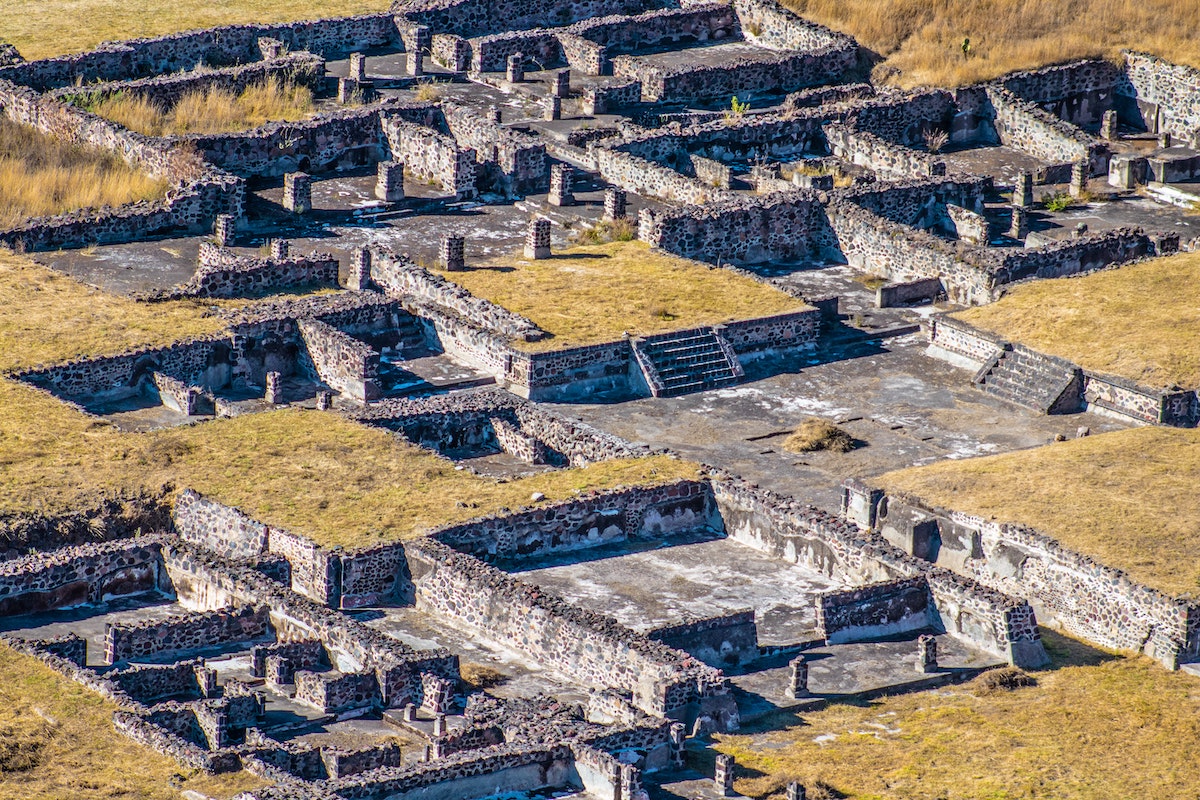
19) Mitla
Located in the state of Oaxaca is the most important religious center for the ancient Zapotec culture known as Mitla. Milta is a fascinating ancient ruin that is famous for its elaborate mosaic design that adorns the facades of the buildings and tombs. The village of Mitla is composed mainly of thatched huts and houses situated on the hillside below the ruins.
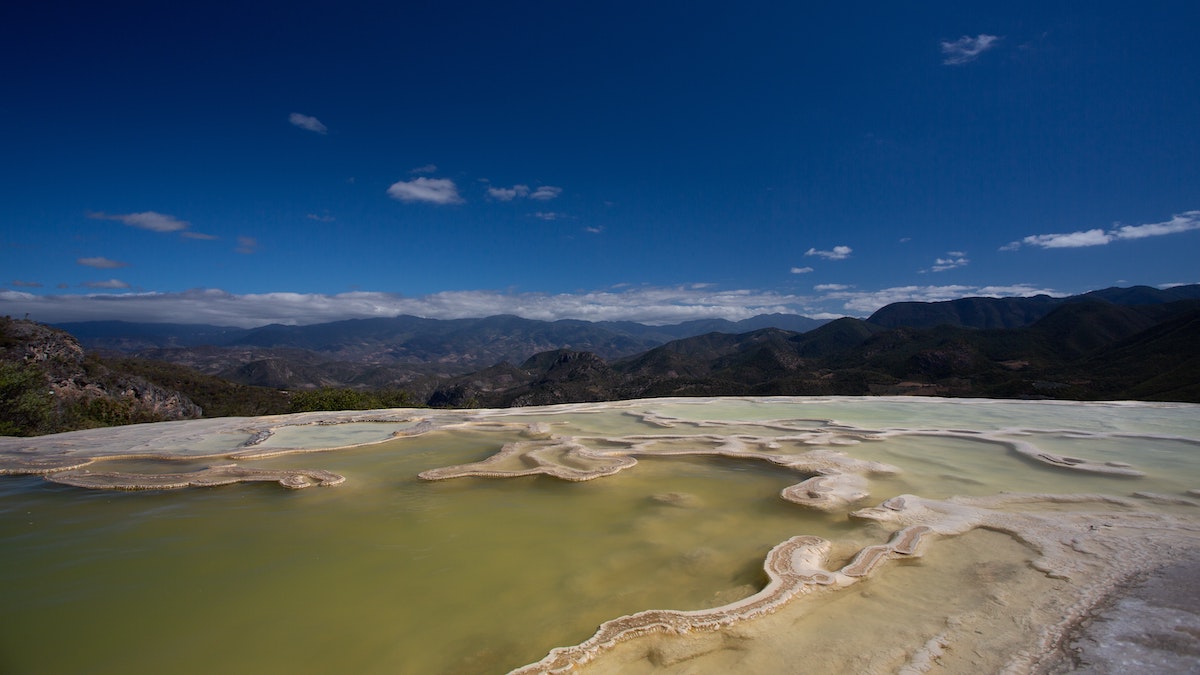
20) Templo Mayor
This stunning temple was considered the most important building in Aztec culture. Templo Mayor was built to have several layers and it stands at 197 feet (60 meters) tall.
It was once the religious and social heart of the Aztec empire. In 1987, the temple was honored as a UNESCO World Heritage Site .
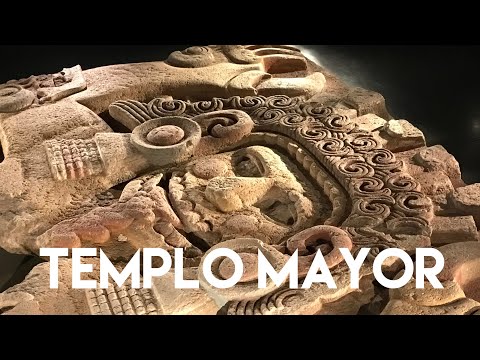
21) Bonampak Murals
Bonampak is an ancient archeological site in the state of Chiapas. While there are many Mayan structures at Bonampak worth exploring, the most famous is the Temple of Murals.
The Bonampak Murals are a collection of ancient art within the temple that beautifully illustrate the history and culture of the Mayans. Hundreds of figures have been painted in three different rooms of the temple, each of which tells a part of a narrative in bold turquoise, red, and yellow hues.
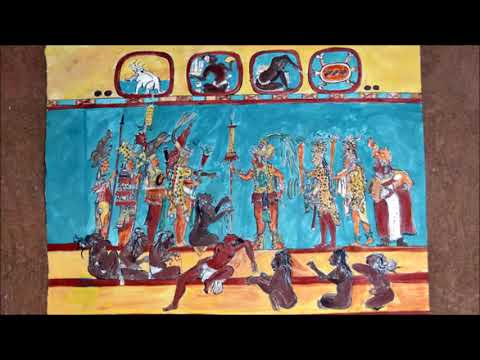
22) Castillo de Chapultepec
The Castillo de Chapultepec was built in 1785 and has been used for various purposes since its construction. Located on top of Chapultepec Hill within Mexico City, the castle was once a vacation home, a military academy, and a presidential home. Today, it’s a fascinating National Museum.
Visitors can ogle at the various mural paintings, colorful corridors, and gold embellishments. The outdoor area of the castle has a unique checkerboard pavement and beautifully carved statues. Castillo de Chapultepec is often called the only real castle in North America .
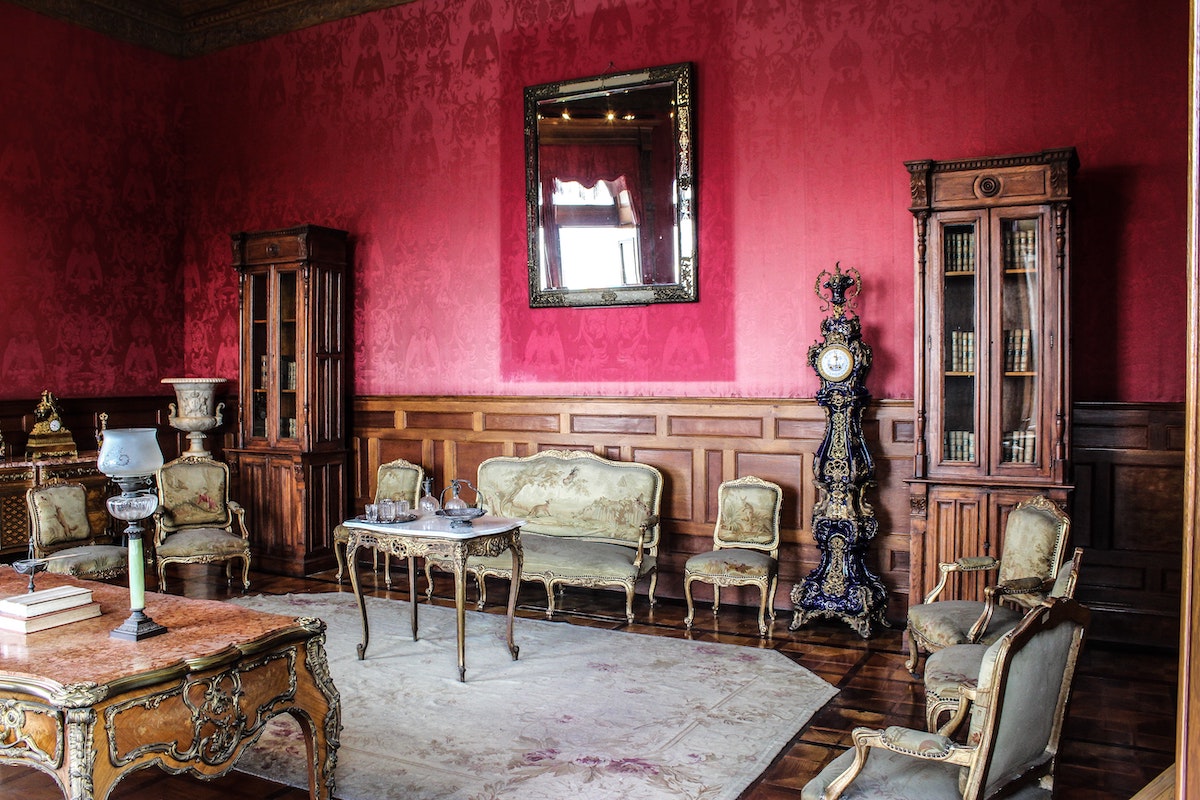
Leave a Reply
Leave a reply cancel reply.
Your email address will not be published. Required fields are marked *
Save my name, email, and website in this browser for the next time I comment.
Photography Gear
Work With Me
Privacy Policy
Destinations
Music Festivals
Travel Itineraries
Inspiration
Travel Gifts
Southeast Asia

19 Top-Rated Tourist Attractions in Mexico City
Written by Meagan Drillinger Updated Dec 26, 2023 We may earn a commission from affiliate links ( )
Author Meagan Drillinger spends months each year in Mexico, and visited Mexico City most recently in 2023.
Mexico City is, in a word, magic. The capital of the country of Mexico, Mexico City (or Ciudad de Mexico) is a swirl of gorgeous architecture, art museums, fabulous restaurants, and hotels — all set on streets that drip with centuries of history.
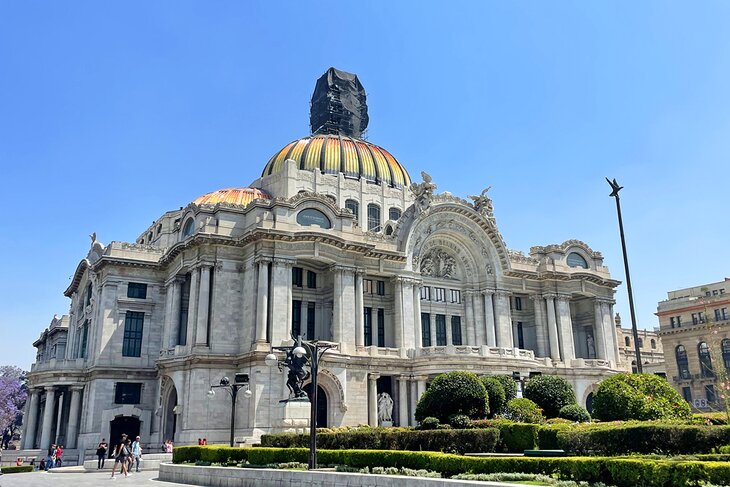
The city sits at an altitude of more than 2,200 meters in the Anáhuac Valley, wreathed in mighty mountain ranges — just have a look at the two snowcapped volcanoes, Popocatépetl and Iztaccíhuatl, which stand guard in the distance.
Mexico City is one of the largest and most exciting cities in the world . Home to more than 21 million people, it's a thriving (sometimes chaotic) capital, home to the country's top tourist attractions , including the historic city center, more than 170 museums, theater, and even a few Aztec ruins.
Discover more things to do in this vibrant city with our list of the top attractions in Mexico City.
1. Zócalo: The Birthplace of the Constitution
2. the national museum of anthropology, 3. templo mayor and the great pyramid of tenochtitlán, 4. the palace of fine arts, 5. mexico city metropolitan cathedral, 6. the national palace, 7. chapultepec park, 8. paseo de la reforma and the angel of independence, 9. national history museum, 10. coyoacán & the frida kahlo museum, 11. the basilica of our lady of guadalupe, 12. alameda central, 13. the square of the three cultures and santiago de tlatelolco, 14. the house of tiles, 15. museo mural diego rivera and museo rufino tamayo, 16. museo soumaya, 17. explore the polanco neighborhood, 18. visit teotihuacan, 19. church of san francisco, where to stay in mexico city for sightseeing, tips and tours: how to make the most of your visit to mexico city, map of tourist attractions in mexico city, mexico city, mexico - climate chart.
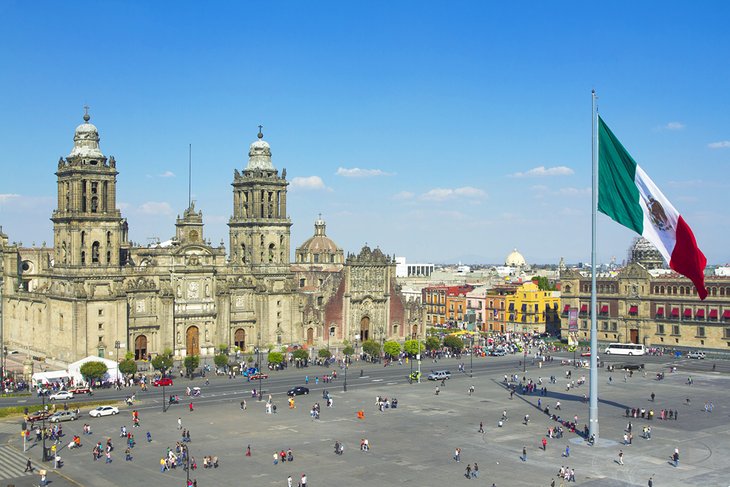
The beating heart of Mexico City is Zócalo — the Plaza de la Constitución (Constitution Square) — where the country's first constitution was proclaimed in 1813. Measuring some 240 meters in each direction, it's one of the world's largest squares and was laid out almost immediately after the conquest of the former Aztec city of Tenochtitlán on which it stands.
In the early colonial period, the square served a variety of purposes, including as a bullfighting arena and market, while today, it's used for festivals, parades, and demonstrations.
Dominated by three of the city's most visited tourist attractions — the National Palace , the Metropolitan Cathedral, and the Templo Mayor with its Aztec relics — Zócalo is the perfect place to begin exploring this historic city.
Hot Tip: A short stroll away from Zócalo, you can view three floors of murals by the famous artist Diego Rivera at the Secretaría de Educación Pública (education ministry). Entry is free.
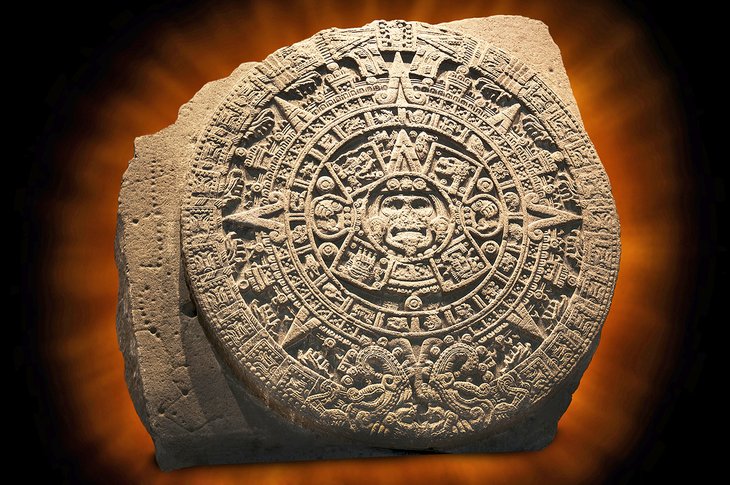
One of the most important of its kind in the world, the National Museum of Anthropology lies in Chapultepec Park and is hard to miss due to the huge monolithic figure marking its entrance.
Built in 1964, this strikingly successful example of contemporary architecture is famous for its magnificent displays of old Indian art treasures, most notably in the Central Patio, part of which is roofed by a gigantic stone shelter supported by an 11-meter-tall column with waterfalls symbolizing the eternal cycle of life.
As spectacular as the building itself is its vast collection, which includes archaeological finds from extinct Indian cultures along with details of the lifestyles of contemporary Indian inhabitants of Mexico.
Other highlights include the National Library of Anthropology , founded by Lucas Alaman in 1831 and developed by Emperor Maximilian, which boasts more than 300,000 rare volumes.
Address: Av Paseo de la Reforma y Calzada Gandhi S/N, Chapultepec Polanco, 11560 Ciudad de México, CDMX, Mexico
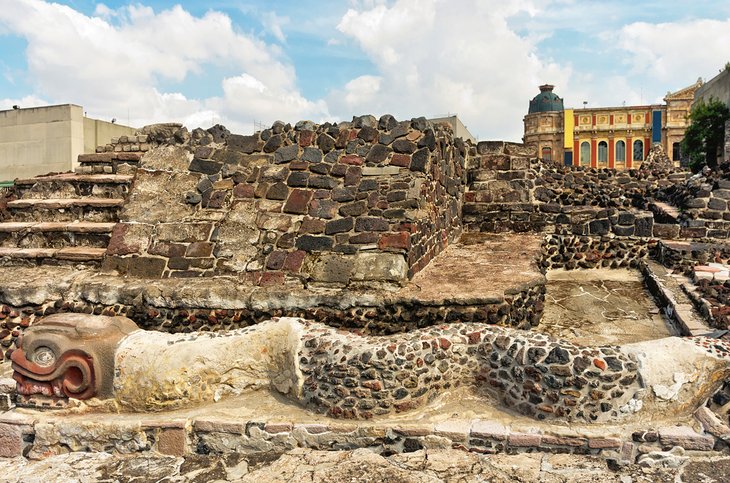
Despite the widespread destruction after the defeat of the Aztecs, a number of their important historic sites have been unearthed and put on display in recent years. The most important site is Templo Mayor, home to the remains of the Great Temple of Tenochtitlán, including the first relic discovered in 1978, a finely sculpted round disc more than three meters in diameter and weighing eight-and-a-half tons.
Further excavations — including the summit platform of an earlier pyramid with well-preserved temple walls, along with the skulls of sacrificial victims — indicate the temple site had been built over by the Aztecs and their predecessors 11 times.
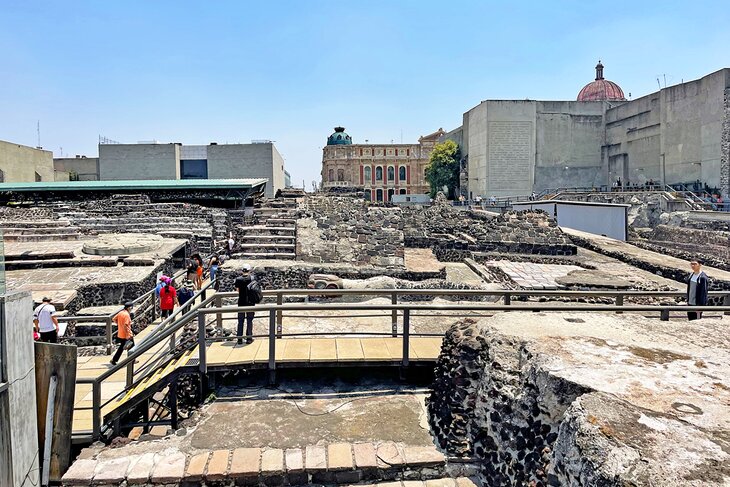
A highlight of a visit is a walkway past the precinct of the aristocratic "winged warriors," where remains of residences decorated with multi-colored reliefs have been unearthed, along with evidence of the original paintwork.
Hot Tip: The vast majority of relics and artifacts uncovered are housed in two museums: the Templo Mayor Museum built on the temple site, and the nearby National Museum of Anthropology , widely regarded as the most important museum in Mexico.
Address: Seminario 8, Centro Histórico, 06060 Ciudad de México, CDMX, Mexico
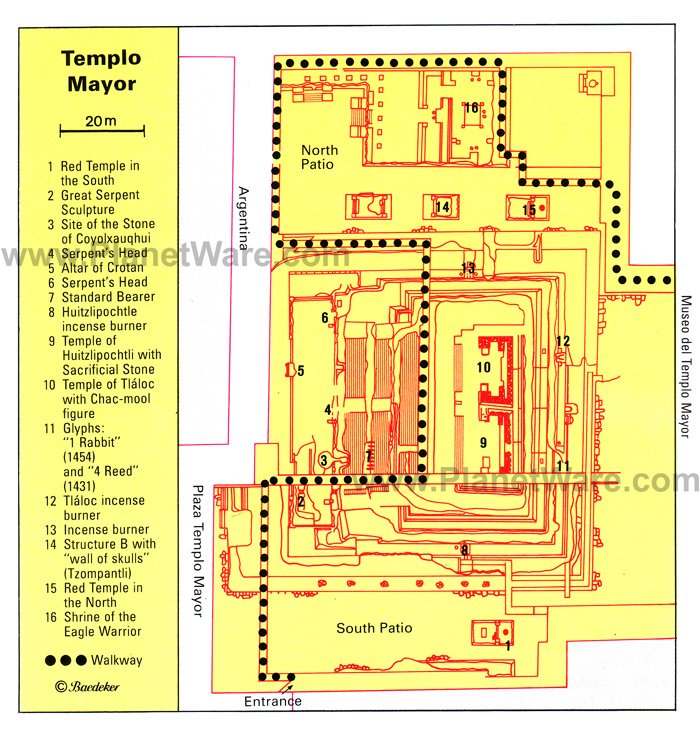
One of Mexico City's most important cultural landmarks, the Palace of Fine Arts (Palacio de Bellas Artes) is an architectural gem. Towering over the adjacent park, this massive marble building — designed by Italian architect Adamo Boari with Art Nouveau and Art Deco influences — was completed in 1934 and is so heavy that it has sunk more than four meters, despite attempts to lighten it by removing part of its huge dome.
The palace serves as an opera house and concert hall hosting a variety of traditional and international dance and operatic productions. But many visitors also come here to view the impressive murals adorning its interior by famous artists such as Diego Rivera, David Alfaro Siqueiros, and José Clemente.
On the 4th floor is the Museo Nacional de Arquitectura with rotating exhibits on contemporary architecture.
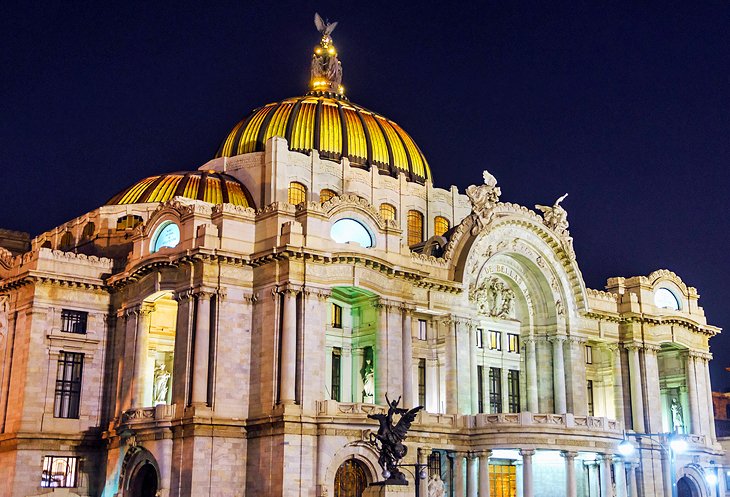
If you happen to be in town on Wednesday or Sunday, tickets to the Ballet Folklorico are a must. For nearly 60 years, this performance has brought the traditional costumes, dance, and music from all regions of Mexico to one stage for a performance that is beyond entertaining, colorful, and beautiful.
Hot Tip : If you're able to see a performance here, you'll also be rewarded with a chance to enjoy the theater's stunning interior décor, including its spectacular glass-mosaic curtain, made by Tiffany's of New York, depicting the Valley of Mexico and its two mighty volcanoes.
Address: Juárez, Centro Histórico, 06050 Ciudad de México, CDMX, Mexico
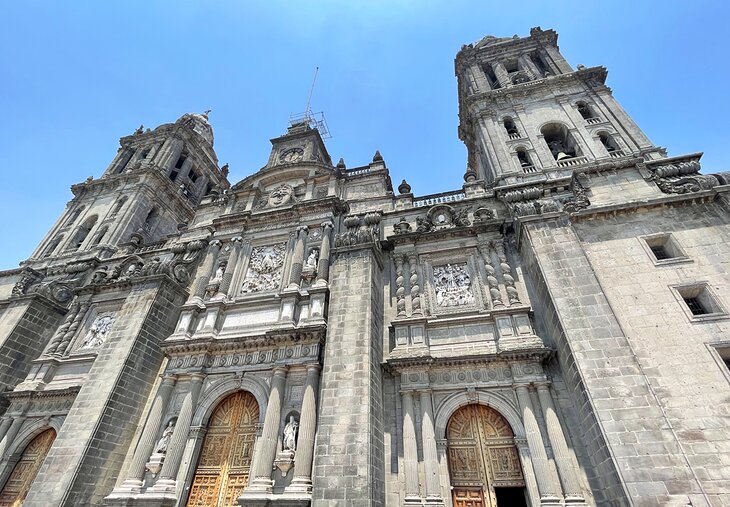
Dominating Zócalo Square, the massive Mexico City Metropolitan Cathedral (Catedral Metropolitana de la Asunción de María) is one of the oldest and largest churches in the Western Hemisphere. Built atop part of the old Aztec temple precinct, construction of this massive basalt and grey sandstone structure began in 1525 and extended over 250 years.
In spite of the two neoclassical towers and certain other features, the façade creates a predominantly Baroque impression with its massive twisted columns. Standout features are the bell towers added in 1793 and the statues of Faith, Hope, and Charity on the clock tower, dating from 1813.
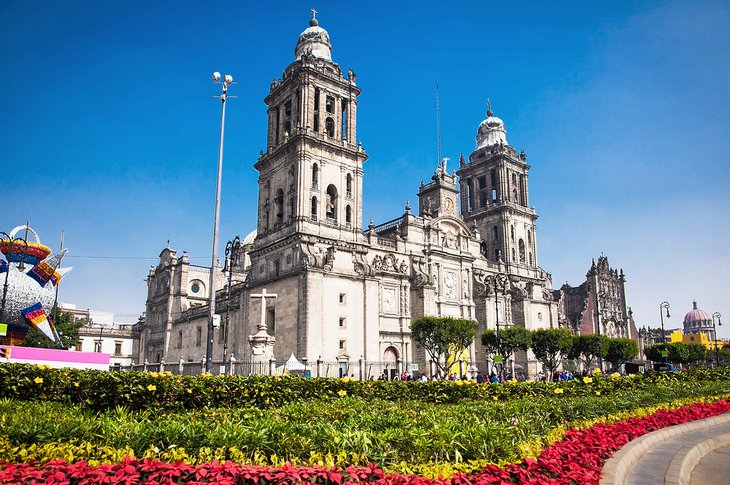
The cathedral's interior also shows a mingling of styles, with particular highlights being the richly carved Altar of the Kings (Altar de los Reyes) from 1739, with its superb devotional painting of the Assumption (Asunción de María) to which the cathedral is dedicated.
Also of interest are a chapel containing the remains of Mexican Emperor Agustin de Iturbide, and the crypt with its tombs of many of the city's archbishops, among them Juan de Zumárraga, the great teacher of the Indians and the first incumbent of the see.
Address: Plaza de la Constitución S/N, Centro, 06000 Ciudad de México, CDMX, Mexico
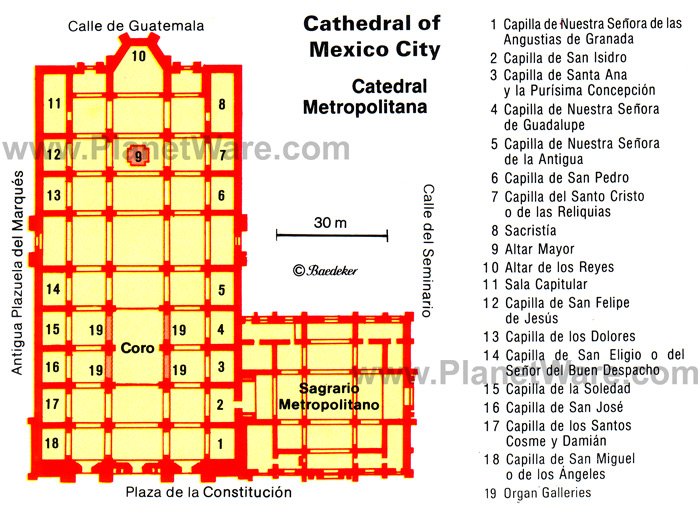
Occupying the east side of Mexico City's main square, Zócalo, the immense National Palace (Palacio Nacional), built of reddish tezontle stone and boasting a 200-meter-long façade, is the official residence of the president.
Built on top of an Aztec palace, it was the seat of the Spanish viceroys during the colonial period and has been much altered and enlarged over the years. One of the oldest and finest buildings in the city, it includes such notable features as the Freedom Bell , rung on September 15th, 1810, at the start of the War of Independence (it's rung on the anniversary of this event each year).
The palace boasts many handsome rooms laid out around its 14 courtyards, some accessible to visitors, the most notable being the arcaded Grand Courtyard with its fine frescoes depicting the country's rich history. Don't miss The History of Mexico mural by Diego Rivera, which adorns the grand staircase.
English-language guided tours explore a museum, a number of large halls, and the parliamentary chamber in which the Reform Constitution of 1857 was drawn up (it and the Constitution of 1917 are on display).
Other attractions here are the State Archives , with important historical documents, and the Biblioteca Miguel Lerdo de Tejada , one of the country's largest libraries.
Address: Plaza de la Constitución S/N, Centro, 06066 Ciudad de México, CDMX, Mexico
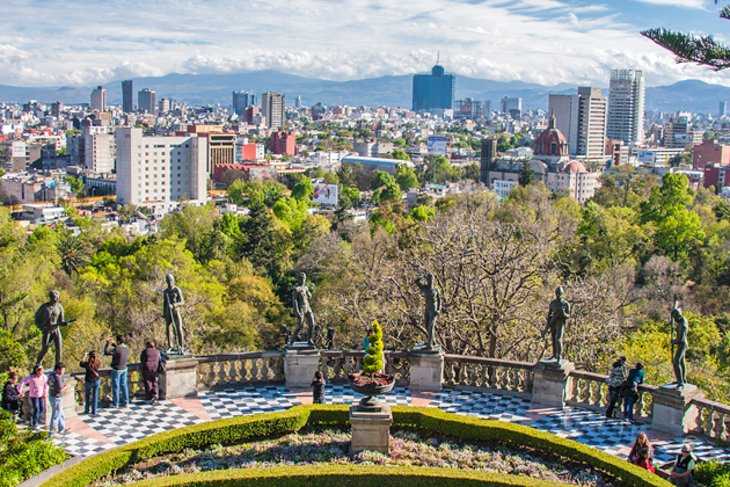
Bosque de Chapultepec is Mexico City's principal park, and covering an area of more than four square kilometers, it is also its largest. Once a stronghold of the Toltecs, it was here in AD 1200 that the Aztecs settled, and according to legend, laid out a park in the early 15th century.
Over time, the hill became a summer residence of the Aztec rulers with water from its springs conveyed to the temple precinct in the capital by means of an aqueduct, the remains of which can still be seen in Avenida Chapultepec. Portraits of the Aztec rulers were carved on the slopes of the hill, remnants of which can still be seen.
These days, the park is popular for its lakes, sports facilities, botanic garden, and museums — you'll find both the National History Museum and the National Museum of Anthropology here — along with numerous fun events, including concerts and theatrical performances.
Also of interest is the Museum of Modern Art (Museo de Arte Moderno), which opened in 1964 and is important for its retrospective look at Mexican art before and during the colonial period and its collection of pictures and sculptures by Mexican artists of the 19th and 20th centuries.
The Chapultepec Zoo is also here with a surprising diversity of animals from around the world.
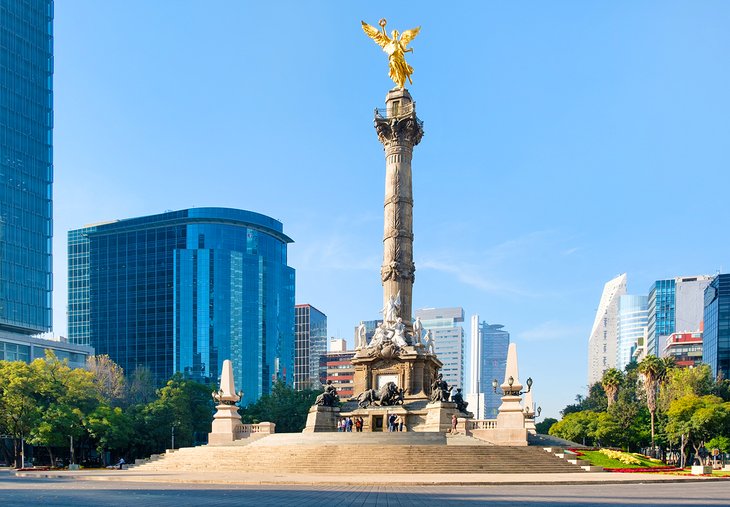
The principal east-west traffic artery of Mexico City, Paseo de la Reforma extends for 15 kilometers from Tlatelolco to the residential district of Las Lomas but is best known for the stretch from Avenida Benito Juárez to Chapultepec Park .
Here, this attractive boulevard widens to 60 meters with a pleasant green strip in the middle containing busts and monuments to numerous national heroes. While now largely known as a busy entertainment and shopping area, this magnificent avenue - laid out during the reign of Emperor Maximilian - is home to a number of important attractions, most notably the massive Independence Monument (Monumento a la Independencia), also known as "El Angel" for the figure of a winged goddess of victory standing atop its tall 36-meter column.
In addition to its fine statues of the heroes of the country's independence movement is the Mausoleum, with its many skulls of some of the country's most important historical figures.
On Sunday mornings, Paseo de la Reforma closes to cars to become a pedestrian and cycle-friendly thoroughfare. It's one of the best things to do for residents of all ages. You may even find a pop-up yoga class happening in the street.
Address: Paseo de la Reforma y Eje 2 PTE, Juárez, Cuauhtémoc, Ciudad de México, CDMX, Mexico
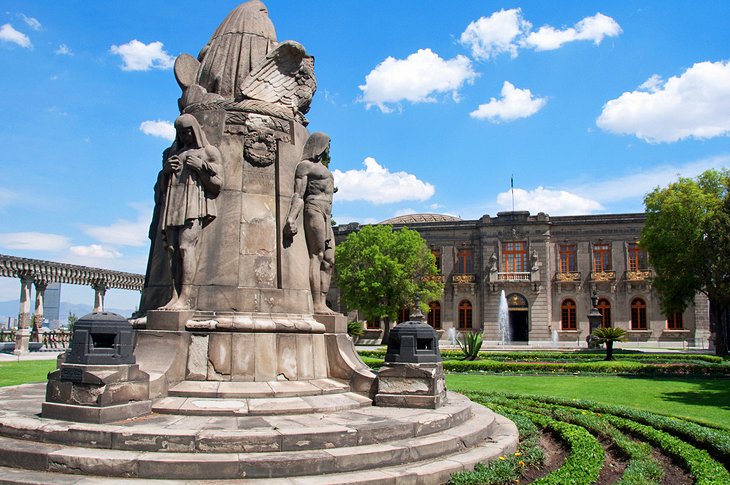
Another of Mexico City's world-class attractions is the National History Museum (Museo Nacional de Historia). Housed in the 18th-century Chapultepec Castle (Castillo de Chapultepec), on a site once occupied by Aztec buildings and later by a Spanish hermitage, the museum opened in 1944 and is home to an impressive collection of pre-Columbian material and reproductions of old manuscripts, as well as a vast range of exhibits illustrating the history of Mexico since the Spanish conquest.
Highlights include arms and armor, documents, maps, and plans of the Conquest period and its immediate aftermath; ceramics, clothing, jewelry, and coins from three centuries; relics and souvenirs of the struggle for independence and the revolutionary wars; portraits of leading figures in Mexican history; and a number of state carriages, including those used by Benito Juárez and Emperor Maximilian.
Also of interest are the apartments occupied by Maximilian and Charlotte, decorated in neoclassical style and containing furniture brought from Europe. The castle also offers beautiful views over the city.
Address: Castilla de Chapultepec 1a Sección, Mexico City, CDMX, Mexico
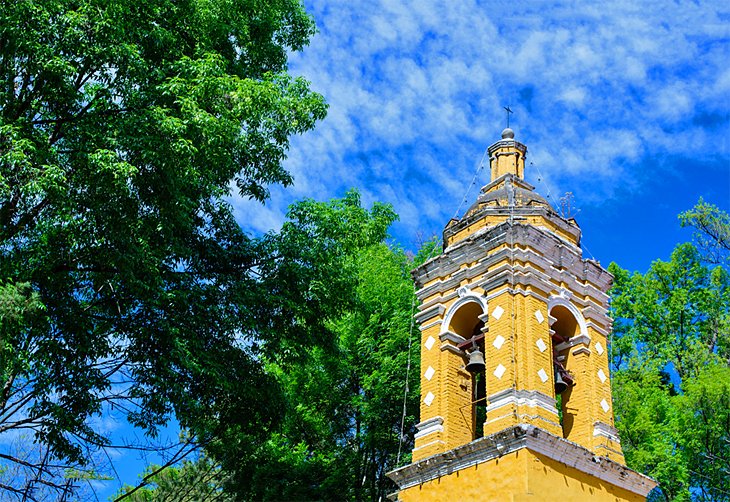
Laced with atmospheric cobblestone streets, Coyoacán is one of Mexico City's oldest neighborhoods. Take time to stroll around the maze of laneways here and explore the hidden plazas, colonial-style mansions, and art-filled old churches like San Juan Bautista.
You can also sample exotic fruits and vegetables at the markets. One of the top tourist attractions in the town is the Frida Kahlo Museum in La Casa Azul (The Blue House), where the famous Mexican artist was born and where she frequently returned throughout her life. Here, you can view some of her most important paintings, as well as works by her famous husband, the mural artist Diego Rivera, and personal items from the couple's life. Note that it's best to purchase tickets in advance.
An easy way to see all the highlights of Coyoacán is on the full-day Mexico City Super Saver Tour . This 11-hour excursion begins with a guided tour through the neighborhood, including a visit to the Frida Kahlo Museum and North America's oldest university, as well as a boat tour along the canals of the UNESCO-listed ecological reserve, Xochimilco.
While you're in Coyoacan you can also visit the Museo Casa de Leon Trotsky . This is the house where Leon Trotsky, the exiled Russian politician, spent the final years of his life before he was assassinated.
Address: The Frida Kahlo Museum, Londres 247, Del Carmen, Coyoacán, 04100 Ciudad de México, CDMX, Mexico
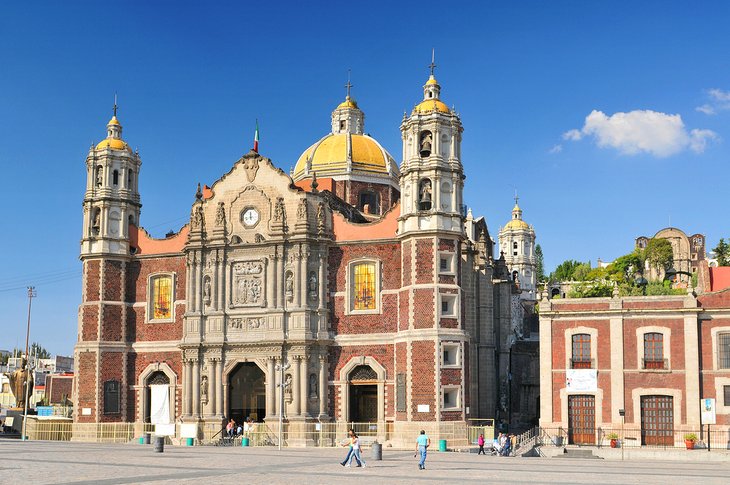
Said to have attracted its first pilgrims when it opened in 1531, the Roman Catholic Basilica of Our Lady of Guadalupe (Basílica de Nuestra Señora de Guadalupe) attracts millions of visitors and worshipers each year, particularly during the Feast Day each December 12th.
Built adjacent to the hill where the Virgin Mary is said to have appeared, the site consists of a complex of buildings overlooking a broad public square adorned with a number of interesting modern sculptures, including a large concrete cross with a unique clock and chime.
Highlights include a splendid altarpiece dedicated to Mary in the 16th-century Old Basilica, and the new Basilica de Guadalupe, built in 1976, and notable for its distinctive modern curved appearance.
Address: Plaza de las Américas 1, Villa de Guadalupe, 07050 Ciudad de México, CDMX, Mexico
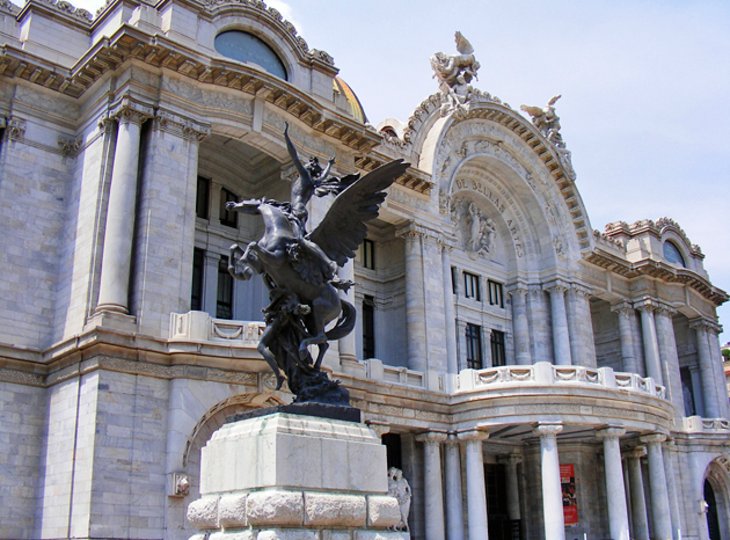
Alameda Central, a shady and beautifully kept park with many splendid fountains and sculptures, was laid out in 1592 on the site of a once-busy Aztec market. It remains a bustling location to this day, especially at Christmas, when it is beautifully illuminated and decorated. Next to the park is the stunning Palacio de Bellas Artes , which hosts music and theatrical performances as well as important art exhibitions.
Address: Av Hidalgo S/N, Cuauhtémoc, Centro, 06010 Ciudad de México
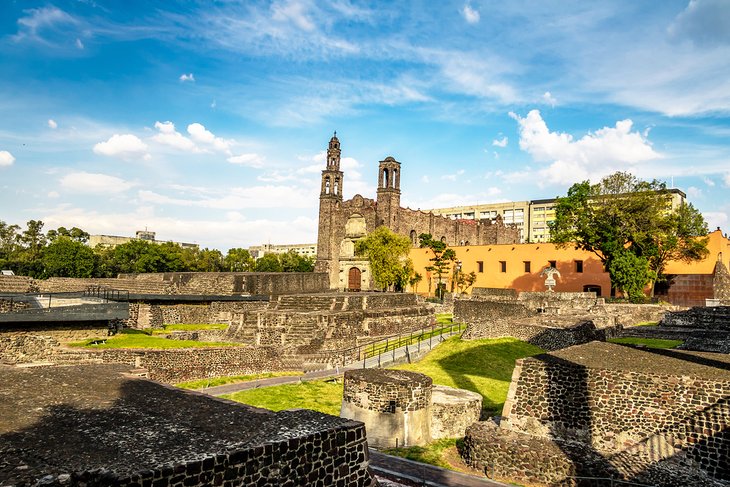
Another of Mexico City's important historic squares is the Square of the Three Cultures (Plaza de las Tres Culturas). The square occupies the site of the main square of the Pre-Columbian town of Tlatelolco and the scene of the last desperate stand by the Aztecs in 1521 - an event remembered by a memorial tablet.
It takes its name from its interesting mix of buildings from three different periods: Aztec pyramids and temples, a Spanish church, and modern tower blocks. In addition to the principal pyramid, other Aztec remains include a number of smaller pyramids, platforms, staircases, walls, and altars, as well as a "tzompantli," a wall of skulls and fine reliefs of Aztec calendar signs.
The square is also home to a rather sobering memorial museum, Memorial 68, commemorating the tragic murder of some 250 protesting students by government forces in 1968.
Also of note is the Baroque church of Santiago de Tlatelolco , built in the early 17th century on the site of a small chapel from 1535 that belonged to the Franciscan convent of Santiago. Adjoining the church is one of the old convent buildings, formerly the Colegio Imperial de Santa Cruz, in which the Franciscans taught the gifted sons of the Aztec nobility (one of the most notable teachers was Bernardino de Sahagún, the great chronicler of the history of New Spain).
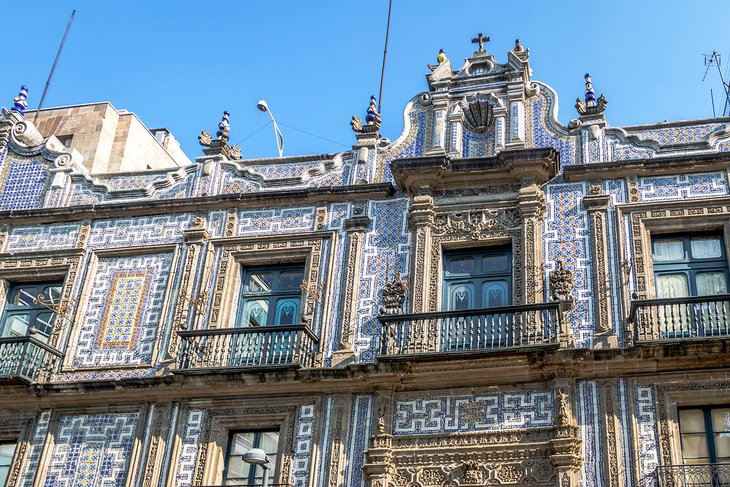
Opposite the picturesque Church of San Francisco is the spectacular House of Tiles (Casa de los Azulejos). It was originally built in 1596 and boasts a façade decorated by the Conde del Valle de Orizaba 150 years later, with exquisite blue and white tiles from Puebla.
It became even more famous after artist José Clemente Orozco painted murals on the walls of the staircase in 1925. The House of Tiles is now a restaurant and an evocative venue to dine al fresco in the building's spectacular courtyard, surrounded by what is one very large work of art.
Hot Tip : Be sure to check out the large photo marking the spot where Emiliano Zapata and Pancho Villa dined together on arrival in Mexico City.
Address: Av Francisco I. Madero 4, Centro, 06500 Ciudad de México, CDMX, Mexico
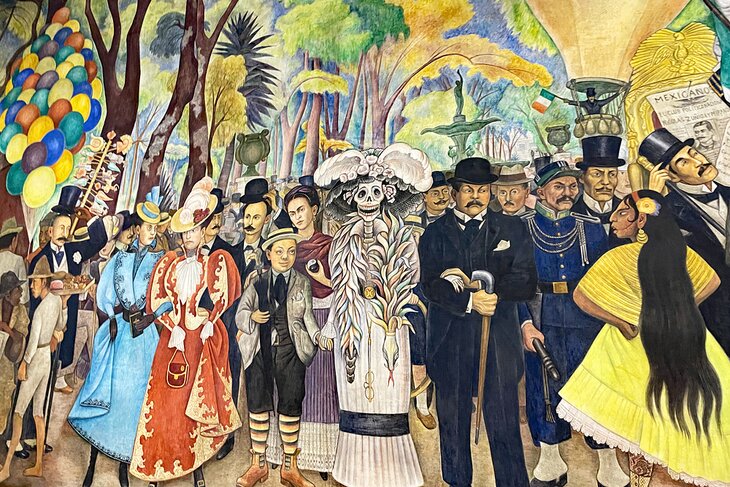
A short walk from the National Museum of Anthropology is Museo Rufino Tamayo, named after Rufino Tamayo (1900-91), one of Mexico's most famous painters. Notable for its unusual interior, the gallery opened in 1981 and, in addition to Tamayo's artwork it also displays his own extensive collection of several hundred works by contemporary artists, including prints, paintings, sculptures, and wall hangings.
Another important art facility worth visiting is Museo Mural Diego Rivera named after one of the country's leading artists whose most famous painting - Dream of a Sunday Afternoon in Alameda Park - in which he caricatured some of Mexico's historical figures, is on display here after years of being banned by the state (Rivera had originally called it Dios no existe , or God does not exist ).
Address: Paseo de la Reforma 51, Bosque de Chapultepec, 11580 Ciudad de México, CDMX, Mexico
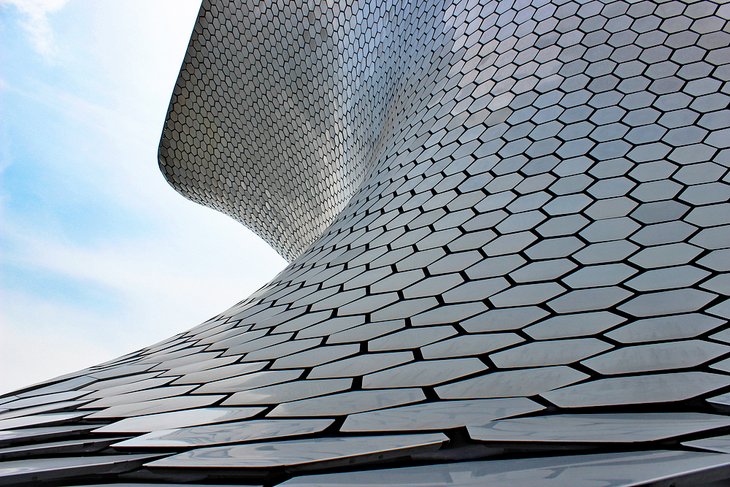
A trip to Mexico City would be incomplete without a visit to the Museo Soumaya . This futuristic, architectural mind-meld was founded by Carlos Slim, one of the wealthiest men in the world, who named it for his deceased wife, Soumaya. Inside is more than 66,000 pieces of art that span 3,000 years, from sculptures from Mesoamerica right up to works from Tintoretto and Salvador Dali.
The non-profit cultural icon originally was housed in the Plaza Loreto of San Angel until 2011. It was moved to a new building in Plaza Carso in Nuevo Polanco, designed by Mexican architect Fernando Romero. The silver, reflective building spans 170,000 square feet of space and is a design feat in itself, pinched at the center like an hourglass, but angular like the hull of a ship.
But the real masterpieces continue inside. The majority of art is from the 15th to 20th centuries, though there is a substantial collection of indigenous Mexican art. Slim is the owner of the world's largest private collection of Auguste Rodin's art, as well, and the museum has the largest collection of casts of his sculptures outside of France.
Address: Blvd. Miguel de Cervantes Saavedra, Granada, Miguel Hidalgo, 11529 Ciudad de México, CDMX, Mexico
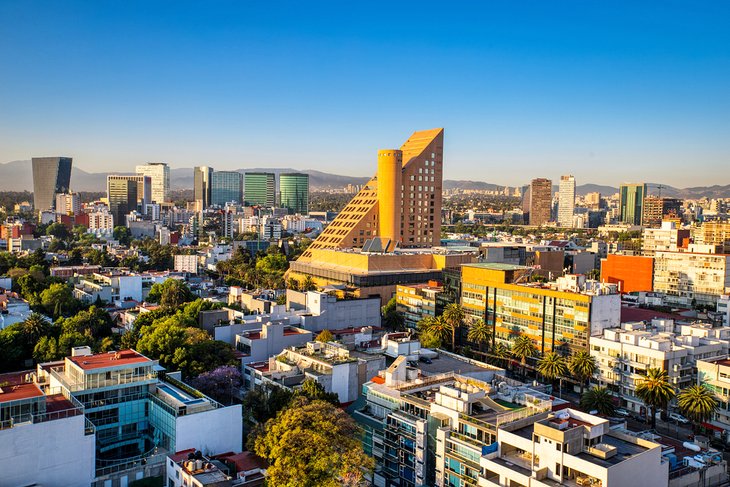
When it comes to the original "in vogue" destination in Mexico City, Polanco is at the top of the list. This swanky, glitzy, expensive neighborhood has always been about high style, fine dining, and fabulous hotels. Within the neighborhood are countless shops and restaurants, as well as a corner of Chapultepec Park .
If you're looking for one of the most up-scale destinations in Latin America, Polanco certainly takes the lead. The neighborhood's main artery is the Avenida Presidente Masaryk , which is often likened to the 5th Avenue of Mexico City. It's easy to see why when you see art gallery after art gallery, fine dining after fine dining, shopping malls, and gorgeous hotels.
Start at the Antara Fashion Hall , where you'll find all the brand names, from Hugo Boss to Carolina Herrera. You can also visit the Siqueiros Public Art Room, where muralist David Siquieros hosts workshops, talks, conferences, and exhibitions. You can also pop into Chapultepec Park for a lovely little afternoon picnic.
In the evening, snag a reservation at the legendary Pujol restaurant before heading to the Telcel Theatre for a Spanish-language performance of one of the Broadway greats.
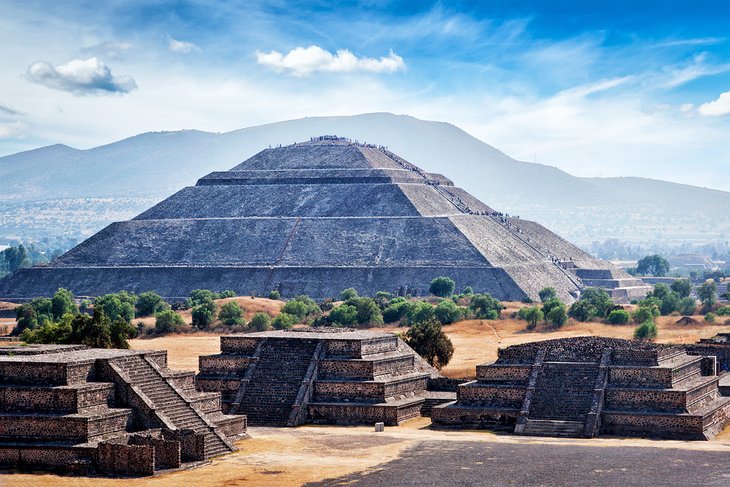
Perhaps one of the most culturally and historically significant sites in Mexico City, the archeological zone at Teotihuacan tells so much of the story of the birth of Mexico.
The ancient site, a UNESCO World Heritage Site , was settled around 400 BCE and rose to be one of the most powerful cities in the region. It is still a mystery how the city came to be, but several theories exist surrounding earlier tribes that could have contributed to the city's growth. In the 15th century, the Aztecs claimed the city, naming it Teotihuacan.
Today what remains of Teotihuacan's eight square miles are 2,000 single-story apartment compounds, pyramids, temples, and palaces. It is known for its iconic Pyramid of the Sun and Pyramid of the Moon. The Pyramid of the Sun is the largest structure in Teotihuacan and faces west, measuring roughly 720 feet by 760 feet.
Priests at Teotihuacan were known to practice human and animal sacrifice. In fact, archeologists discovered 18 sacrificial victims buried around some of the temples, including the Pyramid of the Moon.
Today visitors can explore Teotihuacan on their own or as part of a tour. The archeological site is just 30 miles outside Mexico City.
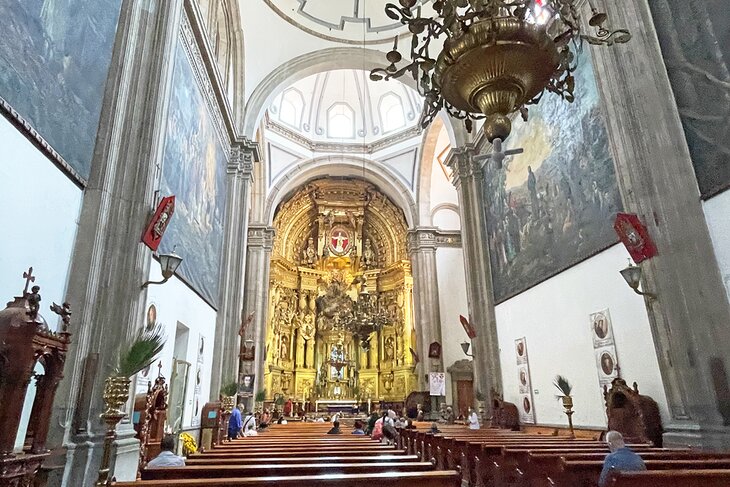
Along Madero Street (the street that leads to the Zocalo), you'll find the stunning Church of San Francisco. It's directly across the street from The House of Tiles. This beautiful, historic convent was once at the heart of a sprawling church and monastery complex. Today, all that remains is the church.
Still, what remains is a spectacular site to behold. Just look at the beautifully carved doorway, which dates back to the 18th century. The reddish bricks that you see to the right are stones that were used originally to build the Aztec buildings that once made up Moctezuma's private zoo.
When first constructed, the church was one of the earliest and most powerful Franciscan monasteries in the city. It also held the first 12 Franciscan friars who arrived in what was then "New Spain."
The church that exists today is actually the third to be built here and dates back to the early 18th century. Services are still held today.
Address: Av Francisco I. Madero 7, Centro Histórico de la Cdad. de México, Centro, Cuauhtémoc, 06000 Ciudad de México, CDMX, Mexico
If you're traveling to Mexico City for the first time, the best area to stay is in the historic city center (Centro Histórico de la Ciudad). This UNESCO World Heritage Site centers around the Zócalo, with the Metropolitan Cathedral, National Palace, and Templo Mayor.
The affluent Polanco neighborhood, also makes a great base, with its luxury hotels and upscale restaurants. It's about a 30-minute drive from the Centro Histórico, but near all the attractions of Chapultepec Park and the famous shopping street, Paseo de la Reforma. Here are some highly rated hotels in these convenient locations:
Luxury Hotels:
- If you like grand historic hotels, the Gran Hotel Ciudad de Mexico in the Centro Histórico has affordable rates and an unbeatable location, within walking distance of the major historical attractions and with a rooftop terrace overlooking the Zócalo.
- A dazzling stained-glass ceiling caps the elegant lobby. In the quieter Polanco neighborhood, a short stroll from Chapultepec Park, JW Marriott Hotel Mexico City features a full-service spa and outdoor pool.
- Near Polanco and just a short walk to the Chapultepec Castle, the St. Regis overlooks Paseo de la Reforma and occupies a sleek modern building with contemporary decor to match.
Mid-Range Hotels:
- A 10-minute walk to Zócalo, near restaurants and shops, the boutique Historico Central , in a beautifully restored 18th-century building, blends history with modern decor and thoughtful added touches such as artisan soaps.
- Also in a historic building is the Hampton Inn & Suites Mexico City - Centro Historico , featuring a gorgeous stained-glass ceiling. It lies within walking distance of the Zócalo, Alameda Cathedral, and the Palacio de Bellas Artes.
- The name says it all when it comes to location at the Zocalo Central , in an elegant building dating from the late 19th century. Some rooms score a bird's-eye view over this famous square.
Budget Hotels:
- Near the Palacio de Bellas Artes, a 20-minute walk from the Centro Histórico, the good-value One Ciudad De Mexico Alameda has clean, compact rooms and free breakfast.
- A few blocks from Paseo de la Reforma, Hotel Bristol is popular for its friendly service and comfortable rooms, while the modern City Express Plus Reforma El Angel is a short cab ride away from the historical center.
Taking an organized tour is the best way to see Mexico City's top attractions and a convenient way to enjoy day trips to surrounding sites. Guided tours save you time navigating the city's traffic-clogged streets, plus you can learn about the history and culture of the city. These sightseeing tours all include expert guides, entrance fees, and round-trip transportation.
- Coyoacán, National University, and Frida Kahlo Museum: Mexico City's art, history, and nature are covered on the full-day Mexico City Super Saver Tour . This 11-hour excursion begins with a tour through the cobblestone streets of the evocative colonial city of Coyoacán, including a visit to the Frida Kahlo Museum and National University. Top off your city sightseeing adventure with a relaxing boat tour along the canals of the UNESCO-listed ecological reserve Xochimilco.
- Teotihuacan Pyramids: On the eight-hour Early Morning Teotihuacan Pyramids Tour , you'll be one of the first visitors to gain access to this UNESCO-listed archaeological park. Better still, a private archaeologist guides you through the top sites, including the Palace of Quetzalpapalotl, Sun Pyramid, and Moon Pyramid. After exploring these ancient temples, the tour takes you to an obsidian workshop to see local artisans at work.
- Iztaccihuatl Volcano: Avid hikers can enjoy spectacular views of Popocatepetl and the Valley of Mexico on the Iztaccihuatl Volcano Hiking Tour from Mexico City . This 12-hour tour includes a hike up the intermediate trail of this dormant volcano, stopping short of the 5,230-meter summit to admire the panorama.
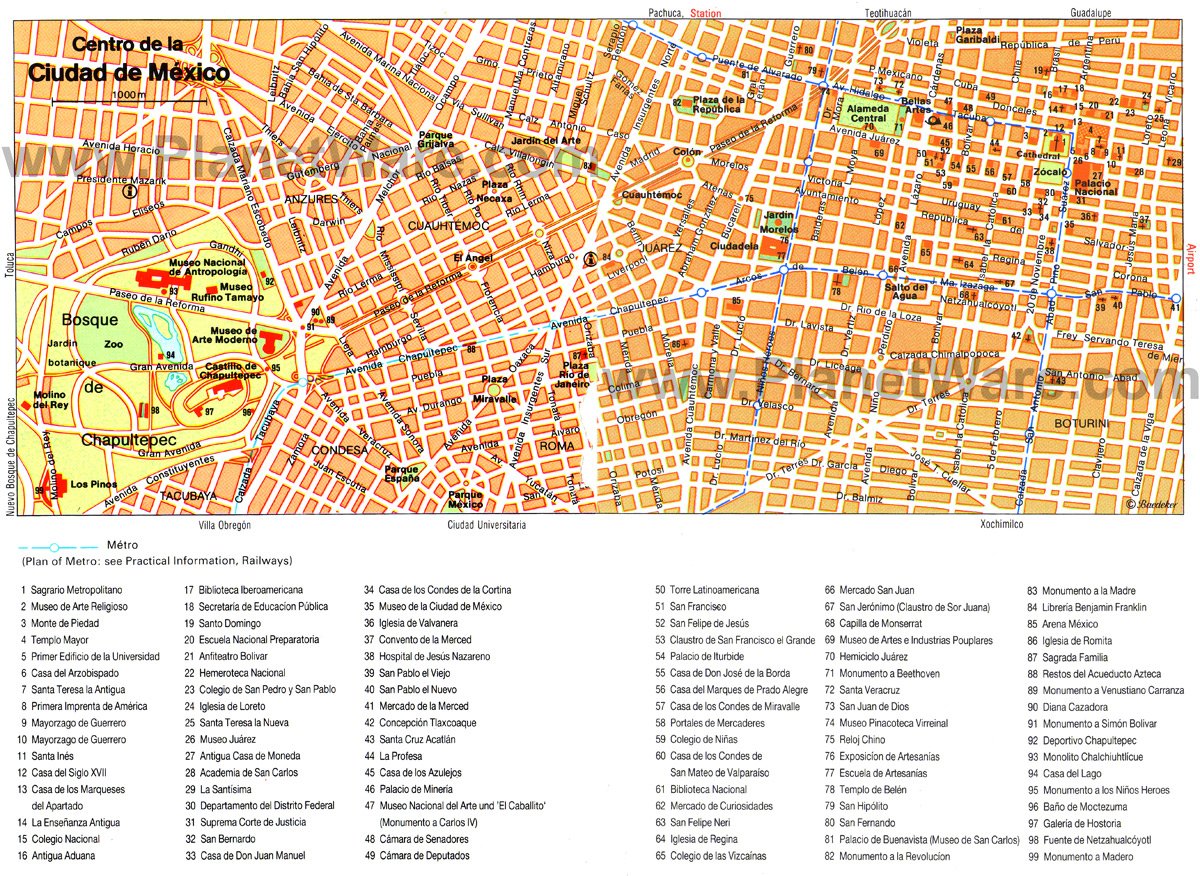
More on Mexico
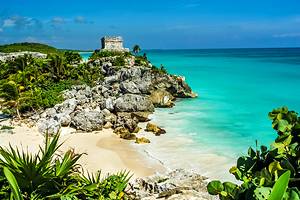
Mexico City Travel Guide
Courtesy of Torresigner | Getty Images

16 Best Things To Do in Mexico City
Mexico City, officially known as Ciudad de México (CDMX), is a growing and vibrant metropolis nestled in the heart of Mexico. The capital city of Mexico offers a blend of history, culture and gastronomy that attracts millions of annual visitors. From
- All Things To Do

Museo Nacional de Antropología Museo Nacional de Antropología
Located within the sprawling Chapultepec Forest , the Museo Nacional de Antropología (National Museum of Anthropology) showcases artifacts from Mexico's pre-Columbian era, dating from about 100 B.C. to A.D. 1521. Housed within the facility’s 22 rooms are artifacts, including the famous Aztec Calendar Stone, known as Piedra del Sol, as well as the ancient statue of Xochipilli, the Aztec god of art, games, beauty, dance and maize (among others). The museum offers a look at how tradition, culture and life were formed in all regions of Mexico, and it also educates visitors on how Mexico’s indigenous descendants live today.
Past visitors said this is a must-see if you’re interested in the ancient cultures of Mexico/Mesoamerica. Reviewers appreciated that the explanatory text features English translations. The museum is so extensive that many travelers said you can spend a whole day exploring the many collections and exhibits and recommend giving yourself plenty of time to visit. As one of the largest and most visited museums in Mexico, the grounds are also home to a gift shop, a cafeteria and the National Library of Anthropology and History.

Bosque de Chapultepec Bosque de Chapultepec free
The main park in Mexico City, Bosque de Chapultepec (Chapultepec Forest) was once the temporary home of the Aztec empire after its citizens migrated to modern-day Mexico City in the 13th century. Today, the 1,600-acre Chapultepec is Mexico City's largest park and is popular among families seeking respite from the busy and crowded city.
Divided into three sections, the park is home to many cultural interests, such as the presidential residence, the former presidential palace, a zoo and several museums (including the highly recommended Museo Nacional de Antropología ). The park also hosts numerous military monuments and effigies of Aztec kings, as well as restaurants and playgrounds, plus lots of green space for stretching. What's more, the park features a large lake, where visitors and locals alike can rent pedal boats to cruise around the water (a particular highlight for kids). On the weekends, local vendors fill the park and sell everything from souvenirs to art to snacks.

Palacio de Bellas Artes Palacio de Bellas Artes free
Considered the cultural center of Mexico City, the Palacio de Bellas Artes (Palace of Fine Arts) is a must-visit. The exterior of this 20th-century palace showcases art nouveau and art deco-style architecture, while the inside features marble floors and vaulted glass windows.
In addition to its architectural grandeur, the building hosts cultural events in the national theater, including music, dance, theater, opera and literary performances. The museum at the palace also houses several famous murals, including the work of the famous Mexican muralist Rufino Tamayo. On the top floor, you'll find the National Museum of Architecture, which showcases the work and lives of famous Mexican architects, and multiple art museums and galleries.

Popular Tours

Hot Air Balloon Flight over Teotihuacan, from Mexico City
(1797 reviews)
from $ 159.37

Balloon flight with pick up in CDMX + Breakfast in a natural cave
(964 reviews)
from $ 171.17

Full-Day Tour Exploring the Waters of Tolantongo
(581 reviews)
from $ 149.00

Zócalo (Plaza de la Constitución) Zócalo (Plaza de la Constitución) free
U.S. News Insider Tip: The Zócalo attracts throngs of visitors and locals, so visit in the early morning or afternoon during a weekday to avoid the heaviest crowds. – Kayla Hui
Officially known as Plaza de la Constitución, El Zócalo is the main public square and one of the most recognizable places in Mexico City. It’s also one of the world’s largest city squares. It contains a giant Mexican flag at its center and has been the centerpiece of public gatherings since the days of the Aztec empire (it was considered the ceremonial center of Tenochtitlán). The site also hosts annual, widely attended religious events during Holy Week and for Corpus Christi, as well as fairs, concerts, and parades. Several historic buildings also border the square, including the city's national cathedral , the National Palace and federal buildings.

Museo Frida Kahlo Museo Frida Kahlo
One of the best-known museums in Mexico City exhibits the life and work of its most famous artist: Frida Kahlo. The museum, located in the Coyoacan suburb, is also known as La Casa Azul (The Blue House), and was Kahlo's former residence. It hosts some impressive examples of her works, but travelers say that the best part of visiting the house is seeing where the artist lived and painted with her husband, artist Diego Rivera. Along with paintings by both artists, folk art, photos, documents, books and furnishings, the house also displays personal objects.
Recent visitors to the property said it's a must-see for fans of the artist, saying it shows her life and work in a very personal light. Reviewers were particularly impressed with the display of her clothing and dresses. If you want to take photos, there is an additional modest “permit” fee.

Basílica de Santa María de Guadalupe Basílica de Santa María de Guadalupe free
U.S. News Insider Tip: During the summer months, pack a hat and water bottle (there is little shade within the complex). If you plan to use the bathroom on site, bring a couple of pesos with you to use the bathroom and buy toilet paper. – Kayla Hui
The Basílica de Santa María de Guadalupe (Basilica of Our Lady of Guadalupe) is an important religious site in Mexico City. Construction for the first shrine built to honor the Virgin Mary of Guadalupe started in 1695 on Tepeyac Hill. However, nearly 300 years' worth of construction and environmental damage threatened the integrity of the basilica, so a new basilica was built on the same plaza in the 1970s.

Templo Mayor Templo Mayor
Before Spanish colonization, Templo Mayor served as the religious center for the Aztec people. When Spanish conquistadors arrived in the early 16th century, the temple was among many structures that were destroyed and a new cathedral was built on top of the ruins. It wasn't until 1978 that the temple dedicated to the Aztec gods Huitzilopochtli and Tláloc (gods of war and water) was unearthed in the heart of Mexico City. Today, the area remains an active archeological site and the adjoining museum houses thousands of artifacts, including 2,500 wooden objects from the site.
Recent visitors said it's fascinating to see the ancient ruins that are tucked away in the center of the city. Many said it's worth spending time in the museum as well, but the site and scale can't match up to the massive Museo Nacional de Antropología . Still, the whole complex has been deemed a UNESCO World Heritage Site and is one of Mexico City's most popular attractions. If you’re visiting during the summer months, travelers suggest you time your visit for the morning to avoid the sweltering midday heat. Reviewers also warn that most of the information is listed in Spanish only.

Museo de Arte Popular Museo de Arte Popular
U.S. News Insider Tip: Ditch the large bags and water bottles prior to your visit as you may be denied entry. – Kayla Hui
This folk art museum features handicrafts from all across Mexico and details the country's history and its many cultures. If you want to find out more about the country’s indigenous communities, this is the place to go, according to travelers. Exhibits include glasswork from Tecali, pottery from Michoacán, masks from Chiapas and alebrijes , the colorful painted animal figures from Oaxaca, among other treasures. Make sure to take time to admire the building itself – the 1920s art deco building was the former headquarters of the fire department.

Balloon flight in Teotihuacán + Pick up CDMX + Breakfast in cave.
(701 reviews)
from $ 165.21

Xochimilco, Coyoacán & Frida Kahlo Museum
(5713 reviews)
from $ 40.80

Teotihuacan, Guadalupe Shrine, Tlatelolco & Tequila Tasting
(8348 reviews)
from $ 45.60

Chalpultepec Castle Chalpultepec Castle
U.S. News Insider Tip: Sundays are free for all residents of Mexico and expats living in Mexico, so try to avoid visiting that day if you can. It can get crowded, so it’s recommended to go in the morning when the castle first opens. – Kayla Hui
Constructed beginning in 1725, Chalpultepec Castle has served many purposes in its centuries of use; it was a military academy, an observatory, and the only castle in North America to house rulers, including Emperor Maximilian I and his wife Empress Carlota. It would later be established as the National Museum of History by Lázaro Cárdenas in 1939, which would open the castle to visitors. Located at the entrance of Chalpultepec Park , it’s a historical site that can’t be missed on your next visit to Mexico City.

Catedral Metropolitana Catedral Metropolitana free
Mexico's national cathedral – the vaulting, austere, ornate church on the Zócalo' s north end – was once the site of an ancient Aztec precinct, so it has housed the city's spiritual core for centuries. The cathedral was built between 1573 and 1813 after the Spanish conquest of Tenochtitlan and is considered one of Mexico City's many must-see attractions. What’s more, the cathedral is one of the largest churches in Latin America. It’s believed that the materials used to construct the church were taken from the destroyed pyramids and structures belonging to the Aztecs. Highlights of the massive cathedral include five naves, 14 chapels, two of the largest 18th-century organs in the Americas, 150 windows and a painting by famed Spanish artist Bartolome Esteban Murillo.
Depending on your interest in Mexican history and architecture, you could spend anywhere from an hour to a half a day at the cathedral (it’s free to enter). Past visitors recommended paying to take a tour of the interior with a member of the cathedral’s staff, who reviewers say offer a wealth of information about the cathedral’s far-reaching history. According to recent visitors, tours cost approximately 100 Mexican pesos (about $6). Recent visitors said the massive structure is stunning to behold, and even if you don't want to take the time to explore the inside, it's worth the photo-op of the exterior. The cathedral is open daily from 9 a.m. to 5:30 p.m. and admission is free. Many of the best Mexico City walking tours make stops here, which can be another way to hear an in-depth retelling of the cathedral’s history and significance. For more information, including Mass times, visit the cathedral's website (in Spanish).

Museo Soumaya Museo Soumaya free
From exceptional architecture to more than 66,000 featured works, Museo Soumaya is one of Mexico City’s most iconic museums. Established in 1994, Museo Soumaya’s main goal is to preserve and exhibit Mexico and Europe’s artistry. Currently, it houses the largest collection of works by Auguste Rodin outside of France, in addition to artwork by Diego Rivera, Titian, Picasso, Monet and more.
Beyond the art, the architecture alone is worth seeing. The exterior of the six-story building is wrapped in mirrored hexagons, and the building is the brainchild of Mexican architect Fernando Romero. Recent travelers say Museo Soumaya is reminiscent of New York City’s Guggenheim (both museums are architecturally stunning and feature a circular interior with each floor organized by art type). Some reviewers recommend starting your visit at the top and winding your way down.

Palacio Nacional Palacio Nacional free
The National Palace holds the federal executive branch of the Mexican government and sits along Mexico City's main public square, El Zócalo . The palace itself is a massive, ornate building that contains several gardens, murals and fountains in the Spanish Renaissance architectural style. Its highlights are several Diego Rivera murals painted in panoramic style across the palace's walls, which past visitors say are a must-see. These murals depict the stages of Mexican history, from pre-Columbian days to the current age.
Because the Mexican president lives and works within the palace, visitors can only access the site on a guided tour. Tours are free, but can’t be booked in advance online. According to recent visitors, you must go to the ticket office at the Museum of Art of the Ministry of Finance & Public Credit, where you can inquire about tour availability and make reservations in person (this is also where tours depart from). Some reviewers reported success booking tickets in advance by emailing [email protected] with information about the preferred tour date and number of people attending. Along the approximately hourlong tours, you’ll see the Rivera mural collections and the courtyards. You may also get the chance to glimpse the exterior of the legislative chambers.

Museo Casa Luis Barragán Museo Casa Luis Barragán
Luis Barragán was a prominent Mexican architect renowned for his modernist style, and his former home – which was first constructed in 1947 and now functions as a museum – is one of the finest examples of his work. The museum is an off-the-beaten-path attraction that travelers say will please all, even those not schooled in architectural history. The house is known for its vivid colors, brilliant use of natural light and its impressive garden with a maze of corridors and trees. In 2004, it was designated a UNESCO World Heritage Site.
Recent visitors said the history of the house, in addition to its interesting architecture, is captivating. However, a handful of recent reviewers were disappointed with the ticket reservation process. To visit, you must book a self-guided or guided tour (available in Spanish and English). Self-guided visits are only available on Thursdays at select times. Tickets for self-guided tours cost 450 Mexican pesos (about $26) per person (note that children 12 and younger are not permitted in the house). Guided tours are available at select times Monday through Wednesday, Friday and Saturday Tickets for guided tours cost more. Tickets are released every Tuesday at noon (Mexico City time).

Balloon Flight and Teotihuacan Tour w / Breakfast from Mexico City
(33 reviews)
from $ 140.24

Lucha Libre Tickets & Tacos & Beer & Mezcal - BEST NIGHT EVER!
(366 reviews)
from $ 91.49

Teotihuacan Private Tour from Mexico City
(1153 reviews)
from $ 126.25

Torre Latinoamericana Torre Latinoamericana
Open since 1956, Torre Latinoamericana, the 44-story skyscraper in Centro Histórico, is the place to go if you want the best views of the city. Similar to the Empire State Building in New York City , this tower offers visitors jaw-dropping views from its observation deck and restaurant, making it the perfect opportunity to pull out your camera for that Instagram-worthy picture.
Recent visitors recommended heading up to the top of the tower during sunset to admire the shifting light as it illuminates buildings like the neighboring Palace of Fine Arts. Travelers also warned that if smog levels are high, you won’t be able to see much from the tower’s peak. Some reviewers recommend spending time in the on-site museum, which details the history of Mexico City and the construction of the tower.

Teotihuacán Teotihuacán
U.S. News Insider Tip: There is no shade inside the archeological site, so you’ll want to wear a hat. It’s also helpful to have a small backpack to hold a water bottle, sunscreen and toilet paper to use in the washrooms at the site. – Kayla Hui
One of many UNESCO World Heritage Sites in the Mexico City region, Teotihuacán ( teh -o-tee-wa- can ) contains some of the largest pre-Hispanic pyramids in all of Mexico. The site contains many popular constructions, including the Palace of the Plumed Butterfly, which showcases various columns of winged creatures, and the awesome Pyramid of the Sun, which sits at the heart of the small city. The nearby museum, Museo de la Sitio, also holds many artifacts from the period.

Universidad Nacional Autónoma de México (UNAM) Universidad Nacional Autónoma de México (UNAM) free
The Universidad Nacional Autónoma de Mexico (Central University City Campus of the National University of Mexico) includes 32 academic programs, the Mexican Olympic stadium, a Mexican cultural center, a nature preserve and the city's Central Library. The main campus is now designated a UNESCO World Heritage Site.
The city's famous muralists have made their mark on the campus, and travelers recommend you check out the work of famous painter David Alfaro Siqueiros at the Rectorate Tower or the work of Juan O'Gorman at the Central Library. The campus also holds the University Museum of Contemporary Art, an excellent spot for viewing Mexico's more recent cultural offerings. The sculpture garden at the art museum is a particular highlight for past visitors, as is the botanic garden.

Things to Do in Mexico City FAQs
Explore more of mexico city.

Best Hotels

When To Visit
If you make a purchase from our site, we may earn a commission. This does not affect the quality or independence of our editorial content.
Recommended
The 28 Best Water Parks in the U.S. for 2024
Holly Johnson|Timothy J. Forster May 8, 2024

The 18 Best Napa Valley Wineries to Visit in 2024
Lyn Mettler|Sharael Kolberg April 23, 2024

The 25 Best Beaches on the East Coast for 2024
Timothy J. Forster|Sharael Kolberg April 19, 2024

The 50 Best Hotels in the USA 2024
Christina Maggitas February 6, 2024

The 32 Most Famous Landmarks in the World
Gwen Pratesi|Timothy J. Forster February 1, 2024

9 Top All-Inclusive Resorts in Florida for 2024
Gwen Pratesi|Amanda Norcross January 5, 2024

24 Top All-Inclusive Resorts in the U.S. for 2024
Erin Evans January 4, 2024

26 Top Adults-Only All-Inclusive Resorts for 2024
Zach Watson December 28, 2023

Solo Vacations: The 36 Best Places to Travel Alone in 2024
Lyn Mettler|Erin Vasta December 22, 2023

26 Cheap Beach Vacations for Travelers on a Budget
Kyle McCarthy|Sharael Kolberg December 4, 2023

Travel, Tourism & Hospitality
Travel and tourism in Mexico - Statistics & Facts
Tourism in mexico during covid-19, international and domestic tourism in mexico, key insights.
Detailed statistics
Share of tourism contribution to GDP in Mexico 2010-2022
Tourism spending in Mexico 2010-2022, by type
Quarterly tourism workforce in Mexico 2018-2023
Editor’s Picks Current statistics on this topic
Inbound tourism volume in Mexico 2016-2022
Largest hotel companies in Mexico 2022, based on revenue
Further recommended statistics
- Premium Statistic Countries in the Americas with the highest inbound tourist arrivals 2019-2022
- Basic Statistic Number of tourism jobs in Latin American countries 2022
- Basic Statistic Number of Latin American and Caribbean World Heritage Sites 2022, by country
- Premium Statistic Leading global countries in the Travel & Tourism Development Index 2023
- Premium Statistic Leading countries in the Americas in the Travel & Tourism Competitiveness Index 2023
Countries in the Americas with the highest inbound tourist arrivals 2019-2022
Countries with the highest number of international tourist arrivals in the Americas from 2019 to 2022 (in millions)
Number of tourism jobs in Latin American countries 2022
Number of jobs related to travel and tourism in Latin America in 2022, by country (in millions)
Number of Latin American and Caribbean World Heritage Sites 2022, by country
Number of World Heritage properties in Latin America and the Caribbean in 2022, by country
Leading global countries in the Travel & Tourism Development Index 2023
Leading countries in the Travel & Tourism Development Index (TTDI) worldwide in 2023
Leading countries in the Americas in the Travel & Tourism Competitiveness Index 2023
Leading countries in the Americas in the Travel & Tourism Development Index (TTDI) in 2023
Key economic figures
- Premium Statistic Share of tourism contribution to GDP in Mexico 2010-2022
- Premium Statistic Tourism GDP in Mexico 2010-2022
- Premium Statistic Tourism GDP in Mexico 2022, by activity
- Premium Statistic Tourism FDI in Mexico 2010-2022
- Premium Statistic Tourism establishments in Mexico 2010-2020
- Premium Statistic Quarterly tourism workforce in Mexico 2018-2023
Tourism sector as a percentage of gross domestic product in Mexico from 2010 to 2022
Tourism GDP in Mexico 2010-2022
Contribution of the tourism sector to the gross domestic product in Mexico from 2010 to 2022 (in billion Mexican pesos)
Tourism GDP in Mexico 2022, by activity
Contribution of the tourism sector to the gross domestic product in Mexico in 2022, by economic activity (in billion Mexican pesos)
Tourism FDI in Mexico 2010-2022
Foreign direct investment in the tourism sector in Mexico from 2010 to 2022 (in million U.S. dollars)
Tourism establishments in Mexico 2010-2020
Number of establishments in the tourism sector in Mexico from 2010 to 2020 (in 1,000s)
Number of employees in the tourism sector in Mexico from 1st quarter 2018 to 2nd quarter 2023 (in millions)
Tourism volume and expenditures
- Premium Statistic Inbound tourism volume in Mexico 2016-2022
- Premium Statistic Inbound tourism spending in Mexico 2016-2022
- Premium Statistic Per capita spending of inbound tourists in Mexico 2016-2022
- Premium Statistic Number of domestic hotel guests in Mexico 2010-2020
- Premium Statistic Domestic tourism spending in Mexico 2010-2022
- Premium Statistic Cruise passenger traffic in Mexico 2022, by port
- Premium Statistic Most visited archeological sites in Mexico 2022
- Premium Statistic Quarterly accommodation and holiday package spending in Mexico 2016-2020
Number of international tourists in Mexico from 2016 to 2022 (in millions)
Inbound tourism spending in Mexico 2016-2022
Expenditure of international tourists in Mexico from 2016 to 2022 (in billion U.S. dollars)
Per capita spending of inbound tourists in Mexico 2016-2022
Average expenditure per trip of international visitors in Mexico from 2016 to 2022 (in U.S. dollars)
Number of domestic hotel guests in Mexico 2010-2020
Number of domestic tourists in hotels in Mexico from 2010 to 2020 (in millions)
Domestic tourism spending in Mexico 2010-2022
Expenditure of domestic tourists in Mexico from 2010 to 2022 (in billion Mexican pesos)
Cruise passenger traffic in Mexico 2022, by port
Number of cruise passengers in Mexico in 2022, by port (in 1,000s)
Most visited archeological sites in Mexico 2022
Most popular archeological sites in Mexico in 2022, by number of visitors (in 1,000s)
Quarterly accommodation and holiday package spending in Mexico 2016-2020
Quarterly expenditure on accommodation and tour packages in Mexico between 2016 and 2020 (in billion Mexican pesos)
Hotel industry
- Premium Statistic Number of hotels in Mexican states 2023
- Premium Statistic Largest hotel companies in Mexico 2022, based on revenue
- Premium Statistic Hotel room occupancy in Mexico 2010-2022
- Premium Statistic Hotel room occupancy rate in Mexico 2019-2022, by type of location
- Premium Statistic Occupancy rates in key Mexican hotel markets 2022
- Premium Statistic Main tourist destinations in Mexico 2020-2022, by number of occupied rooms
- Basic Statistic Top Mexican resorts 2023, by user ratings
Number of hotels in Mexican states 2023
Number of hotel establishments in Mexico as of June 2023, by federal state
Leading companies in the hotel industry in Mexico in 2022, by net revenue (in billion Mexican pesos)
Hotel room occupancy in Mexico 2010-2022
Occupancy rate of hotel rooms in Mexico from 2010 to 2022
Hotel room occupancy rate in Mexico 2019-2022, by type of location
Room occupancy of hotel establishments in Mexico from 2019 to 2022, by type of location
Occupancy rates in key Mexican hotel markets 2022
Tourist destinations with highest hotel room occupancy in Mexico in 2022
Main tourist destinations in Mexico 2020-2022, by number of occupied rooms
Leading travel destinations for overnight tourism in Mexico from 2020 to 2022, by number of occupied hotel rooms
Top Mexican resorts 2023, by user ratings
Best-rated resorts in Mexico in 2023, based on user scores
Traveler preferences
- Premium Statistic Most popular holiday destination type for Mexicans 2022
- Premium Statistic Most popular domestic holiday destinations in Mexico 2022
- Premium Statistic Favorite aspects of domestic holiday trips for Mexicans 2022
- Premium Statistic Favorite aspects of outbound holiday trips for Mexicans 2022
- Premium Statistic Favorite type of holidays for Mexicans 2022
- Premium Statistic Breakdown of Mexican holidaymakers 2022, by travel companion
Most popular holiday destination type for Mexicans 2022
Most common type of travel destination for leisure travelers from Mexico as of June 2022
Most popular domestic holiday destinations in Mexico 2022
Most common domestic travel destinations in Mexico as of June 2022
Favorite aspects of domestic holiday trips for Mexicans 2022
Preferred amenities of domestic leisure tourists in Mexico as of June 2022
Favorite aspects of outbound holiday trips for Mexicans 2022
Preferred amenities of international leisure tourists from Mexico as of June 2022
Favorite type of holidays for Mexicans 2022
Preferred type of vacation trips by tourists from Mexico as of June 2022
Breakdown of Mexican holidaymakers 2022, by travel companion
Distribution of leisure tourists from Mexico as of June 2022, by travel companionship
Further reports
Get the best reports to understand your industry.
Mon - Fri, 9am - 6pm (EST)
Mon - Fri, 9am - 5pm (SGT)
Mon - Fri, 10:00am - 6:00pm (JST)
Mon - Fri, 9:30am - 5pm (GMT)
Watch CBS News
Who is Claudia Sheinbaum, elected as Mexico's first woman president?
Updated on: June 3, 2024 / 7:43 PM EDT / CBS/AP
Claudia Sheinbaum , who will be Mexico's first woman leader in the nation's more than 200 years of independence, captured the presidency by promising continuity.
The 61-year-old former Mexico City mayor and lifelong leftist ran a disciplined campaign capitalizing on her predecessor's popularity before emerging victorious in Sunday's vote, according to an official quick count. But with her victory now in hand, Mexicans will look to see how Sheinbaum, a very different personality from mentor and current President Andrés Manuel López Obrador , will assert herself.
While she hewed close to López Obrador politically and shares many of his ideas about the government's role in addressing inequality, she is viewed as less combative and more data-driven.
Sheinbaum's background is in science. She has a Ph.D. in energy engineering. Her brother is a physicist. In a 2023 interview with The Associated Press, Sheinbaum said, "I believe in science."

Observers say that grounding showed itself in Sheinbaum's actions as mayor during the COVID-19 pandemic , when her city of some 9 million people took a different approach from what López Obrador espoused at the national level.
While the federal government was downplaying the importance of coronavirus testing, Mexico City expanded its testing regimen. Sheinbaum set limits on businesses' hours and capacity when the virus was rapidly spreading, even though López Obrador wanted to avoid any measures that would hurt the economy. And she publicly wore protective masks and urged social distancing while the president was still lunging into crowds.
Mexico's persistently high levels of violence will be one of her most immediate challenges after she takes office Oct. 1. The country has seen a 150% uptick in violence, with 37 candidates assassinated during this election cycle, according to a report by the Mexico City-based consultancy Integralia. As CBS News' Enrique Acevedo reports, the murders were linked to cartels who control much of the drug trade in the United States.
On the campaign trail she said little more than that she would expand the quasi-military National Guard created by López Obrador and continue his strategy of targeting social ills that make so many young Mexicans easy targets for cartel recruitment.
"Let it be clear, it doesn't mean an iron fist, wars or authoritarianism," Sheinbaum said of her approach to tackling criminal gangs, during her final campaign event. "We will promote a strategy of addressing the causes and continue moving toward zero impunity."
Sheinbaum has praised López Obrador profusely and said little that the president hasn't said himself. She blamed neoliberal economic policies for condemning millions to poverty, promised a strong welfare state and praised Mexico's large state-owned oil company, Pemex, while also promising to emphasize clean energy.
"For me, being from the left has to do with that, with guaranteeing the minimum rights to all residents," Sheinbaum told the AP last year.
In contrast to López Obrador, who seemed to relish his highly public battles with other branches of the government and also the news media, Sheinbaum is expected by many observers to be less combative or at least more selective in picking her fights.
"It appears she's going to go in a different direction," said Ivonne Acuña Murillo, a political scientist at Iberoamerican University. "I don't know how much."
As one of the U.S.' most crucial economic partners, leaders in Washington will be watching closely to see which direction Mexico takes — "particularly in terms of Mexican stability and Mexican reliability for the U.S.," said political analyst Carlos Bravo Regidor.
Sheinbaum will also be the first person from a Jewish background to lead the overwhelmingly Catholic country.
- Claudia Sheinbaum
More from CBS News

Arlington professor witnesses history in Mexico as country elects first female president

Woman mayor killed in Mexico after Claudia Sheinbaum's presidential win

Rep. Sheila Jackson Lee announces pancreatic cancer diagnosis

Texas "redoubling" efforts at the southern border in response to Biden's immigration order
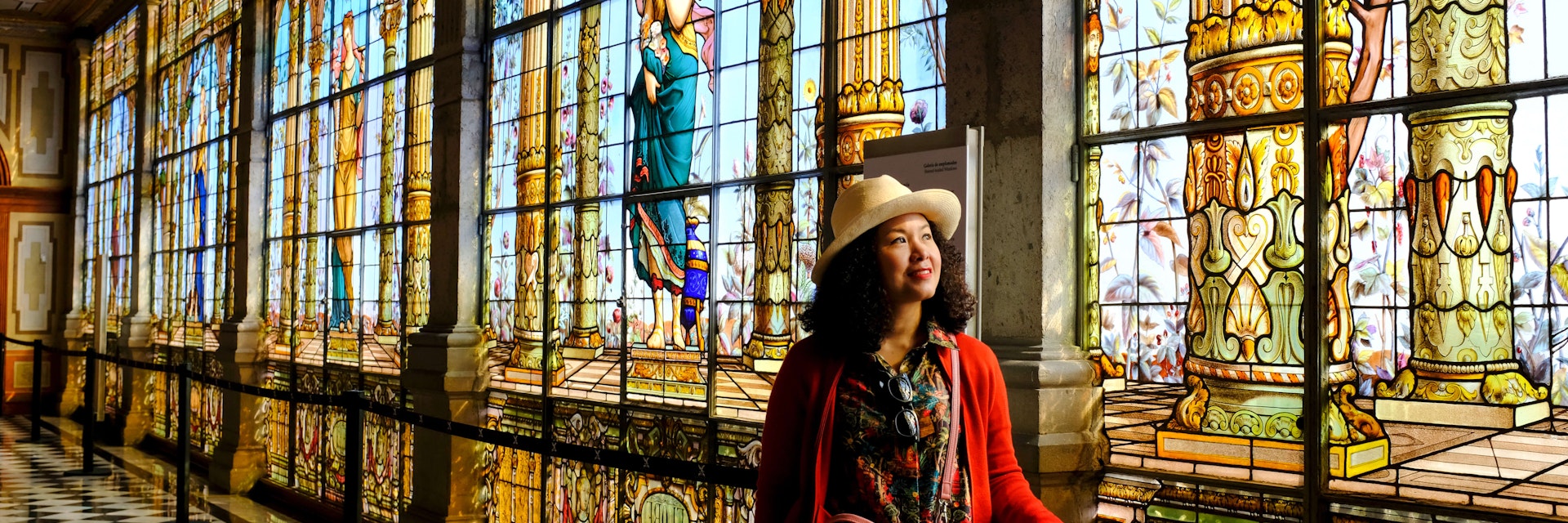
© Dowraik/Shutterstock

Mexico City
A high-octane megalopolis boasting old-school cantinas, intriguing museums, inspired dining and boating along ancient canals, Mexico City is the sun in the Mexican solar system.
Best Time to Visit
Best things to do, attractions, must-see attractions.

Palacio de Bellas Artes
Alameda Central
Immense murals by world-famous Mexican artists dominate the top floors of this splendid white-marble palace – a concert hall and arts center commissioned…
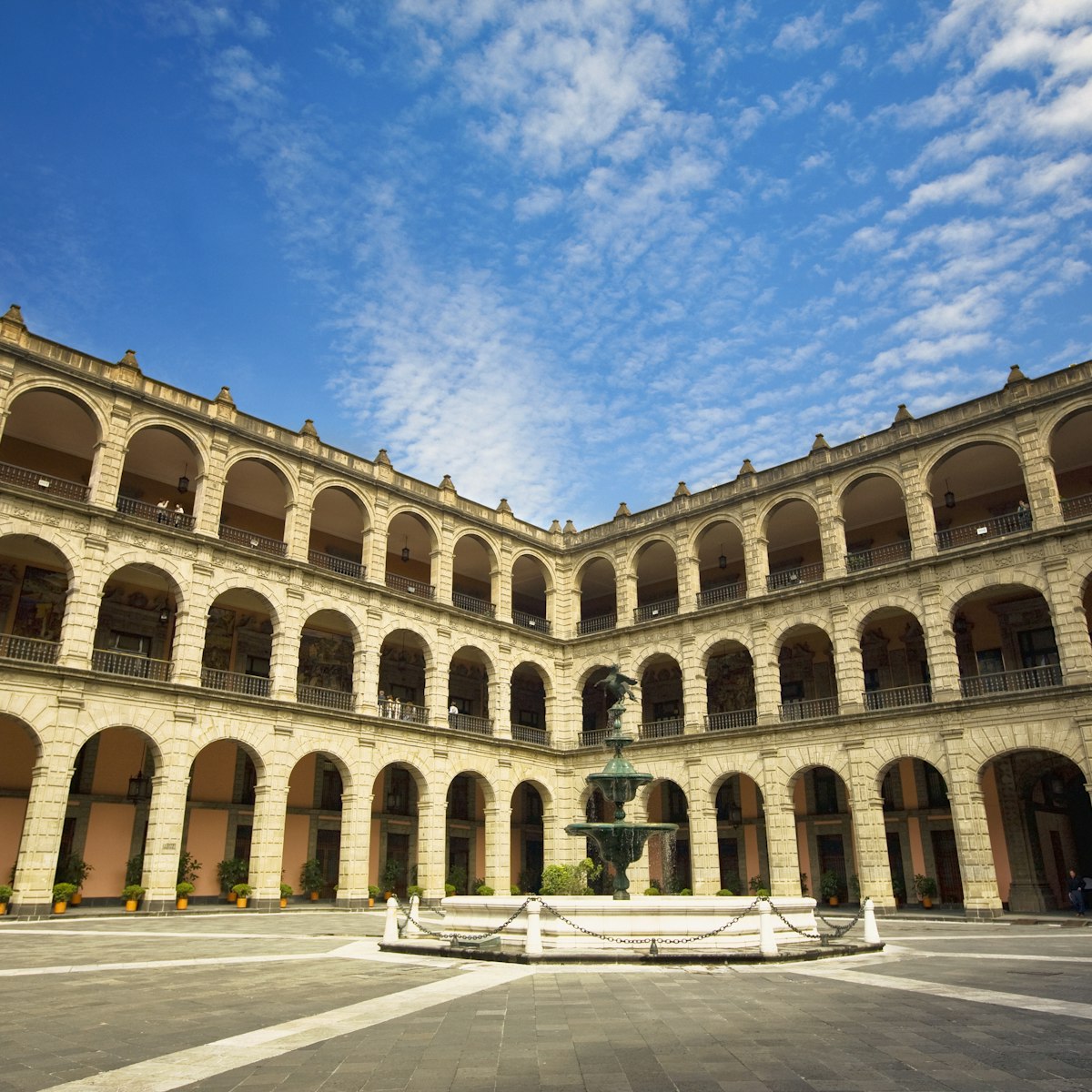
Palacio Nacional
Centro Histórico
As the seat of the federal branch of the Mexican government, the Palacio Nacional (National Palace) is home to the offices of the president of Mexico and…
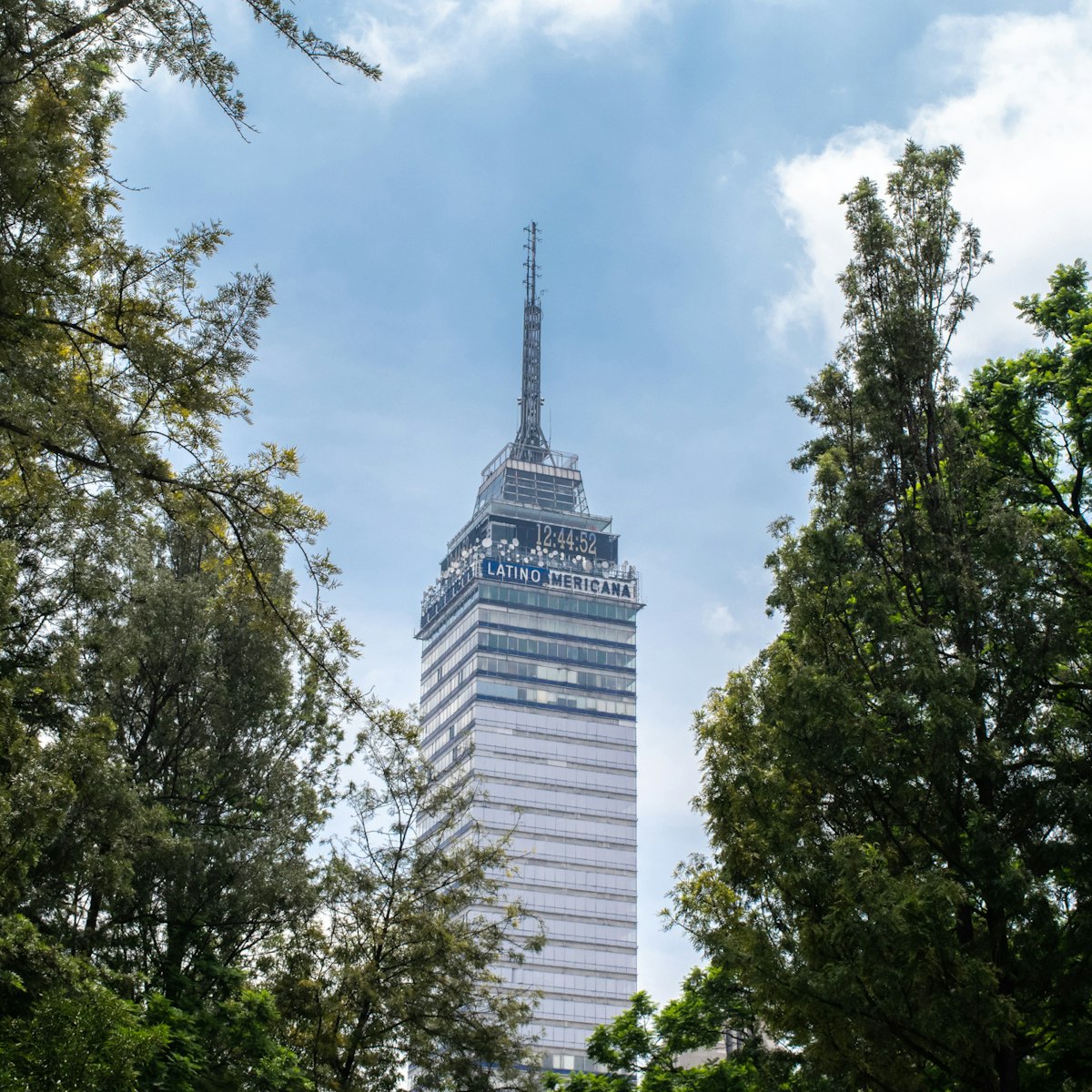
Torre Latinoamericana
The Torre Latinoamericana was Latin America’s tallest building when constructed in 1956, and remains the dominant focal point of Centro Histórico. It's an…

Museo Frida Kahlo
Coyoacán & San Ángel
Renowned Mexican artist Frida Kahlo was born in, and lived and died in, Casa Azul (Blue House), now a museum. Almost every visitor to Mexico City makes a…
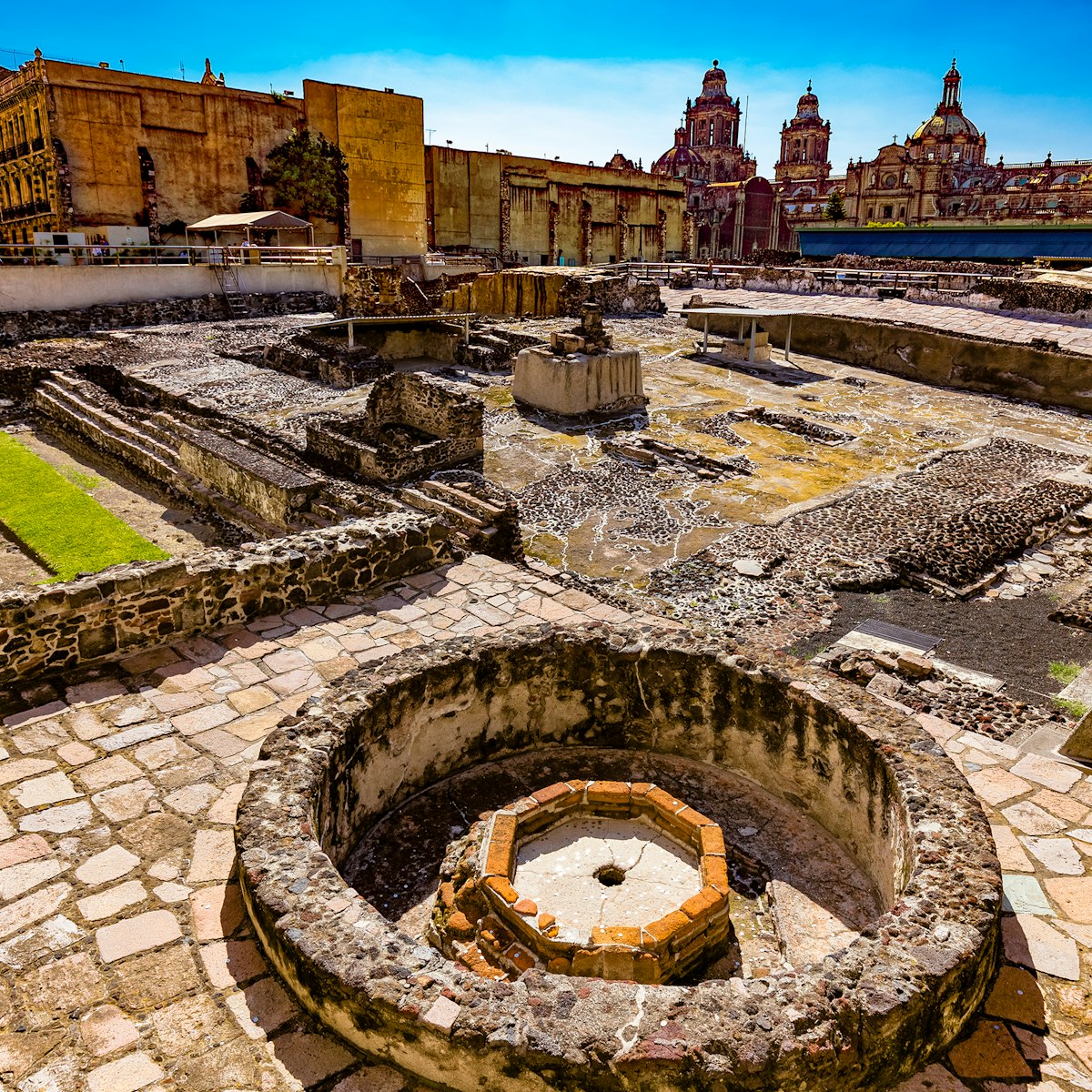
Templo Mayor
Before the Spaniards demolished it, the Aztec 'Great Temple' Teocalli of Tenochtitlán covered the site where the cathedral now stands, as well as the…
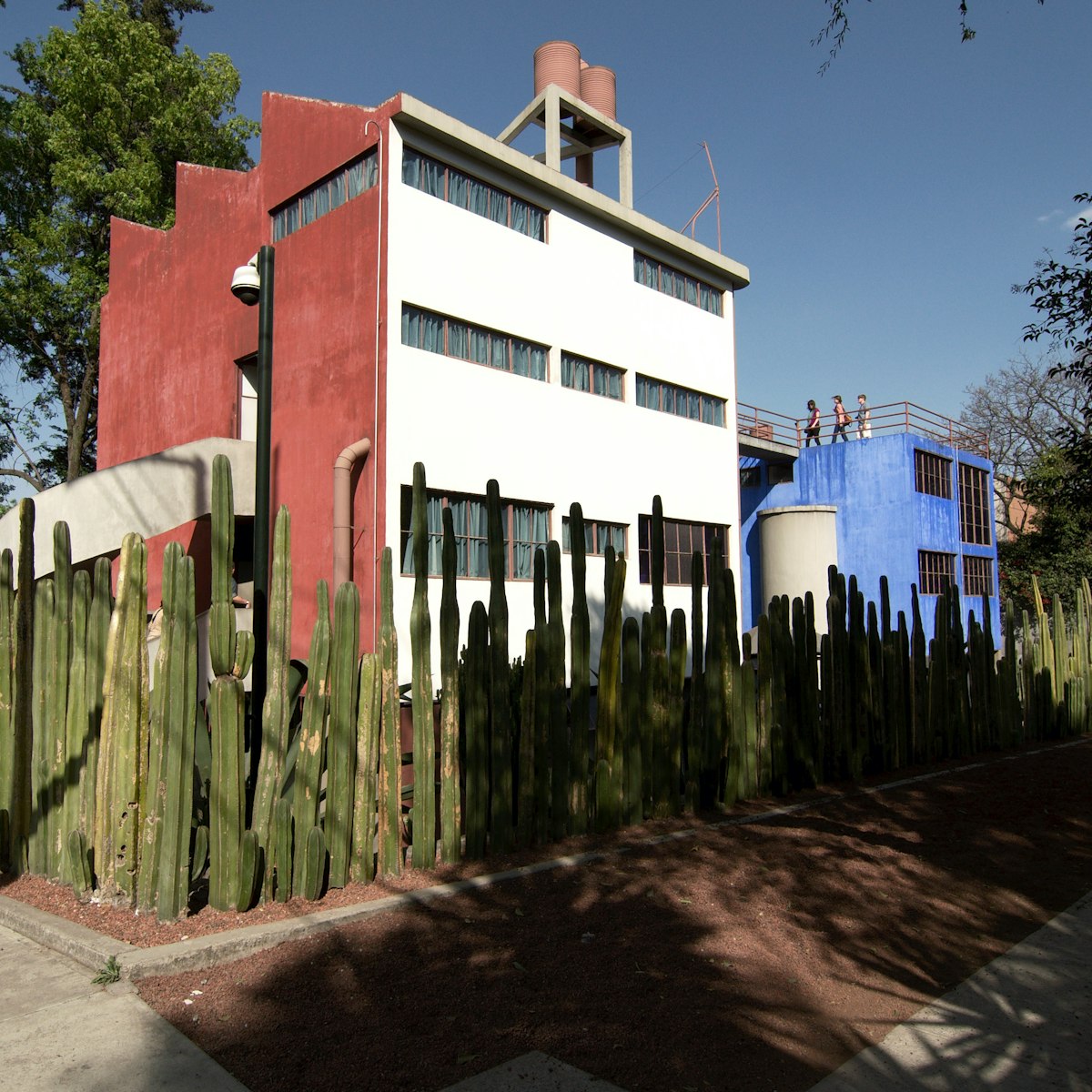
Museo Casa Estudio Diego Rivera y Frida Kahlo
If you saw the movie Frida (2002), you’ll recognize this museum, designed by Frida Kahlo and Diego Rivera's friend, architect and painter Juan O’Gorman…
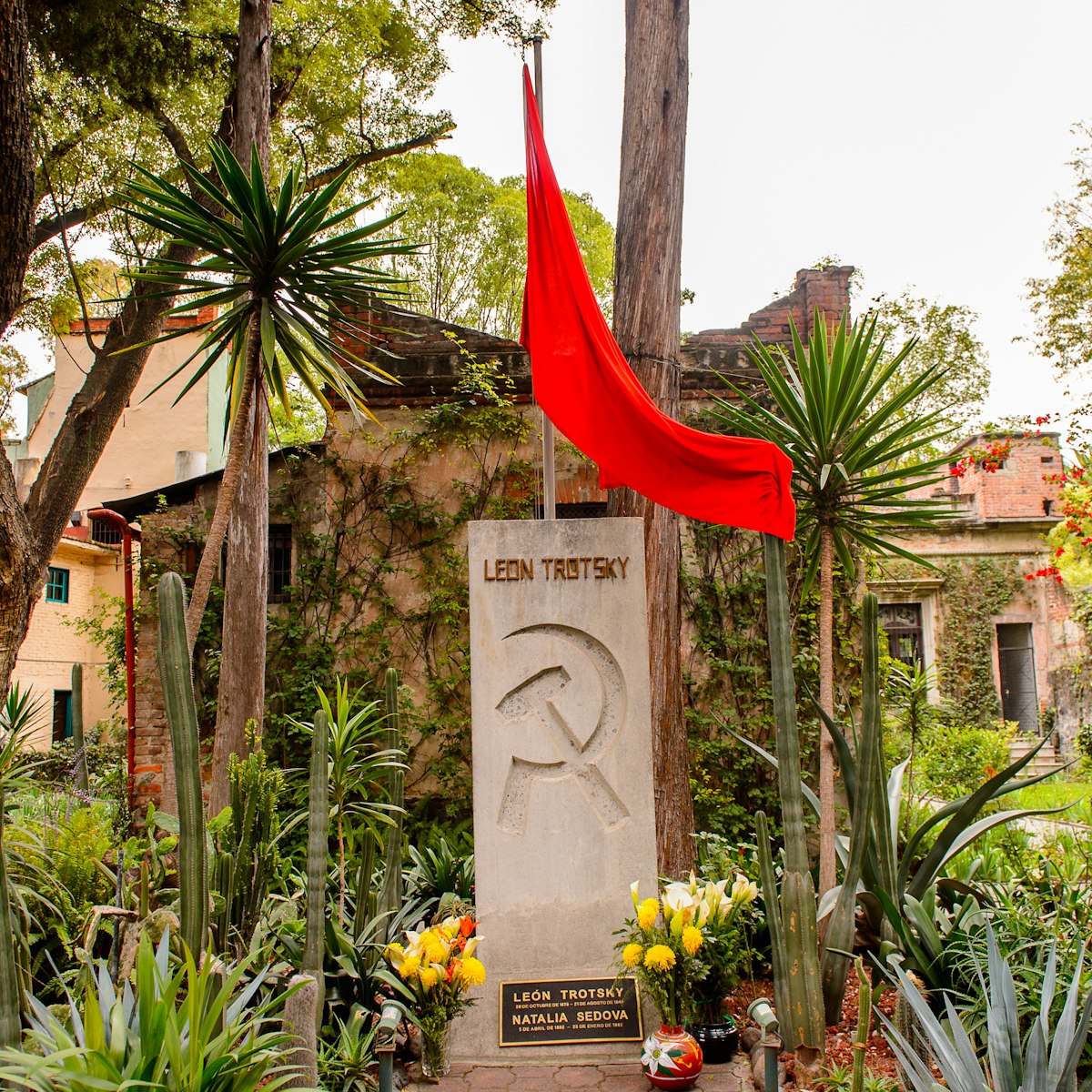
Museo Casa de León Trotsky
The Trotsky home, now a museum, remains much as it was on the day when one of Stalin's agents, a Catalan named Ramón Mercader, caught up with the…
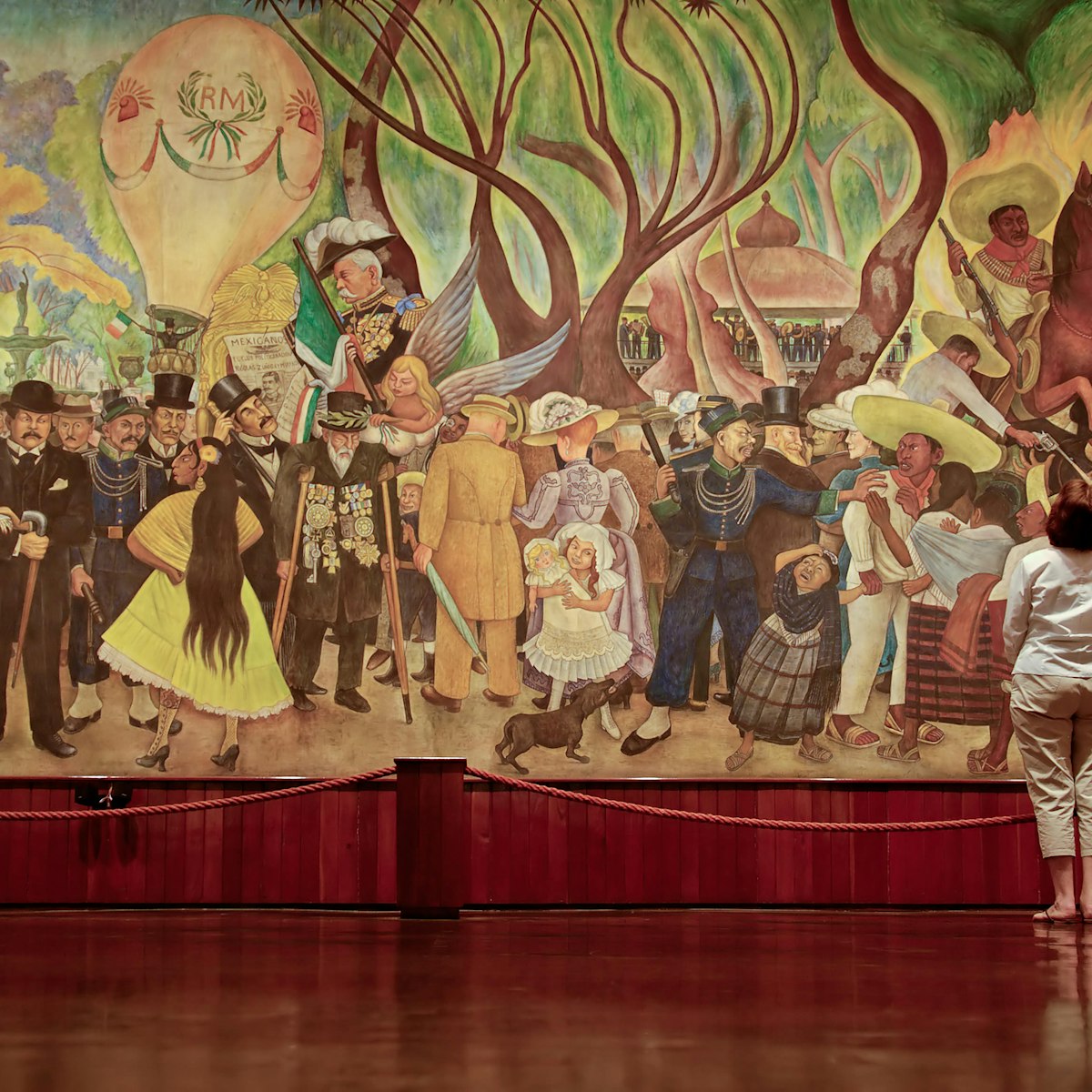
Museo Mural Diego Rivera
This museum is home to one of Diego Rivera’s most famous works, Sueño de una tarde dominical en la Alameda Central (Dream of a Sunday Afternoon in the…
Top picks from our travel experts
10 top things to do in mexico city.
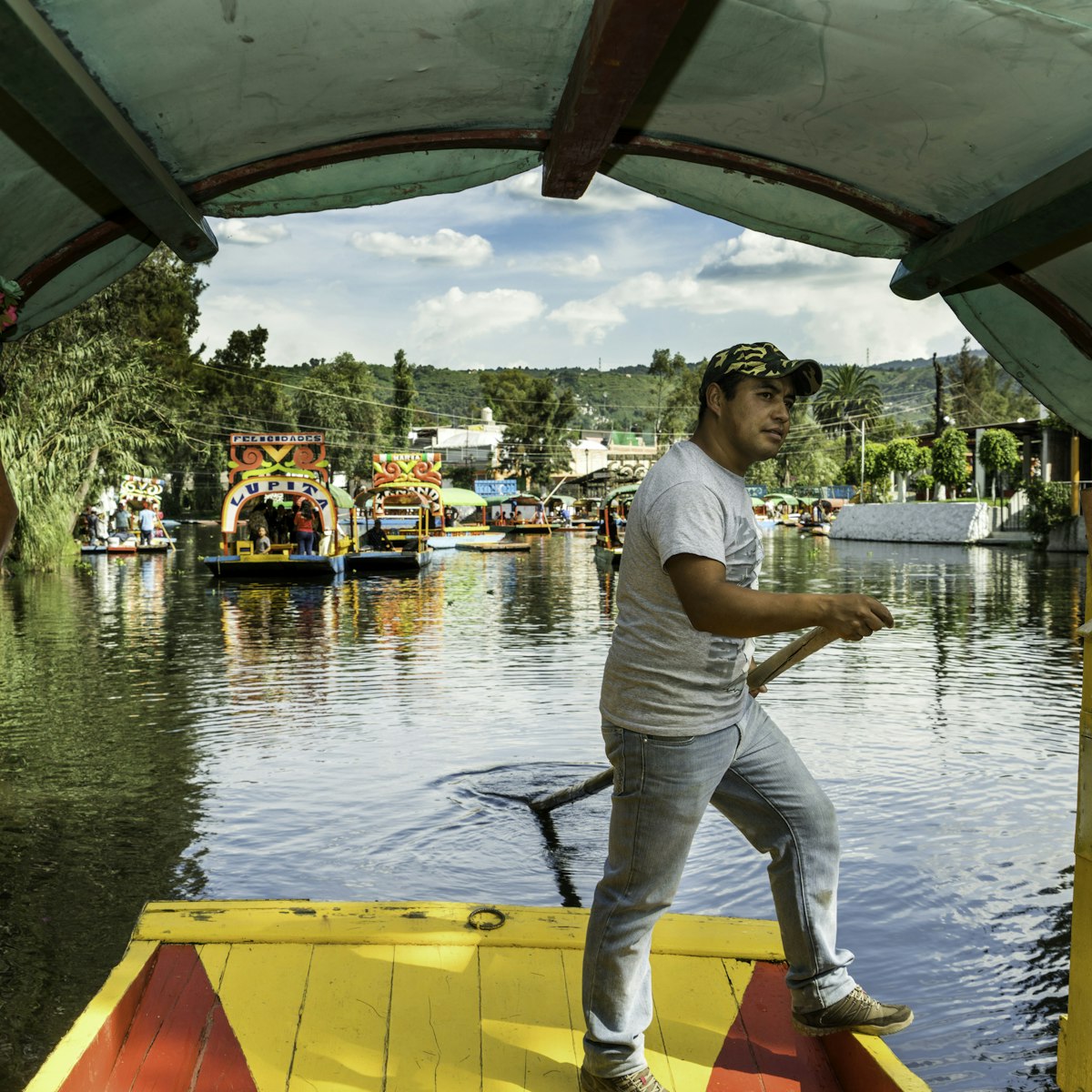
Xochimilco Canals
Hundreds of colorful trajineras (gondolas) await passengers at the village’s 10 embarcaderos to paddle you through the waterways dotted with birdlife and…

Biblioteca de México
Mexico City's mega-library holds over 500,000 volumes and an extensive maps collection. Design and architecture fans should visit just to witness the…
11 of the best free things to do in Mexico City

Museo Soumaya
Polanco & Bosque de Chapultepec
Someone ought to tell Mexican billionaire Carlos Slim that bigger isn't always better. Named after his late wife, this six-story behemoth (plated with 16…

Museo Nacional de las Culturas del Mundo
Constructed in 1567 as the colonial mint, this renovated museum exhibits the art, dress and handicrafts of Mexico's and the world’s cultures. Mixed in for…

Palacio Postal
More than just Mexico City’s central post office, this golden palace built in 1907 is an Italianate confection designed by the Palacio de Bellas Artes’…

Ex Teresa Arte Actual
Mexico City was built atop a sloshy lake bed and it's sinking fast, as evidenced by this teetering former convent. The 17th-century building now serves as…
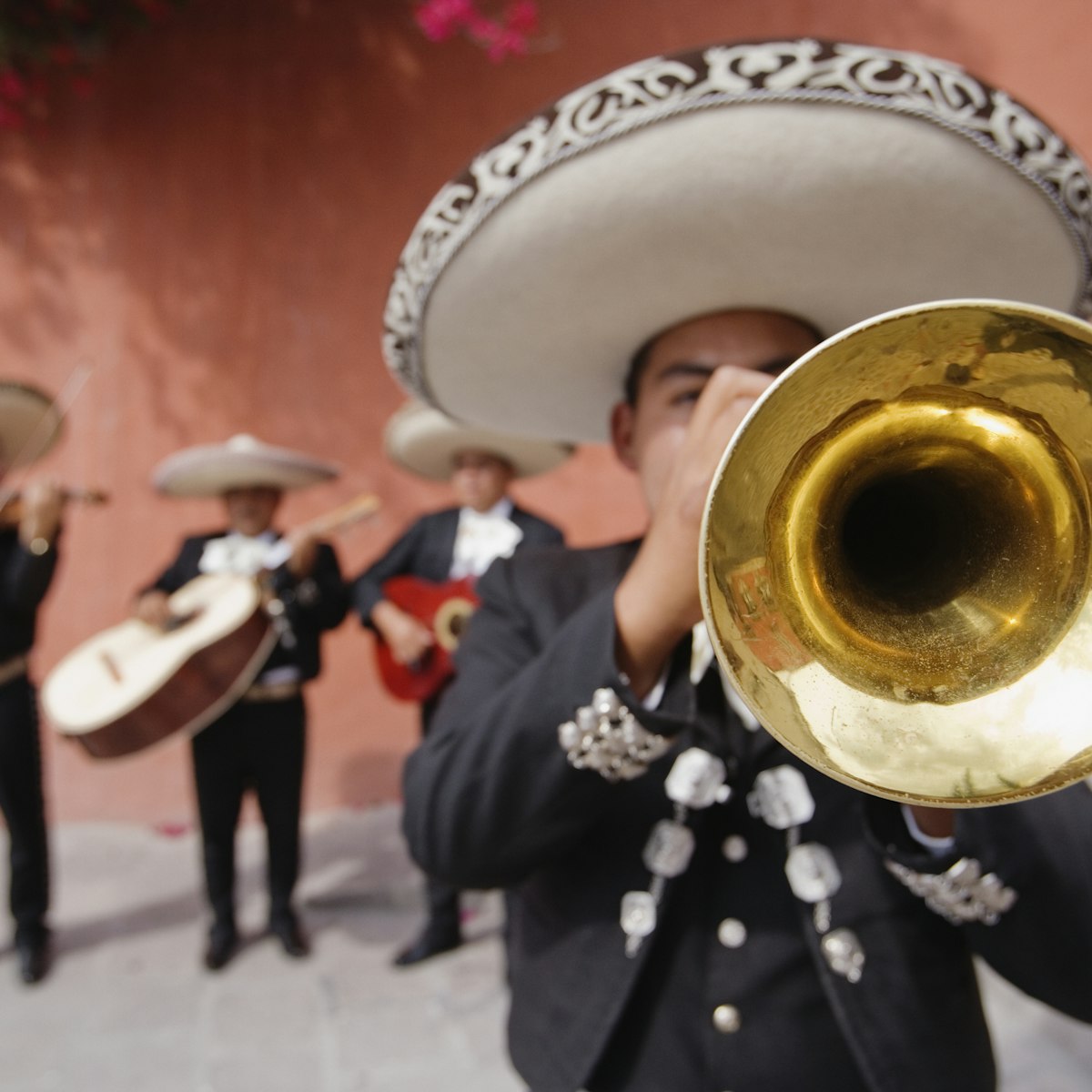
Plaza Garibaldi
Every night the city’s mariachi bands belt out heartfelt ballads in this festive square. Wearing silver-studded outfits, they toot their trumpets and tune…
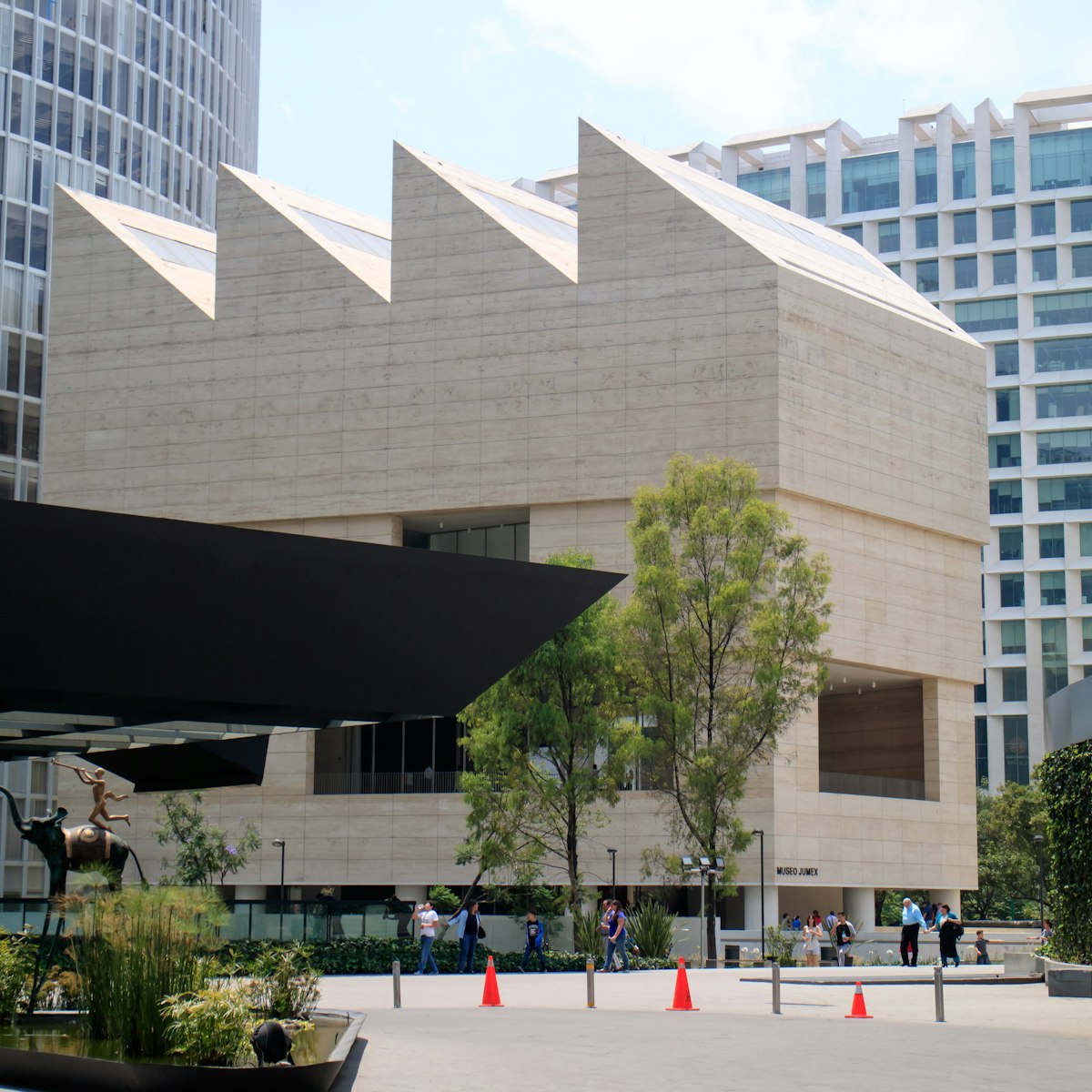
Museo Jumex
Museo Jumex was built to house one of Latin America's leading contemporary art collections. Temporary exhibits draw on a collection of around 2600 pieces…
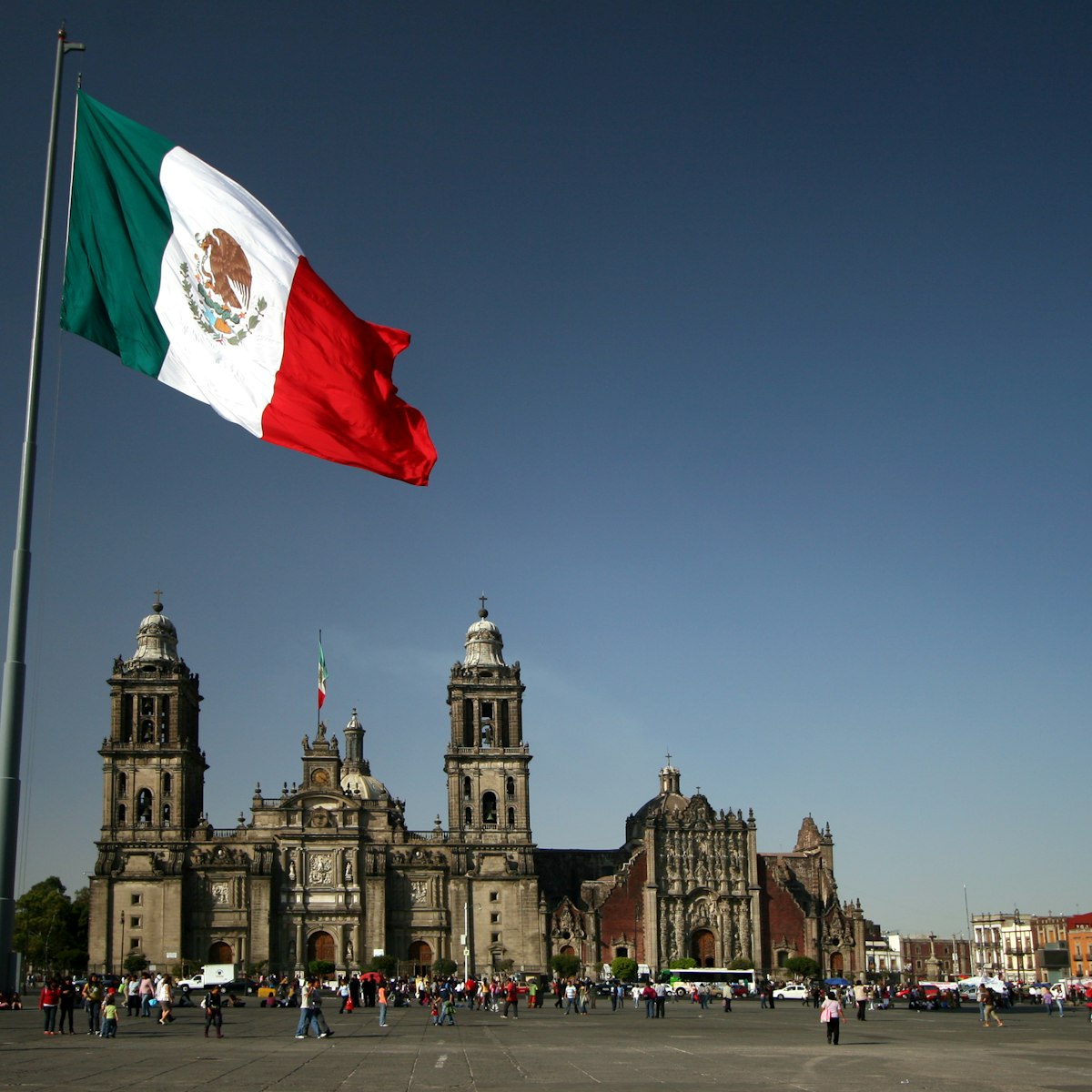
The heart of Mexico City is the Plaza de la Constitución. Residents began calling it the Zócalo, meaning ‘base,’ in the 19th century, when plans for a…

Created in the late 1500s by mandate of then-viceroy Luis de Velasco, the Alameda took its name from the álamos (poplars) planted over its rectangular…

Catedral Metropolitana
One of Mexico City’s most iconic structures, this cathedral is a monumental edifice: 109m long, 59m wide and 65m high. Started in 1573, it remained a work…

Castillo de Chapultepec
A visible reminder of Mexico’s bygone aristocracy, the ‘castle’ that stands atop Chapultepec Hill was begun in 1785 but not completed until after…

Zona Rosa & Reforma
The symbol of Mexico City, known as 'El Ángel' (The Angel), this gilded Winged Victory on a 45m-high pillar was sculpted for the independence centennial…

Tianguis Cultural del Chopo
A gathering place for the city’s various youth subcultures – especially goth, metal, indie and punk – with most of the outdoor vendor stalls selling new…
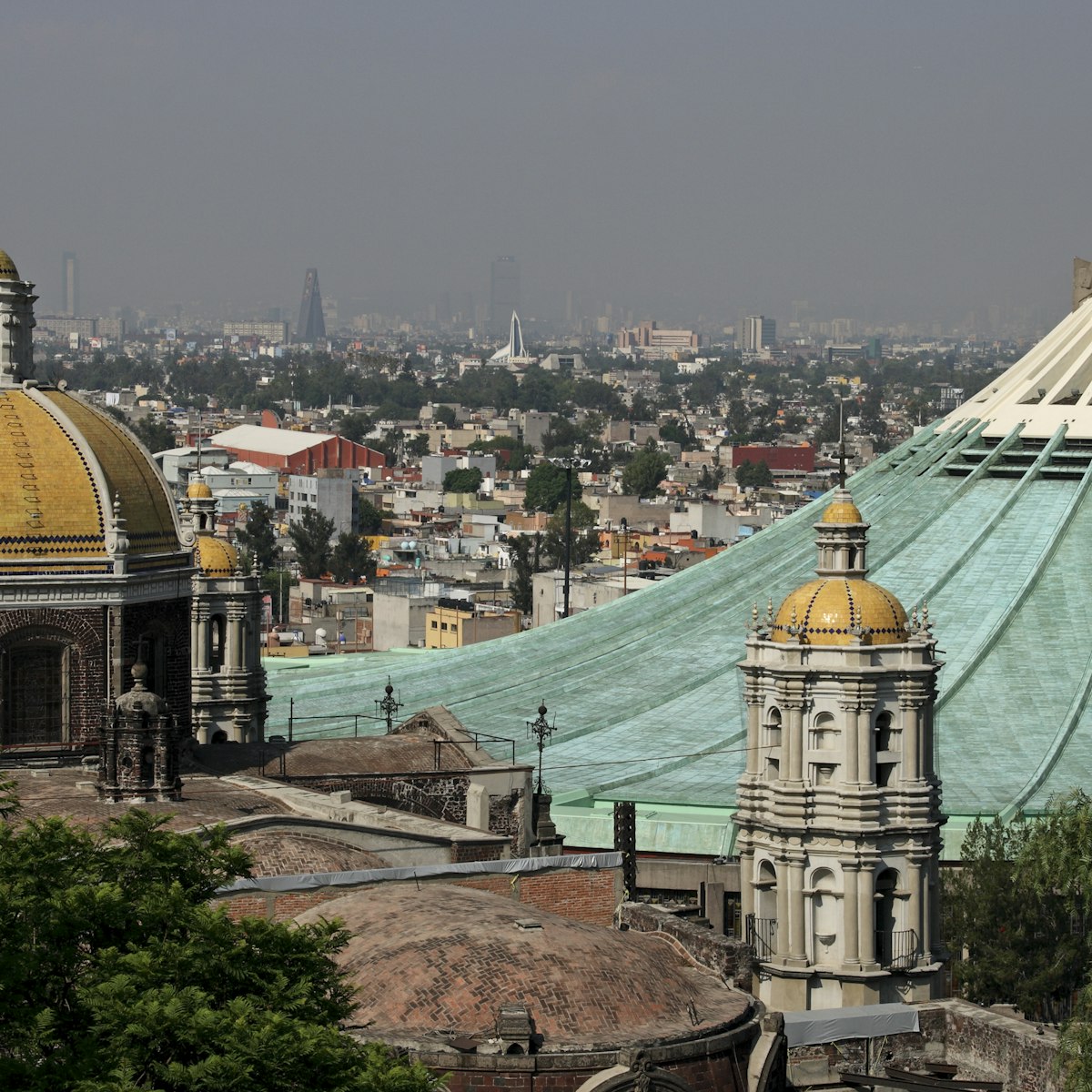
Basílica de Guadalupe
A cult developed around this site after a Christian convert named Juan Diego claimed in December 1531 that the Virgin Mary appeared before him on the…
Planning Tools
Expert guidance to help you plan your trip.
Things to Know
Be a better traveler with this guide to health, safety and etiquette in Mexico City.
Best Neighborhoods
Location is everything in Mexico City, and we've put together a list of the best neighborhoods that are easily walkable and full of charm and character.
While there is plenty to keep you busy in Mexico City, the central region of Mexico is filled with pueblos mágicos that are well worth your time.
Money and Costs
If you want to visit Mexico City but have a tight budget, these practical travel, accommodation, and going-out tips have got you covered.
Transportation
Whether it's cycling, tackling the sprawling subway, or crossing the city by cable car, here is how to navigate Mexico's mighty capital.
Free Things to Do
Stretch your pesos even further with our round up of the best free things to do in Mexico City.
Traveling with Kids
Heading to Mexico City with your kids? Check out these top family-friendly activities and tips for planning your trip.
Spending Diaries
A detailed diary of how to book accommodation, take in superb museums and eat very well in the Mexican capital for under $500.
Plan with a local
Experience the real Mexico
Let a local expert craft your dream trip.
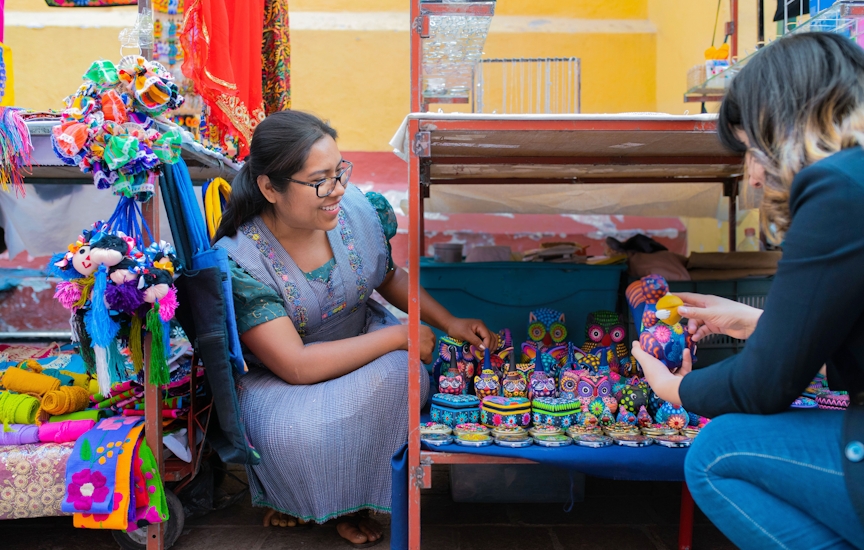
Latest stories from Mexico City
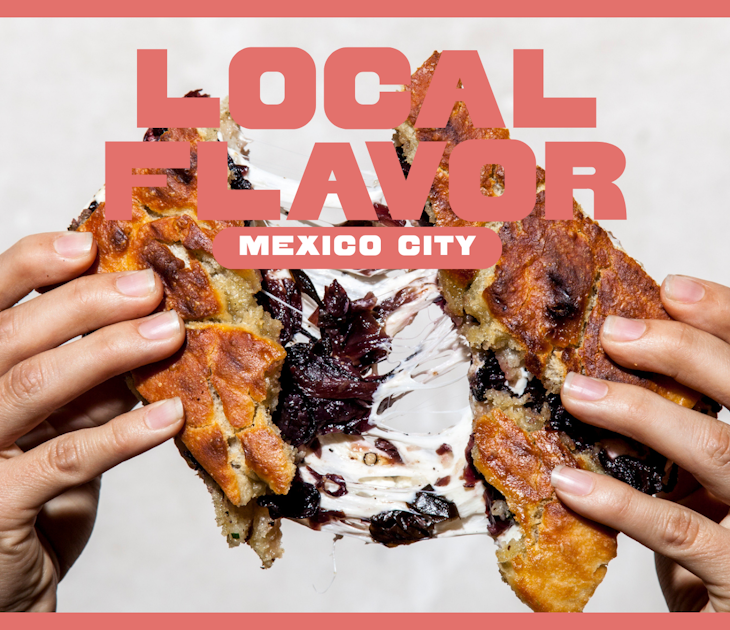
Food and Drink
Mar 21, 2024 • 6 min read
The best bites that locals love in Mexico City.
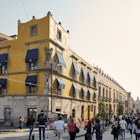
Mar 16, 2024 • 5 min read
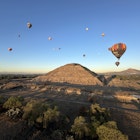
Feb 2, 2024 • 10 min read
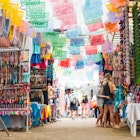
Nov 4, 2023 • 5 min read
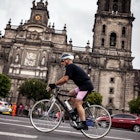
Nov 2, 2023 • 6 min read
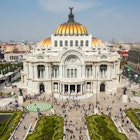
Oct 21, 2023 • 7 min read

Oct 20, 2023 • 8 min read

Oct 8, 2023 • 7 min read

Oct 1, 2023 • 8 min read

Sep 23, 2023 • 5 min read
in partnership with getyourguide
Book popular activities in Mexico City
Mexico city and beyond.

Advertisement
Supported by
What to Know About Claudia Sheinbaum, Mexico’s Newly Elected President
Here are five key insights into Mexico’s new president as people wonder whether she will diverge from Andrés Manuel López Obrador’s policies or focus on cementing his legacy.
- Share full article

By Natalie Kitroeff
Reporting from Mexico City
Claudia Sheinbaum’s list of accolades is long: She has a Ph.D in energy engineering, participated in a United Nations panel of climate scientists awarded a Nobel Peace Prize and governed the capital, one of the largest cities in the hemisphere.
On Sunday, she added another achievement to her résumé: becoming the first woman elected president of Mexico.
Ms. Sheinbaum, 61, captured at least 58 percent of the vote in a landmark election on Sunday that featured two women competing for the nation’s highest office — a groundbreaking contest in a country long known for a culture of machismo and rampant violence against women.

Mexico Election Results: Sheinbaum Wins
See results and maps for Mexico’s 2024 presidential election.
“For the first time in 200 years of the republic, I will become the first female president of Mexico,” she said. “And as I have said on other occasions, I do not arrive alone. We all arrived, with our heroines who gave us our homeland, with our ancestors, our mothers, our daughters and our granddaughters.”
Now that she has clinched the presidency, Ms. Sheinbaum’s next hurdle will be stepping out of the shadow of her predecessor and longtime mentor, Andrés Manuel López Obrador, the outgoing president.
She and Mr. López Obrador are “different people,” she said in an interview. He’s an oilman who invested in environmentally questionable projects; she’s a climate scientist. Yet Ms. Sheinbaum has appealed to voters mainly by promising to cement his legacy, backing moves like his big bet on the national oil company and proposed constitutional changes that critics call antidemocratic.
Their alliance has also left many Mexicans asking: Can Ms. Sheinbaum be her own leader? Or will she just be his pawn?
“There’s this idea, because a lot of columnists say it, that I don’t have a personality,” Ms. Sheinbaum complained to reporters earlier this year. “That President Andrés Manuel López Obrador tells me what to do.”
She insists she will govern independently from Mr. López Obrador and has some different priorities. But veering too far from his agenda could be very risky.
Here are five things to know about the newly elected president of Mexico that help inform whether she will stray from Mr. López Obrador’s policies or dedicate herself to cementing his legacy.
1. Sheinbaum will inherit a host of challenges.
A former ballet dancer, Ms. Sheinbaum calls herself “obsessive” and “disciplined.” But discipline may not be enough, analysts say.
As president, she already stands to inherit a long list of troubles. The state-owned oil company is buckling under debt, migration through the country has reached historical highs and cartel violence continues to torment the country.
She has said she would continue Mr. López Obrador’s policy of addressing the drivers of violence instead of waging war on the criminal groups, but will also work to lower rates of impunity and build up the national guard.
With a U.S. presidential election just months away, she told The New York Times that she was prepared to work with whichever candidate wins. Publicly, she has echoed Mr. López Obrador’s emphasis on tackling migration by addressing its root causes.
In a hint of potential change, she said in a recent debate that she would seek to reform the c ountry’s migration authority , an agency often accused of corruption.
2. She’s seen as reserved, even aloof.
The Times spoke with two dozen people who have worked with or know Ms. Sheinbaum and also visited campaign events, reviewed her writings and her media appearances and interviewed her, once in 2020 and again this year.
What became clear is that Ms. Sheinbaum, (pronounced SHANE-balm), has long seemed more comfortable quietly getting things done than selling herself or her achievements.
The granddaughter of Jewish immigrants who fled Europe, she rarely discusses being Jewish or almost anything about her personal life, colleagues say. When interviewers ask her about the Nobel Prize she shared with a panel of climate researchers, she notes how many others were involved in the work.
She is known as a tough boss with a quick temper who can inspire in her staff fear and adoration at the same time. Publicly, though, her affect is so controlled it verges on aloof.
Some say her professorial demeanor could pose a challenge in a political landscape defined by Mr. López Obrador, who built his party into a juggernaut by relying on the force of his personality.
“She needs him,” said Carlos Heredia, a Mexican political analyst. “She doesn’t have the charisma, she doesn’t have the popularity, she doesn’t have the political stamina of her own, so she needs to borrow that from López Obrador.”
For some Mexicans, however, a thrills-free woman may be an ideal antidote to an entertaining man who plunged the country into partisan turmoil.
3. She’s long sought to keep Mr. López Obrador happy.
The candidate’s political career began when Mr. López Obrador was elected mayor of Mexico City in 2000 and invited her to a meeting at a diner. “What I want is to reduce pollution,” she recalled Mr. López Obrador telling her. “Do you know how to do that?”
Ms. Sheinbaum, who by then had written more than a dozen reports on energy use and carbon emissions, said yes. She became his environment minister. In meetings, she seemed willing to do almost anything to make her boss happy, according to several people who worked with her.
“The phrase she used over and over again was ‘The mayor said to,’” said Mr. Heredia, who worked with her in city government under Mr. López Obrador. What that meant, according to Mr. Heredia: “We are not a cabinet for giving ideas,” he said. “We are a group of people here to execute what he decides.”
In the years that followed, Ms. Sheinbaum straddled academia and politics, but she always stayed close to Mr. López Obrador. When he founded his Morena party in 2014, he asked her to run on the party’s ticket to become mayor of Tlalpan, a borough of Mexico City. With his backing, she won.
4. She is known for being a demanding boss.
In 2018, Mr. López Obrador was swept into the presidency in a landslide and Ms. Sheinbaum became Mexico City’s mayor. She quickly gained a reputation as an exacting boss.
“One doesn’t go to her meetings to tell her, ‘I’m working on it,’” said Soledad Aragón, a former member of Ms. Sheinbaum’s cabinet. When she walked into a room, Ms. Aragón said, everyone sat up straight.
As mayor, she could remember specific numbers mentioned in a meeting weeks after it occurred, Ms. Aragón said, calling her “brilliant” and “demanding,” especially of herself, adding: “It has gotten results.”
Five officials who have worked with Ms. Sheinbaum, who were not authorized to speak publicly, said that she was quick to anger at times and would yell at her subordinates in front of large groups. Through a spokesman, Ms. Sheinbaum declined to comment on the accusation.
Her defenders say some people merely reacted badly to a woman in charge.
“I know that in her government, sometimes people got offended or felt bad because she yelled at them,” said Marta Lamas, a longtime feminist activist who has been close to Ms. Sheinbaum and her team. “But if a man yells, it wouldn’t be an issue because culturally, it’s different.”
“People say it in a critical way: ‘She’s tough,’” Ms. Aragón said. “What do you want, someone soft in charge of the city?”
5. She is a true believer in Mr. López Obrador’s vision.
For years, Ms. Sheinbaum has tried to explain how she can be so in step with Mr. López Obrador while also being herself. The answer, she says, is simple: She genuinely believes in him.
In 2022, a radio host asked her a pointed question from a female listener: “Why don’t you choose to be a woman who governs with her own ideas? Why don’t you get out of AMLO’s circus?” she asked, using Mr. López Obrador’s nickname. “Why have the same rhetoric with the same words?”
Ms. Sheinbaum didn’t hesitate.
“If you think the same as another person, it’s not that you’re copying them; you just agree with the ideas,” she said. “You can’t deny what you believe.”
Emiliano Rodríguez Mega contributed reporting.
Natalie Kitroeff is the Mexico City bureau chief for The Times, leading coverage of Mexico, Central America and the Caribbean. More about Natalie Kitroeff
- Election 2024
- Entertainment
- Newsletters
- Photography
- Personal Finance
- AP Investigations
- AP Buyline Personal Finance
- AP Buyline Shopping
- Press Releases
- Israel-Hamas War
- Russia-Ukraine War
- Global elections
- Asia Pacific
- Latin America
- Middle East
- Election Results
- Delegate Tracker
- AP & Elections
- Auto Racing
- 2024 Paris Olympic Games
- Movie reviews
- Book reviews
- Personal finance
- Financial Markets
- Business Highlights
- Financial wellness
- Artificial Intelligence
- Social Media
Mexico election 2024 highlights: Claudia Sheinbaum set to become president
Watch live from Mexico City as climate scientist Claudia Sheinbaum held an irreversible lead in the race that would make her Mexico’s first woman president, according to an official quick count.
- Copy Link copied
Today’s live coverage has ended, but there’s still plenty to catch up on. Read what you missed below and find more coverage at apnews.com .
Former Mexico City Mayor Claudia Sheinbaum holds an irreversible lead in the 2024 Mexico election that would make her the country’s first female president, according to an official quick count.
▶ Lea lo último en español aquí.
Here’s what to know:
- Results: The National Electoral Institute’s president said Sheinbaum had between 58.3% and 60.7% of the vote, according to a statistical sample. Opposition candidate Xóchitl Gálvez had between 26.6% and 28.6% of the vote.
- Who is Claudia Sheinbaum?: The projected winner is the chosen candidate for Morena, the party created by outgoing President Andrés Manuel López Obrador.
- Violence on voting day: A town council candidate was shot to death by two hitmen aboard a motorcycle just hours before the election. In another town, armed men kidnapped one man who was voting in a polling station. Persistent cartel violence is among the top issues for voters.
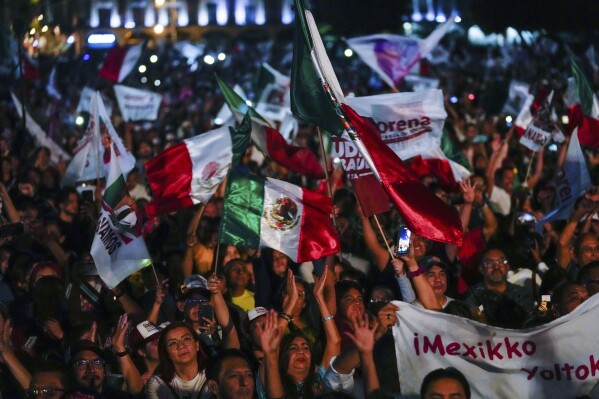
Supporters of ruling party presidential candidate Claudia Sheinbaum celebrate at the Zocalo, Mexico City’s main square, after the National Electoral Institute announced she held an irreversible lead in the election, early Monday, June 3, 2024. (AP Photo/Matias Delacroix)
A supporter of ruling party presidential candidate Claudia Sheinbaum awaits her arrival at the Zocalo, Mexico City’s main square, after the National Electoral Institute announced Sheinbaum held an irreversible lead in the election, early Monday, June 3, 2024. (AP Photo/Matias Delacroix)
Mexico City’s central plaza, the Zocalo, erupted in applause and cheers early Monday morning as Mexico’s projected first woman President Claudia Sheinbaum spoke and pumped her fist before the crowd.
“We women have landed in the presidency,” she said amid a roar from supporters. “We are going to govern for everyone.”
Chants broke out when she referred to her political mentor Mexican President Andrés Manuel López Obrador. She promised to “preserve his legacy” and continue many of his popular policies, including payments to elderly Mexicans and students.
However, instead of the packed plaza that greeted the current president six years ago, early Monday morning there were only a few thousand supporters – a sign that she still lacked the massive support her mentor enjoys.
Sara Ríos, 76, a retired literature professor at Mexico’s most esteemed university, celebrated the victory among throngs of other supporters, but said Sheinbaum has a long road ahead with many challenges, especially with the country’s ongoing cartel violence.
“She will make an effort to pacify the country and will make progress, but it is a slow process,” she said. “The only way for all of us to progress is by working together.”

Ruling party presidential candidate Claudia Sheinbaum addresses supporters after the National Electoral Institute announced she held an irreversible lead in the election in Mexico City, early Monday, June 3, 2024. (AP Photo/Fernando Llano)
With both of her competitors conceding, Claudia Sheinbaum’s name is likely to go down in history as the first woman president of Mexico. The one who broke through 200 years of male governments.
Mexico now joins a list of 11 Latin American nations that are or have been governed by women: Argentina, Bolivia, Brazil, Chile, Costa Rica, Ecuador, El Salvador, Haiti, Honduras, Nicaragua and Panama.
The country, with 129.5 million inhabitants and the second largest economy in Latin America, is known for its “machismo” and violence against women. But Sunday Sheinbaum broke through that longstanding ceiling in an election where the ruling party won by a wide margin.
The projected winner, of the Morena party, will now have to govern a country where disappearances and murders of women are so high, they’re counted with numbers and no longer with names.
Gender equality in the workforce is often divided by class, with women like domestic workers facing harsh conditions. Despite opening access to abortion expanding significantly in recent years, feminist groups in Mexican states are still fighting for better access to sexual and reproductive rights.
Opposition presidential candidate Xóchitl Gálvez shows her ballot during general elections in Mexico City, Sunday, June 2, 2024. (AP Photo/Fernando Llano)
In a speech Monday morning opposition candidate Xóchitl Gálvez recognized defeat in her campaign for Mexico’s presidency.
She said the results “aren’t in my favor” and said she called the race’s projected winner Claudia Sheinbaum to concede.
Gálvez, highly critical of Sheinbaum and her political mentor Andrés Manuel López Obrador, said she would continue to “defend democracy” which she said the populist has put at asked.
Gálvez said she told Sheinbaum: “I see Mexico with a lot of pain and violence.”
- ONGOING VIOLENCE: López Obrador claims to have reduced historically high homicide levels by 20% since he took office in December 2018. But that’s largely a claim based on a questionable reading of statistics. The real homicide rate appears to have declined by only about 4 or 5% in six years by some measures.
- MORE COMPLEX CONFLICT: Under López Obrador cartels have expanded control in much of the country and raked in money — not just from drugs but from extorting legal industries and migrant smuggling. They’ve also fought with more sophisticated tools like bomb-dropping drones and improvised explosive devices.
- “AMLO’S” SHADOW: While Mexico’s next president will likely make history as being the country’s first woman leader, they will likely struggle to step out of the shadow of López Obrador’s larger-than-life image.
- THE ECONOMY: López Obrador brags about Mexico’s strong exchange rate against the U.S. dollar; but the strong peso hurts Mexican exporters, and high domestic interest rates – whcih underpin the currency – tend to choke off economic growth.
- PEMEX: Mexico’s state-owned oil company continues to totter under a mountain of debt, while López Obrador’s pet project _ a new oil refinery – has yet to function, and many of his other infrastructure projects are unfinished, over budget and unlikely to ever turn a profit.
- DEBT: López Obrador also leaves his successor with a staggering budget deficit equivalent to 5.9% of GDP, as well as ongoing costs to fund his building and benefit programs, which will limit their room for manuever.
- WATER AND ENERGY SHORTAGE: López Obrador’s favorite state-owned company, the Federal Electricity Commission, has proved both highly polluting and unreliable, especially in the face of drought and an extended heatwave. The whole country faces looming water and energy shortages.
- THE ENVIRONMENT: Mexico has suffered from long-running drought, wildfires and soaring temperatures causing monkeys to drop dead from trees . Construction of López Obrador’s Maya Train has also fueled environmental concerns .
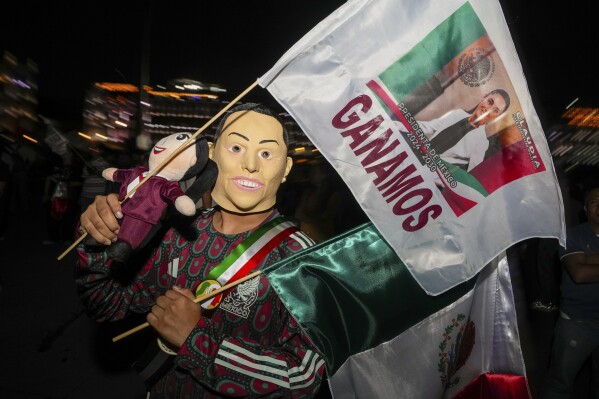
A supporter of ruling party presidential candidate Claudia Sheinbaum holds a flag that reads in Spanish “we won” after general elections at the Zocalo, Mexico City’s main square, Sunday, June 2, 2024. (AP Photo/Matias Delacroix)
A man dressed in traditional clothing sings after the close of polls during general elections at the Zocalo, Mexico City’s main square where supporters of ruling party presidential candidate Claudia Sheinbaum are gathering, Sunday, June 2, 2024. (AP Photo/Matias Delacroix)
A supporter of ruling party presidential candidate Claudia Sheinbaum waves a Mexican flag after the polls closed during general elections at the Zocalo, Mexico City’s main square, Sunday, June 2, 2024. (AP Photo/Marco Ugarte)
Supporters of ruling party presidential candidate Claudia Sheinbaum wait for her arrival at the Zocalo, Mexico City’s main square, after polls closed during general elections on Sunday, June 2, 2024. (AP Photo/Marco Ugarte)
Supporters of ruling party presidential candidate Claudia Sheinbaum embrace after the polls closed during general elections at the Zocalo, Mexico City’s main square, Sunday, June 2, 2024. (AP Photo/Ginnette Riquelme)
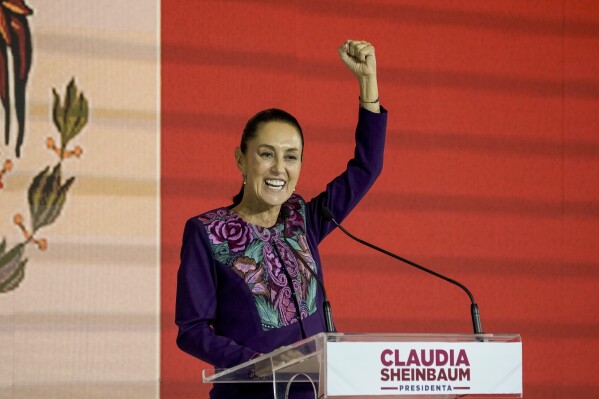
Ruling party presidential candidate Claudia Sheinbaum addresses supporters during general elections in Mexico City, early Monday, June 3, 2024. (AP Photo/Eduardo Verdugo)
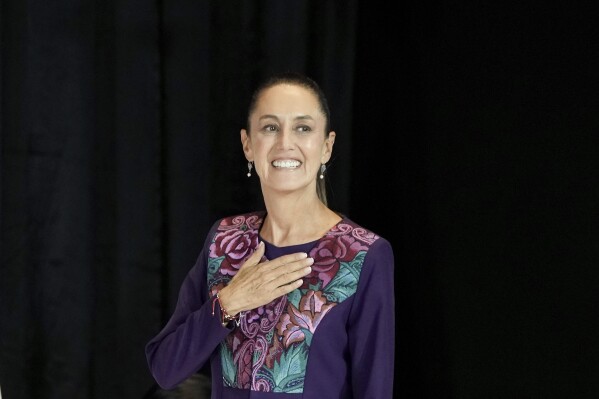
Ruling party presidential candidate Claudia Sheinbaum greets supporters after the polls closed during general elections in Mexico City, early Monday, June 3, 2024. (AP Photo/Eduardo Verdugo)
“I will become the first woman president of Mexico,” Claudia Sheinbaum said in her victory speech.
She smiled, speaking at a downtown hotel shortly after electoral authorities announced a statistical sample showed she held an irreversible lead.
“We have demonstrated that Mexico is a democratic country with peaceful elections,” she said.
Ruling party presidential candidate Claudia Sheinbaum greets supporters after the National Electoral Institute announced she held an irreversible lead in the election in Mexico City, early Monday, June 3, 2024. (AP Photo/Fernando Llano)
Projected winner of Mexico’s presidential elections Claudia Sheinbaum gave a victory speech early Monday morning, saying she received calls from her competitors, who conceded the race.
“I want to thanks millions of Mexican men and women who decided to vote for us in this historic journey,” she said in a speech.
She said she received a call from opposition candidate Xóchitl Gálvez and Jorge Álvarez Máynez congratulating her on the victory.
She said she hopes to work on the “construction of peace” in a violence-torn Mexico and built a “diverse and democratic” Mexico.
FILE - Mexico’s President Andres Manuel Lopez Obrador, right, and then Mayor Claudia Sheinbaum, greet supporters at a rally in Mexico City’s main square, the Zocalo, July 1, 2019. Sheinbaum, Mexico’s ruling party presidential candidate, slipped up during a campaign speech Friday, May 10, 2024, and said López Obrador was motivated by “personal ambition,” but later acknowledged the phrase “could be misinterpreted.” In Mexico it is used to describe a desire for personal economic gain. (AP Photo/Fernando Llano, File)
Mexican President Andrés Manuel López Obrador announced that his political mentee will be Mexico’s first woman president.
“Of course I congratulate Claudia Sheinbaum with all my respect who ended up the winner by a wide margin. She is going to be Mexico’s first (woman) president in 200 years,” López Obrador said.
According to projections by Mexico’s electoral agency President Andrés Manuel López Obrador’s Morena party will hold a congressional majority.
This would allow Claudia Sheinbaum, who the agency has projected will win the race, to push through her agenda with ease.
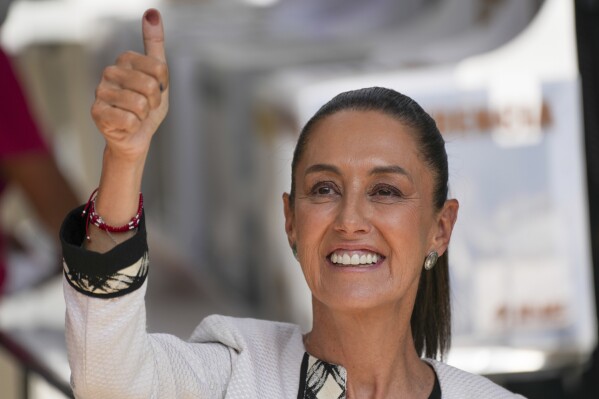
Ruling party presidential candidate Claudia Sheinbaum shows her ink-stained thumb after voting during general elections in Mexico City, Sunday, June 2, 2024. (AP Photo/Marco Ugarte)
Climate scientist Claudia Sheinbaum held an irreversible lead Sunday in the presidential race that would make her Mexico’s first female president, according to an official quick count.
The National Electoral Institute’s president said Sheinbaum had between 58.3% and 60.7% of the vote, according to a statistical sample. Opposition candidate Xóchitl Gálvez had between 26.6% and 28.6% of the vote and Jorge Álvarez Máynez had between 9.9% and 10.8% of the vote.
The governing party candidate campaigned on continuing the political course set over the last six years by her political mentor President Andrés Manuel López Obrador.
His anointed successor, the 61-year-old Sheinbaum led the campaign wire-to-wire despite a spirited challenge from Gálvez. This was the first time in Mexico that the two main opponents were women.
Ruling party presidential candidate Claudia Sheinbaum arrives to vote during general elections in Mexico City, Sunday, June 2, 2024. (AP Photo/Eduardo Verdugo)
Former Mexico City Mayor Claudia Sheinbaum is leading the presidential race with 30% of polling place tallies counted by Mexico’s electoral authority.
Sheinbaum, candidate of President Andrés Manuel López Obrador’s Morena party, leads with more than 57% of the vote.
Lagging behind her is opposition candidate Xóchitl Gálvez with nearly 30% of the vote.
Longshot candidate Jorge Álvarez Máynez trailed with little more than 10% of the vote.
Former Mexico City Mayor Claudia Sheinbaum is leading the presidential race with 20% of polling place tallies counted by Mexico’s electoral authority.
Vote counts have been slow, opening the door for competitor Xóchitl Gálvez to sow doubt in election results.
“The votes are there. Don’t let them hide them,” Gálvez wrote on the social platform X shortly before the electoral authorities’ announcement.
Mexico’s electoral agency, the National Electoral Institute, announced that it will give an update on the vote count shortly.
Ruling party presidential candidate Claudia Sheinbaum casts her ballot for president during general elections in Mexico City, Sunday, June 2, 2024. (AP Photo/Marco Ugarte)
Former Mexico City Mayor Claudia Sheinbaum is leading the presidential race with 10% of polling place tallies counted by Mexico’s electoral authority. Vote counts have been slow.
The head of Mexico’s electoral agency called on political parties, candidates and the media “to act with restraint, prudence and responsibility” in announcing results after a number of candidates and news organizations called the presidential race based on private exit polls with little official results available.
“Our electoral system is designed to ensure that every vote counts and that every result is verified in a fair and transparent manner,” wrote Guadalupe Taddei Zavala, the president of the electoral institute in a statement.
Vote counts continue to lag in Mexico’s historic election. Despite private exit polls favoring frontrunner Claudia Sheinbaum, The Associated Press bases its report on official results and will continue to update coverage as votes roll in.
As night fell, crowds in Mexico City’s main plaza, the Zocalo, still hadn’t formed.
The plaza where frontrunner Claudia Sheinbaum plans to celebrate her victory resonated with music piped through speakers rather than the buzz of yet-to-arrive crowds. It was a stark contrast from just six years before when Mexicans flooded into the plaza in the early hours of the night to celebrate the eventual victory of her political mentor, President Andrés Manuel López Obrador.
Throughout the campaign, Sheinbaum failed to generate the same enthusiasm that López Obrador , better known as by his nickname “AMLO,” has long enjoyed.
After polls closed, supporters of Sheinbaum and López Obrador’s party began to arrive in Mexico City’s Zocalo. Some street vendors were promoting Sheinbaum dolls – though those of the populist president appeared to be selling faster.
Fernando Fernández, a 28-year-old chef, and Itxel Robledo, 28, an administrator, opted to buy two pairs of socks with the image of López Obrador while they waited for the results.
“You vote for Claudia out of conviction, for AMLO,” Fernández said. But his highest hope is that Sheinbaum can “improve what AMLO couldn’t do, the price of gasoline, crime and drug trafficking, which he didn’t combat even though he had the power.”
Robledo said that the best of López Obrador was the fight against corruption. “Yes, he achieved it although there is still more to be done and he helped a lot of poor people with his programs in Mexico,” he added.
Robledo, 28, said she supports López Obrador railing against corruption, but hopes that Sheinbaum will put more professionals in her government.
She hopes if Sheinbaum wins, she’ll be able to govern “without the shadow of López Obrador.”
PHOTOS: Voting results are beginning to publish in Mexico’s historic elections
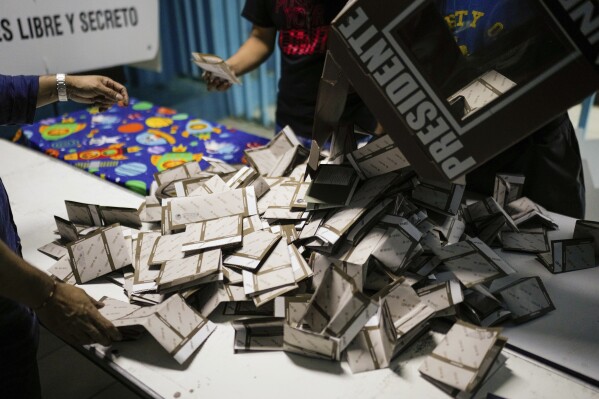
Electoral officials count votes after polls closed during general elections in Mexico City, Sunday, June 2, 2024. (AP Photo/Matias Delacroix)
A voter casts her ballot during general elections in Mexico City, Sunday, June 2, 2024. (AP Photo/Matias Delacroix)
Presidential ballots fill a ballot box, during general elections in Mexico City, Sunday, June 2, 2024. (AP Photo/Ginnette Riquelme)
Electoral officials and poll watchers count votes after polls closed during general elections in Mexico City, Sunday, June 2, 2024. (AP Photo/Matias Delacroix)
Voters cast their ballots during general elections in Mexico City, Sunday, June 2, 2024. (AP Photo/Matias Delacroix)
Mario Delgado, president of the Morena party, speaks after polls closed in Mexico’s eastern time zone during general elections in Mexico City, Sunday, June 2, 2024. (AP Photo/Fernando Llano)
Opposition presidential candidate Xochitl Galvez waves after polls closed during general elections in Mexico City, Sunday, June 2, 2024. (AP Photo/Marco Ugarte)
Mexico’s electoral agency is beginning to publish results of the country’s historic elections, in which a woman is likely to be elected as president for the first time.
Mexico City is one of the nine states choosing its governor on Sunday.
The capital has been ruled by leftist governments since 1997, but in 2021 mid-term elections, the president’s party had a setback because important sectors of the capital’s progressive middle class did not agree with López Obrador. He had intensified his criticism of environmentalists, academics, human rights defenders and lashed out against independent institutions that serve as a check on his power.
Yoselin Ramírez, a 29-year-old who voted in a middle class borough, said she split her vote because she didn’t want anyone holding a strong majority. She chose Sheinbaum for president because she thought she was the most qualified.
“I don’t want everything to be occupied with the same party so that there is a little more equality,” she said without elaborating.
López Obrador’s Morena party is also hoping to pick up governorships in opposition strongholds of Guanajuato, Jalisco and Yucatan. Heading into the elections, Morena controlled the governorships in 23 of Mexico’s 32 states.
Engineer Guillermo D. Christy photographs a steel pillar filled with concrete that was installed inside the Aktun Tuyul cave system to support the Maya Train track on the outskirts of Playa del Carmen, Mexico, Sunday, March 3, 2024. Construction of the Maya Train is rapidly destroying part of the hidden underground world of caverns and sinkhole lakes, known as cenotes, already under threat by development and mass tourism. (AP Photo/Rodrigo Abd)
As votes are tallied in Mexico’s history elections, catch up on Associated Press coverage in the lead-up to the election:
- In Mexico, a hidden underground world under threat by the Maya Train
- Mexico’s drug cartels and gangs appear to be playing a wider role in Sunday’s elections than before
- Mexico’s poorest receiving less government funds under president who brought poor to the fore
- A woman will likely be Mexico’s next president. But in some Indigenous villages, men hold the power
- A woman could be Mexico’s next leader. Millions of others continue in shadows as domestic workers
- As election nears, violence is key issue for Mexicans, including Catholics jolted by priest killings
Maria del Carmen Ayala Vargas, who said her son Ivan Pasrtana Ayala disappeared in 2021, attends the annual National March of Searching Mothers, held every Mother’s Day in Mexico City, Friday, May 10, 2024. Her sign reads in Spanish, “I’m not looking for those to blame, but for my son.” (AP Photo/Marco Ugarte)
In some parts of Mexico, voters chose to nullify their votes by writing in the names of some of Mexico’s more than 110,000 missing people as president.
The act was a clear sign of protest by those who were fed up by failures by the government to respond to people who have been forcibly disappeared amid cartel violence.
Among them was Victoria Delgadillo, in Xalapa in the eastern Mexican state of Veracruz. She founded the “Xalapa Connections” collective and is looking for her daughter, Yureny Citlali Hernández, who disappeared in 2011 at the age of 26, and 12 other young women. Disappearances often haunt families.
“I voted for Yureny, for Pilar, for Carmen and all those many who have been disappeared,” Delgadillo said.
The “Vote for the Disappeared” campaign, launched nationwide by relatives of those who have gone missing, was not intended to discourage participation. Rather, it was created to make invalid votes have special meaning by registering the name of a disappeared person on a part of the ballots where the voter can write the name of an unregistered candidate.
Such families have criticized the government of President Andrés Manuel López Obrador, who they say has sought to minimize the problem of people going missing amid ongoing violence in Mexico.
“Vote for whoever you vote for, we mothers of the disappeared have to work with whoever is left,” Delgadillo said.
Fear gripped the small central Mexican town of Cuitzeo Sunday afternoon, where a town council candidate was shot dead just hours before voting began.
Candidate Israel Delgado Vega was chatting with men near his home when two men on a motorcycle shot him dead, according to local prosecutors. Less than a day later, all that remained at the scene of his death were flowers and candles. Few wanted to speak about his death.
Mexican President Andrés Manuel López Obrador promised to reduce violence while in office. He employed a strategy known as “hugs not bullets” focusing on not confronting cartels and instead addressing social ills fueling cartel recruitment, like poverty.
But under the leader, cartels have expanded control in much of the country and raked in money — not just from drugs but from extorting legal industries and migrant smuggling. They’ve also fought with more sophisticated tools like bomb-dropping drones and improvised explosive devices.
Elections have been marked by violence, especially in disputed areas like Guerrero, Chiapas , and Michoacan, where Delgado Vega was slain. It continues to be a top concern by voters.
▶ READ MORE:
- Mexican president claims that criminal groups are ‘respectful’ and ‘respect the citizenry’
- Mexico’s drug war uses drones, human shields, gunships
- Hugs or bullets? Mexico conflicted over how to fight crime
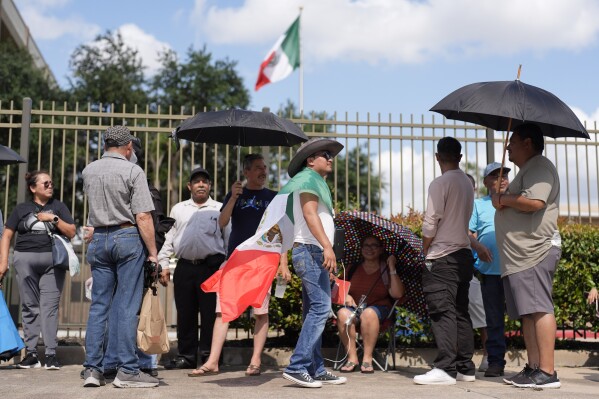
Max Aleman, center, wears a Mexican flag as he waits for hours along with others to vote in the Mexican election at the Mexican Consulate building Sunday, June 2, 2024, in Houston. Houston and Dallas were the only two consulate locations in Texas where Mexican nationals could go to vote. Mexicans went to the polls Sunday to vote for who will likely be the country’s first female president. (AP Photo/David J. Phillip)
Thousands of Mexican voters lined up at their nearest consulate offices. The turnout exceeded Mexico’s expectations in several cities across the United States and other countries.
In Dallas, some voters started waiting in line at 3:30 a.m. local time, according to the Dallas Morning News.
Similar lines could be seen in Houston after hundreds filled sidewalks waiting in the heat with little to no shade for hours.
In Los Angeles, voters draped themselves in Mexican flags and erupted in cheers every time another ballot was cast, the Los Angeles Times reported. Street vendors selling food and snacks also gathered outside the consulate, catering to eager voters.
The Mexican consulates in San Francisco, San Diego and Fresno also saw long lines of hundreds of voters Sunday. California is home to more than three million Mexican immigrants.
“In some cases, such as in Madrid, California, Chicago and Phoenix, the large influx of people wishing to vote at the consular headquarters has exceeded expectations,” Mexico’s National Electoral Institute said in a statement.
Polls have closed in most of Mexico’s 32 states. Voters begin awaiting the results of an election that will chart the way forward in the coming years. Voting will continue for another hour on the Baja California peninsula.
Chinese migrants follow a U.S Border Patrol agent to be processed after crossing the border with Mexico Wednesday, May 8, 2024, near Jacumba Hot Springs, Calif. San Diego became the busiest corridor for illegal crossings in April, according to U.S. figures, the fifth region to hold that title in two years in a sign of how quickly migration routes are changing. (AP Photo/Ryan Sun)
While Mexicans were voting, a group of about 200 migrants crossed the Suchiate river that divides Mexico and Guatemala and walked up a highway outside Tapachula.
Venezuelan Eliezer Ávila crossed the Suchiate and quickly joined up with a group of other migrants moving north.
Ávila, a security guard back in Venezuela, said that along the banks of the Suchiate there were hundreds of other migrants who had been waiting for weeks to be attended to by immigration authorities. He said he couldn’t afford to wait around so he set out walking.
We ask “that (authorities) at least set up a humanitarian corridor to a city where we can wait or let us make it to our destination (the United States), he said.
More than 500,000 migrants crossed the Darien Gap dividing Colombia and Panama last year , the majority Venezuelans.
The number of migrants reaching the U.S. border has fallen significantly since January and U.S. officials credit efforts by Mexico. The Biden administration is finalizing plans to clamp down on illegal crossings before the U.S. election.
Mexico has been moving migrants from the north back to the south away from the border. Migrants complain they are constantly extorted by authorities as they move through the country.
TAKE A LOOK: AP photographers capture voting in biggest election in Mexico’s history

Indigenous women line up to vote during general elections in Zinacantan, Mexico, Sunday, June 2, 2024. (AP Photo/Luis Etzin)
Voters stand in line as they wait their turn to cast their ballots, during general elections in Mexico City, Sunday, June 2, 2024. (AP Photo/Matias Delacroix)
Cable cars glide over a polling station, right, during general elections in Mexico City, Sunday, June 2, 2024. (AP Photo/Ginnette Riquelme)
A child watches as an electoral official dyes her father’s thumb with election ink during general elections in Mexico City, Sunday, June 2, 2024. (AP Photo/Matias Delacroix)
A voter, reflector in a wall mirror, casts her ballots during general elections in Mexico City, Sunday, June 2, 2024. (AP Photo/Matias Delacroix)
A woman casts her ballot in a box for voters who need special assistance, during general elections in Mexico City, Sunday, June 2, 2024. (AP Photo/Matias Delacroix)
Agitated voters hold out their arms to show where electoral workers marked them with a number outside a polling station, during general elections in Mexico City, Sunday, June 2, 2024. Election workers at this downtown polling station created the number system to determine when they reached 1,000, the number of available ballots at that polling station. (AP Photo/Ginnette Riquelme)
Voters line up around the block as they wait to cast their ballots, during general elections in Mexico City, Sunday, June 2, 2024. (AP Photo/Ginnette Riquelme)
An Indigenous woman votes during general elections in Zinacantan, Mexico, Sunday, June 2, 2024. (AP Photo/Luis Etzin)
Louanne Garcia casts her father’s ballot during general elections in Mexico City, Sunday, June 2, 2024. (AP Photo/Ginnette Riquelme)
Associated Press journalists across the country have been working to cover the country’s biggest election in history , with more than 20,000 local and federal seats up for grabs.
FILE - A person holds a sign with a message that reads in Spanish: “We are all the same Mexico”, at an opposition rally called to encourage voting in the upcoming election, in the Zocalo, Mexico City’s main square, May 19, 2024. (AP Photo/Ginnette Riquelme, File)
- “ AMLO” : The legacy of President Andrés Manuel López Obrador, who many see as a champion of Mexico’s marginalized and others see as a threat to democracy. A major question is:
- Violence: Cartels have expanded in power in much of the country in recent years, raking in money from new industries and using more powerful weapons to fight for territory.
- The Economy: Mexico’s peso is the strongest it’s been in years, but many Mexicans complain about inflation, especially in places like Mexico City.
- Gender: With two women leading the ballot, Mexico is on track to elect its first female leader. Both have promised to address violence against women and gender disparities.
- Democracy: López Obrador’s critics say moves he has made represent a democratic threat, something that has fueled massive protests.
- The Environment: Mexico has suffered from long-running drought, wildfires and soaring temperatures causing monkeys to drop dead from trees . Construction of López Obrador’s Maya Train has also fueled environmental concerns .
- Social Spending: AMLO’s social programs are so popular that even the opposition candidates promise to continue them, but spending on Mexico’s poorest has actually fallen
Armed men kidnapped one man who was voting in a polling station in the town of San Fernando, in the southern Mexican state of Chiapas, according to the Chiapas Prosecutor’s Office.
Two armed men burst into a local market where a voting station was set up and kidnapped the man. The man later appeared beaten up in another place, prosecutors said.
Violence has rapidly escalated in Chiapas in the past year like no other part of Mexico. Cartels and other criminal groups have waged a brutal war for control of the lucrative migrant and drug smuggling routes along the country’s southern border with Guatemala.
- A mayoral candidate and 5 other people killed in gunfire at a campaign rally in southern Mexico
- Mexico’s leading presidential candidate stopped by masked men who ask for help in stemming violence
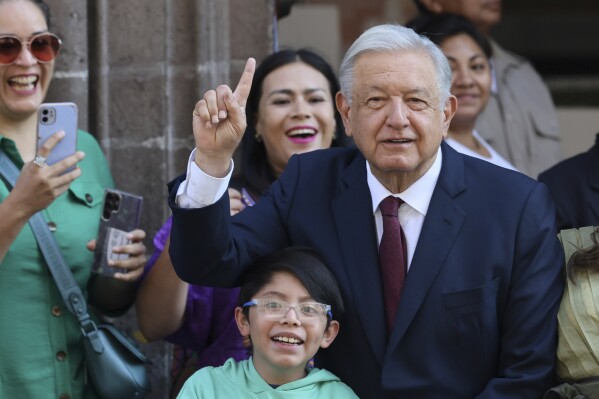
Outgoing President Andrés Manuel López Obrador poses for photos with supporters after voting in the general elections, in Mexico City, Sunday, June 2, 2024. (AP Photo/Ginnette Riquelme)
Mexico’s populist leader López Obrador has long been a larger-than-life political force , and continues to be highly popular in Mexico. He has a strong base of support among poorer and rural Mexicans, who identify with his folksy charisma and have long felt forgotten by the country’s political system.
Because of that, his political ally Sheinbaum has used her connection with the leader in her campaign and promised to continue on many of his policies.
At the same time, his critics say his moves to attack the judiciary , slash funding to Mexico’s electoral agency and expand the military’s responsibilities in civilian life have eroded Mexican democracy. Sheinbaum’s competitor Gálvez has capitalized on criticisms of López Obrador throughout her campaign.
Mexico goes into Sunday’s election deeply divided: friends and relatives no longer talk politics for fear of worsening unbridgeable divides, while drug cartels have split the country into a patchwork quilt of warring fiefdoms. (AP video shot by Fernanda Pesce and Megan Janetsky)
FILE - Relatives and friends carry the coffin that contains the remains of a man slain in a mass shooting, into a church for a funeral service in Huitzilac, Mexico, May 14, 2024. When Mexicans vote June 2, they will do so in an increasingly polarized country that continues to struggle with staggering levels of violence. (AP Photo/Fernando Llano, File)
Many Mexican voters say violence is top among their electoral worries, but it’s also spurred democratic concerns.
Cartels and other criminal groups use elections – particularly local elections – as an opportunity to make power grabs. The National Electoral Institute says it has had to cancel plans for 170 polling places, mostly in Chiapas and Michoacan and mostly because of security problems.
While voting appeared peaceful, if time-consuming, at most of Mexico’s approximately 170,000 polling places, there were isolated incidents of violence Sunday after a bloody campaign process.
In the central state of Puebla, four armed assailants tried to burst in to a school where voting booths were installed to steal ballots. State police said arrests had been made.
And Queretaro’s governor, said that assailants had tried to burn ballots at four polling places. A video posted on social media showed two masked men escaping on a motorcycle after one attack.
Earlier this week, unidentified gunmen opened fire a couple of blocks away from a mayoral candidate’s final campaign rally in western Cotija, Michoacan.
Meanwhile, candidates have been picked off, with at least 28 political contenders slain this year, according to human rights organization Data Civica.
- Mexico’s cartel violence haunts civilians as the June 2 election approaches
- Violence clouds the last day of campaigning for Mexico’s election
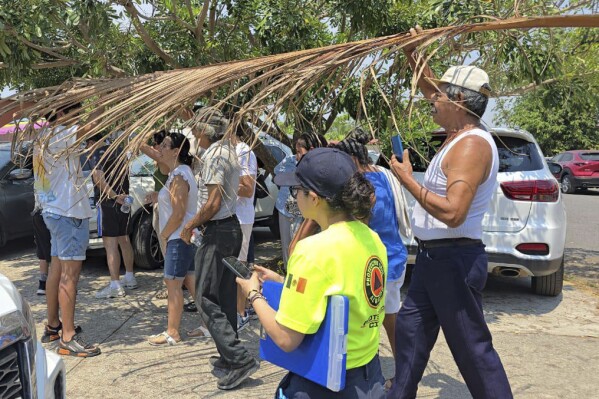
A voter uses a fallen palm leaf to protect himself from the sun while he waits to vote in the general election, in Xalapa, Veracruz, Sunday, June 2, 2024. (AP Photo/Alba Aleman)
The elections in Mexico are heating up – and not just politically.
In the Gulf coast state of Veracruz, temperatures were already at 100 degrees (37 Celsius) before noon and were expected to rise further. Voters were covering their heads with stalks of leaves and palm fronds as they stood in line. So far this year, 14 people have died in the state from heat stroke, and howler monkeys have fallen dead from the trees.
In the Veracruz hamlet of Mandinga, two voters, Antonio Castillo, 43 and Esteban Ramirez, 45, took refuge in the little shade provided by an improvised cover of palm fronds.
Because of poor organization, some voters in Veracruz faced lines up to three hours to vote. Castillo and Ramirez, both taxi drivers, were uncomplaining. “The important thing here is to vote. We found these palm fronds here and they’re helping us,” Castillo said, “though we’d really like to have a real palapa.”
Even in the relatively temperate capital, Mexico City , about 7,350 feet (2,240 meters) above sea level, Hugo Nava, a 71-year-old university professor, said the heat was the worst he remembers in at least 30 years.
“I used to carry a sports coat or sweater around. No more,” says Nava, who showed up in shirt sleeves to wait in line to vote. “It’s bad.”
“ The climate is having a big effect ,” he said. “People are coming out early, because they don’t want to be here at noon.”
Presidential candidate Jorge Álvarez Máynez arrives to vote in the general election in Mexico City, Sunday, June 2, 2024. (AP Photo/Ginnette Riquelme)
Jorge Álvarez Máynez is a longshot candidate in Mexico’s presidential race. He’s offered himself up as an alternative to those not content with the polarized candidates locked in a tug-of-war for Mexico’s top position.
While he’s sought to court the youth vote, he’s also become the subject of many internet memes throughout the race. A former federal lawmaker, he represents the smaller Citizen Movement party.
PHOTOS: AP photograhers capture Mexicans voting in historic elections
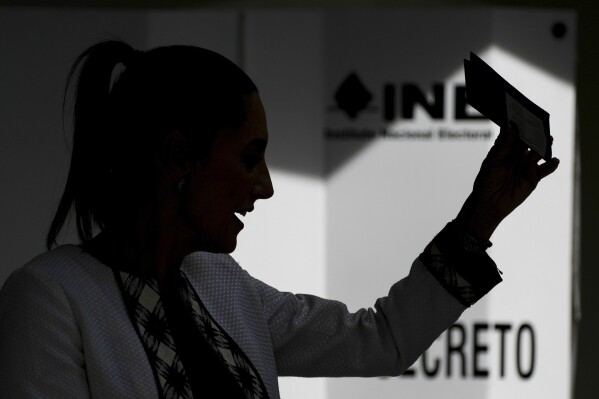
Ruling party presidential candidate Claudia Sheinbaum shows her ballot before voting, during general elections in Mexico City, Sunday, June 2, 2024. (AP Photo/Marco Ugarte)
Ruling party presidential candidate Claudia Sheinbaum leaves the polling station where she voted during general elections in Mexico City, Sunday, June 2, 2024. (AP Photo/Matias Delacroix)
Voters, some holding a sign supporting opposition presidential candidate Xóchitl Gálvez, line up outside a polling station during general elections in Mexico City, Sunday, June 2, 2024. (AP Photo/Fernando Llano)
Opposition presidential candidate Xóchitl Gálvez shows her inked-stained thumb as she leaves a polling station after voting in the general election, in Mexico City, Sunday, June 2, 2024. (AP Photo/Fernando Llano)
An electoral officer assists a voter with her presidential ballot during general elections in Mexico City, Sunday, June 2, 2024. (AP Photo/Matias Delacroix)
La Catedral está iluminada mientras amanece antes de la apertura de las urnas para las elecciones generales en la Ciudad de México, el domingo 2 de junio de 2024. (AP Foto/Matías Delacroix)
La candidata presidencial del partido gobernante, Claudia Sheinbaum, habla con periodistas después de votar en las elecciones generales en la Ciudad de México, el domingo 2 de junio de 2024. (AP Foto/Matías Delacroix)
Ruling party presidential candidate Claudia Sheinbaum leaves the polling station where she voted during general elections in Mexico City, Sunday, June 2, 2024. (AP Photo/Eduardo Verdugo)
Presidential candidate Jorge Álvarez Máynez shows his ink-stained thumb after voting in general elections in Mexico City, Sunday, June 2, 2024. (AP Photo/Ginnette Riquelme)
Mexico’s National Electoral Institute reports that as of 11 a.m. – three hours after polls were to open -- only about 82% of voting places had successfully opened.
The reasons stemmed from violence-plagued areas where it was unsafe to have to people vote to local conflicts among residents and poll workers who didn’t show up.
It was especially difficult in the southern state of Chiapas, Mexico’s poorest state, which has been torn by growing cartel violence over the past year.
Electoral authorities there said that they only managed to open 58% of polling places.
They said in many cases they were unable to open on time because there were not sufficient poll workers. In some cases they had to recruit voters from the lines.
Violence was behind some of the reticence. Local candidates have been killed in some Chiapas communities in recent days.
In Tamaulipas, at Mexico’s northern border with Texas, Magdalena Ruiz, 69, was frustrated by voting problems in the state capital Ciudad Victoria.
Ruiz had roused her grandson from bed early Sunday so that he could vote for the first time – he was not enthusiastic. But she convinced him it was his duty and got him to the polling place.
But it only got worse when they got there. Locals were fighting over the opening of the polling place and it was 11 a.m. before authorities were able to establish order and start the voting.
“I feel sad,” Ruiz said. “I hope my grandson doesn’t come away with a bad experience.”

Senator Xóchitl Gálvez is the opposition candidate in Mexico’s presidential elections.
She sold snacks in a small town in central Mexico as a girl to help her family and rose to national politics with a biography that could help take her to the heights of power. She speaks more candidly – similar to López Obrador – than her competitor and her story of humble origins helped her make a splash when she entered the race.
Gálvez is a fierce critic of the outgoing president, and doesn’t shy away from verbal sparring. She represents a coalition of parties that have had little historically to unite them other than their recent opposition to López Obrador.
But Gálvez hasn’t been able to ignite as much fervor as her supporters hoped,and she has trailed the ruling party’s candidate, Claudia Sheinbaum in polls.
A woman holds up a sign with a message that reads in Spanish; “I will decide” as she joins a march demanding legal, free and safe abortions for all women, marking International Safe Abortion Day, in Mexico City, Sept. 28, 2022. Mexico’s Supreme Court on Wednesday, Sept. 6, 2023, has decriminalized abortion nationwide. (AP Photo/Marco Ugarte, File)
Electing a female president would be a huge step in a country with soaring levels of gender-based violence and deep gender disparities .
Mexico still has a famously intense “machismo”, or culture of male chauvinism, that has created large economic and social disparities in society. In its most extreme form, the misogyny is expressed in high rates of femicides , and things like acid attacks against women .
Both frontrunner Claudia Sheinbaum and opposition candidate Xóchitl Gálvez have promised to address high rates of gender-based violence and gender disparities if they win.
A historic number of women in the socially conservative country are taking up leadership and political roles.
That’s in part due to a decades-long push by authorities for greater representation in politics, including laws that require political parties to have half of their congressional candidates be women. Since 2018, Mexico’s Congress has had a 50-50 gender split, and the number of female governors has shot up.
Waiting to vote in her first election, 20-year-old Evelyn Elizondo Valdez of Xalapa, Veracruz, was pleased to have two women to choose from on the ballot.
“It has cost women a lot to get into public positions,” Elizondo said. “And even though they deny it, Claudia (Sheinbaum) is still an extension of (President Andrés Manuel López Obrador), a man. That’s why I think it (should be) Xóchitl (Gálvez).”
In Mexico City, Guillermina Romero, 59, hugged Sheinbaum when she came to vote.
Romero said her husband came from a sexist family and her mother was abused by her father. But she’s seen the change that Mexico has undergone over time. As she stood next to her daughter, also voting, she said it gives her hope.
Having a woman president “means that Mexico has changed, that they’re taking us into account,” she said.
- A woman might win the presidency of Mexico. What could that mean for abortion rights?
- Sexist tropes and misinformation swirl online as Mexico prepares to elect its first female leader

Claudia Sheinbaum has been the clear frontrunner of Mexico’s presidential elections in her bid to replace outgoing President Andrés Manuel López Obrador. She is the chosen candidate for Morena, the party he created.
Despite running Mexico City, one of the biggest cities in the Western Hemisphere, Sheinbaum has struggled to construct her own image. While she has pitched herself as being a continuation of her political ally, she has a more reserved character and may turn out to be more progressive than López Obrador.
She has had to walk a fine line in her campaign – embracing López Obrador’s support, while not critiquing him on less popular fronts, like his security policy .
The campaign left many wondering whether she can escape the shadow of the larger-than-life incumbent.
- Mixed feelings in Mexico as two women vie for country’s presidency
- Mexico’s likely next president is a scientist. Politics has her mostly quiet on climate threats
A relatively new trend is emerging in Mexican elections: bringing your dog to the voting booth.
At one polling place in central Mexico City, nearly a dozen dogs - ranging in size from Great Danes to pugs - were waiting patiently with their owners in lines that stretched around the block.
Koba, a tawny colored Husky, accompanied his owner, Marco Delaye, into the polling place, and the two emerged smiling. “He behaved very well,” said Delaye. “He let me vote without any problem.”
That was no small feat, given that turnout was very high early Sunday and polling places were jam-packed _ perhaps because Mexicans are lining up to vote early to avoid the country’s unprecedented heat wave.
Clara Brugada, a candidate for Mexico City mayor for the governing Morena party, took her pup to vote too.
Historic levels of migration have been at the core of upcoming elections in the United States, but it’s been largely left out of the electoral debate in Mexico.
The different ways migration is resonating in the two countries’ elections this year reflects the neighbors’ very different styles of democracy and attitudes on the issue.
Just about every Mexican family has an immediate experience with migration, so much of the conversation has centered about migrant protections. Mexico also still remains largely a sending and transit country, though more migrants are putting down roots here as the U.S. becomes more difficult to enter.
Donald Trump moved anti-immigration sentiment to center stage in U.S. politics seeing it as a winning issue for himself and Republicans.
No Mexican presidential candidate has tried to make immigration an issue beyond pledging to defend Mexicans already in the U.S.
At the same time, Mexico’s next president will likely have to work with whoever wins upcoming elections in the United States on cross-border issues.
At Mexico’s southern border with Guatemala, security and immigration are top of mind for some voters.
“One of the main (concerns) is the out of control immigration that some authorities have not been able to resolve efficiently,” said teacher Daniel Martínez in Tapachula.
The 69-year-old said he still planned for governing party candidate Claudia Sheinbaum because he considers her to have a lot of experience as the former mayor of Mexico’s largest city.
Claudia Muñoz said the gender of the candidates shouldn’t be a deciding factor in casting your vote, but rather their ability to deal with Mexico’s security problems.
She called for a far greater security presence along Mexico’s porous southern border, as well as more security across the country and a bolstering of the economy.
Two of Mexico’s most powerful cartels have been battling for control of smuggling routes along the southern border, displacing residents and spreading fear.
Amid a sea of press and applauding supporters, presidential frontrunner Claudia Sheinbaum strolled into her small voting site on Mexico City’s south side, waving and hugging men in cowboy hats as women snapped photos.
“Presidenta! Presidenta!” supporters chanted as neighbors stood on their roofs to take photos.
Opposition candidate Xóchitl Gálvez took selfies with supporters as she waited to vote in the central Mexico City Reforma Social neighborhood.
“Hang in there,” she said. “It is going to be a hard, difficult, contested day, it is not just a formality,” she said.
“There is a great turnout and I said it from the beginning: if people participate Mexico wins.”
Walking amid shouts of “You are not alone Xóchitl” and “We are going to win”, she said she was not nervous. “God is with me.”
Jorge Álvarez Máynez of the Citizen Movement party waded through press with his team trying to avoid trampling other voters waiting their turn to vote.
As she left home to vote, frontrunner Claudia Sheinbaum told reporters briefly that she was “very happy, very excited” on what she described as a “historic day.”
She said that she had a “quiet” night and that after voting she would come back home to have breakfast.
She called on people to go to the polls. “You have to vote, you have to go out and vote,” the former Mexico City mayor said as she left in a car.
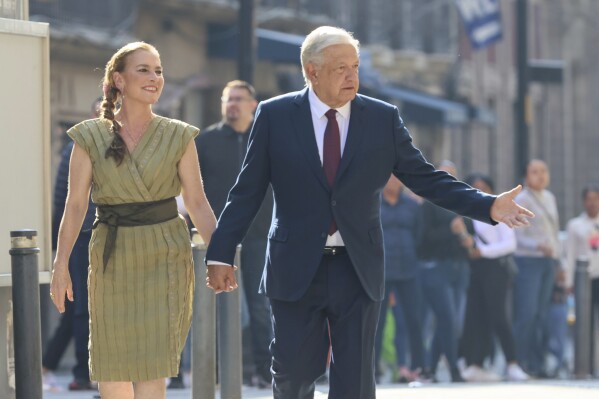
Outgoing President Andrés Manuel López Obrador and first lady Beatriz Gutiérrez Müller arrive to vote during general elections in Mexico City, Sunday, June 2, 2024. (AP Photo/Ginnette Riquelme)
Outgoing President Andrés Manuel López Obrador walked out of the National Palace and into a nearby voting location to cast his ballot.
The 70-year-old leader wearing a blue suit ducked into a voting booth to mark his ballot.
López Obrador oversaw a months-long internal campaign in his Morena party to select his successor. Former Mexico City Mayor Claudia Sheinbaum emerged victorious in internal polling and received López Obrador’s seal of approval.
She ran a conservative campaign essentially promising to continue her mentor’s policies.

Voters of the Latin American country of 130 million people have started casting their ballots. Voters began lining up before dawn for the historic election.
The election – and Mexican politics in recent years – have been deeply divisive, reflecting polarized Mexican society.
Former Mexico City Mayor Claudia Sheinbaum is a clear frontrunner in the race, and is seen as a continuation candidate of President Andrés Manuel López Obrador and his Morena party.
Others have turned to opposition presidential candidate Xóchitl Gálvez , who has focused her ire on López Obrador’s “hugs not bullets” policy of not confronting the drug cartels.
Jorge Álvarez Máynez of the smaller Citizen Movement party has targeted the youth vote, but has trailed the two women.
At a special voting post on a large Mexico City medical campus where people like on-duty doctors and nurses who can’t get home to vote can cast their ballots, men and women are waiting for polls to open.
Aida Fabiola Valencia said, “yesterday I told my colleagues to go vote, I don’t know who they are going to vote for but it is the first time they are going to be able to elect a woman, who I think is going to play an important role, we (women) are 60% of the population, it is historic.”
There have been female candidates before in Mexico, but this is the first time the two leading candidates — Claudia Sheinbaum and Xóchitl Gálvez — are women.

FILE - This combo image shows opposition presidential candidate Xochitl Galvez, left, on July 4, 2023, and presidential frontrunner Claudia Sheinbaum, on May 29, 2024, both in Mexico City. Voters choosing Mexico’s next president will decide on Sunday, June 2, 2024, between Sheinbaum, a former mayor and academic, and Galvez, an ex-senator and tech entrepreneur. A third candidate from a smaller party trails far behind. (AP Photo/File)
Nearby, Mónica Martínez, said “The fact that people vote for a candidate who is a woman implies a lot of change at all social and work levels, that means that it is already starting to get better. It already is. But the fact that it is for a presidential candidacy is much more significant.”
On the fringes of Mexico City in the neighborhood of San Andres Totoltepec, electoral officials filed past 34-year-old homemaker Stephania Navarrete, who watched dozens of cameramen and electoral officials gathering where frontrunner Claudia Sheinbaum was set to vote.
Navarrete said she planned to vote for Sheinbaum despite her own doubts about outgoing President Andrés Manuel López Obrador and his party.
“Having a woman president, for me as a Mexican woman, it’s going to be like before when for the simple fact that you say you are a woman you’re limited to certain professions. Not anymore.”
She said the social programs of Sheinbaum’s mentor were crucial, but that deterioration of cartel violence in the past few years was her primary concern in this election.
“That is something that they have to focus more on,” she said. “For me security is the major challenge. They said they were going to lower the levels of crime, but no, it was the opposite, they shot up. Obviously, I don’t completely blame the president, but it is in a certain way his responsibility.”
Mexicans are voting Sunday in historic elections weighing gender , democracy and populism , as they chart the country’s path forward in voting shadowed by cartel violence .
The race is historic . With two women leading the contest, Mexico will likely elect its first female president. The elections are also the country’s biggest , with more than 19,000 congressional and local positions up for grabs.
The Associated Press’ reporting team on the ground will be providing updates throughout the day.
What to know about Mexico’s 2024 presidential election
Nearly 100 million Mexicans will cast their ballots on June 2 in an election that could help cement the legacy of AMLO.

On June 2, people across Mexico will head to the polls to choose a new leader, as part of the largest election in the country’s history.
The election will allow voters to decide more than 20,700 positions at the federal and local level, including 500 seats in the country’s House of Representatives and 128 in its Senate.
Keep reading
At least nine dead after stage collapses at mexico campaign rally at least nine dead after stage collapses ..., in mexico’s election, candidates grapple with the search for the missing in mexico’s election, candidates grapple ..., two mexican mayoral contenders found dead on same day two mexican mayoral contenders found ....
But much of the attention will be on the race for president, as Andres Manuel Lopez Obrador, colloquially known as AMLO, finishes his term as one of the most popular leaders in Mexico’s modern history.
Scientist and former Mexico City Mayor Claudia Sheinbaum hopes to succeed AMLO as the candidate for the political party Morena. But she faces competition from conservative rival Xochitl Galvez , a former senator and businessperson of Otomi Indigenous descent.
If Sheinbaum or Galvez succeeds in winning the presidency, it will be a historic moment for Mexico: Never before has a woman been elected president.
As Mexicans in each of the country’s 32 states prepare to go to the polls, Al Jazeera explores the stakes underpinning the election. Which issues have dominated the campaign, and how does the electoral process work?
We answer those questions and more in this explainer.

How big is the 2024 election?
About 100 million Mexicans are expected to cast their ballot in June, a record for a country that has seen voter participation decline in previous elections.
Participation in this year’s election is set to increase by approximately 11 million voters over the last presidential election in 2018.
How will the vote unfold?
According to the Instituto Nacional Electoral (INE), the country’s elections oversight body, Mexicans will vote at 170,000 polling stations (PDF) throughout the country. A voter identification card is required for participation.
Mexico has one of the largest diaspora populations in the world, with more than 11 million people living abroad. But registered voters who are outside of the country can nevertheless cast their ballots online, via post or in person at Mexican consulates.
Early voting was also allowed for those with disabilities or limited physical mobility from May 6 through May 20.
On June 2, polls will open at 8am at the earliest and close at 6pm. Voters still in line by 6pm must be allowed to cast their vote.
After polls are closed, election officers will begin counting the results, with the INE providing real-time statistics. A second count to finalise the results will be carried out from June 5 through 8.
What are the major parties?
Two main coalitions have emerged this electoral cycle in the battle for the presidency.
One is a conservative coalition composed of three parties, collectively titled “Strength and Heart for Mexico”. The second is a left-leaning coalition led by the Morena party, called “Let’s Keep Making History”.
The first includes the National Action Party (PAN), the Institutional Revolutionary Party (PRI) and the Democratic Revolution Party (PRD).
The PRI was the dominant political force in Mexico for much of the 20th century, holding power for 71 straight years, often through fraud and repression. The “Strength and Heart for Mexico” coalition brings it together with PAN, a rival conservative party that brought its ruling streak to an end in 2000.
The second coalition joins Morena — the current governing party — with the Green Ecological Party of Mexico (Verde) and the Labour Party (PT).
Another party, the Citizen’s Movement, is standing for seats on its own outside of the two main coalitions.
Are these traditional coalitions?
Carlos Bravo Regidor, a writer and political analyst based in Mexico City, says these coalitions are a novelty in Mexican politics — and a testament to AMLO’s impact on the political landscape.
“This is an entirely new political configuration that is a result of Lopez Obrador,” he said.
Regidor explained that Lopez Obrador has become so popular that erstwhile rivals have had to ally with each other in order to compete in this year’s presidential race.
“To have PRI, PAN and PRD running together is such a historical aberration. For most of Mexico’s democratic history, these three parties used to run against each other,” he explained.
“This is a testament to the impact that Lopez Obrador has had, that these three parties — historical rivals who represented the right, the left and the centre in the Mexican political spectrum — are all running together trying to defeat Lopez Obrador’s candidates.”
Who is representing the coalitions in the presidential race?
Sheinbaum is representing “Let’s Keep Making History”, the left-wing coalition. Galvez, her conservative rival, was chosen to be the presidential candidate for “Strength and Heart for Mexico”.
Meanwhile, former member of Congress Jorge Alvarez Maynez is running on behalf of the Citizens’ Movement.
What are the central issues in the campaign?
Polling shows that voters have listed issues such as security, social programmes and corruption as top priorities.
The election is also seen as a referendum on the presidency of Lopez Obrador.
Sheinbaum, his protégé, has promised to carry forward AMLO’s policies of expanding social programmes and helming large infrastructure projects like the Maya Train, a controversial rail line through the Yucatan peninsula.
Galvez has emerged as a protest candidate, promising to quell violence and corruption with a hard hand: She has criticised Lopez Obrador for saying he would address crime through “hugs, not bullets”.
Despite using the slogan during his 2018 presidential campaign, Lopez Obrador has expanded the role of the country’s military in domestic law enforcement. Galvez, for her part, has said she would start to roll back the trend of relying on the military for public security.
How has crime influenced the 2024 race?
The ongoing violence faced by the country has made itself felt during the campaign season, with an estimated 34 would-be candidates killed between September and May.
Just last month, two mayoral candidates were found dead in the northern state of Tamaulipas. And on May 17, gunmen in the southern state of Chiapas killed six people at a political rally, including another mayoral candidate.
Officials have blamed drug cartels and organised crime for the slayings, which have largely affected local races.

Who is leading the presidential race?
Most polls show Sheinbaum with a sizable lead of more than 20 points over Galvez. Maynez is considered a long shot.
AMLO’s popularity is also expected to help buoy Morena up and down the ballot, where his coalition is aiming to expand its majority in the legislature.
Why is Sheinbaum so far ahead?
Regidor, the political analyst, said Galvez has played her hand well and run a fairly dynamic campaign. But he believes Galvez’s affiliation with the PAN and PRI parties has hampered her prospects.
“All of the negative attributes you can think of, Mexican voters associate the most with the PRI and, to a lesser extent, with the PAN,” Regidor explained.
“So Xochitl has not been able to run as a candidate of change, because the idea of change is incompatible with running under the banner of the PAN and the PRI.”
In 2006, under the PAN presidency of Felipe Calderon, the government launched its controversial “war on drugs”, leaning into a militarised approach to law enforcement.
But that strategy led to an explosion of violence while doing little to stem the narcotics trade. It also fostered growing reports of military abuses, including evidence of outright collaboration between security forces and criminal groups.
The PRI, meanwhile, has long been dogged by accusations of corruption and oppression: From 1929 to 2000, it was the dominant force in Mexican politics.
The long-ruling party briefly reclaimed the presidency in 2012, with candidate Enrique Pena Nieto. But corruption scandals and dissatisfaction with his neoliberal economic policies led to the election of AMLO in 2018.
“Something that helps explain the large victory of Lopez Obrador in 2018 is the discredit of those traditional parties. In poll after poll, they ask voters: Who is the worst with corruption? The PRI. Who is the worst with violence? The PRI. Who is the worst at caring for the poor? The PRI,” said Regidor.
He added that the PRI’s lengthy history has left a lasting stink in the eyes of voters.
“The PRI has become the Chernobyl of Mexican politics. It’s just so toxic.”
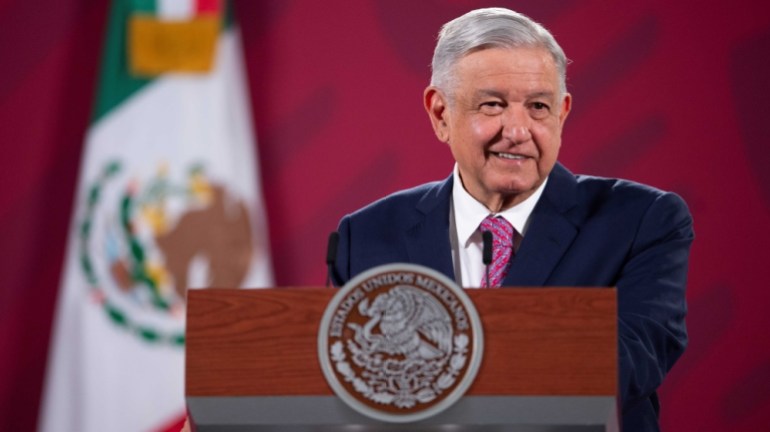
What is the outgoing president’s legacy?
Lopez Obrador has been consistently ranked one of the most popular world leaders currently in power — though his election in 2018 came after two failed bids for the presidency.
Known for his outspoken personality, Lopez Obrador has made addressing poverty a central pillar of his presidency.
But he has also pushed controversial initiatives that critics say aim to diminish the independence of the country’s judiciary and election oversight body. In addition, he has expanded the role of the military to include infrastructure projects and public safety initiatives, despite concerns about human rights abuses.
His critics have also expressed disappointment at his failure to tamp down on crime and address the thousands of missing persons cases in Mexico, which surpassed 100,000 under his presidency.
The majority of those cases were logged after the country launched its “war on drugs” in 2006. Providing answers to the families of the disappeared was a promise on which Lopez Obrador campaigned in 2018.
Why can’t AMLO run for a second term?
During his time in office, Lopez Obrador has achieved something increasingly elusive in global politics: consistently high levels of popularity.
According to a poll tracker by the Americas Society and the Council of the Americas, AMLO’s approval, while down from an early high of 81 percent, has never dropped below 60 percent.
Given that level of popularity, why can’t Lopez Obrador run for a second term himself?
The answer is simple: Mexico’s constitution explicitly limits the presidency to a single term.
That is a legacy of the Mexican Revolution, which was fought after the decades-long rule of dictator Porfirio Diaz, known as the Porfiriato. His leadership turned “no reelection” into a common rallying cry.

IMAGES
VIDEO
COMMENTS
10. Catedral Metropolitana. There is no shortage of things to do, see and explore in Mexico City, but a top attraction is unquestionably the Catedral Metropolitana. It is the oldest and the largest cathedral in Latin America, and the 16th century structure dominates the city's central plaza, known as the Zocalo.
To ensure you plan the very best Mexican travel itinerary possible, check out our list of the best places to visit in Mexico. On This Page: 1. Cancún and the Mayan Riviera. 2. Puerto Vallarta. 3. Cabo San Lucas, San Jose del Cabo, and the Los Cabos Corridor. 4.
9. Zihuatanejo. Best place for an Old-Mexico feel. Zihuatanejo benefited from the fortunes of neighboring resort town Ixtapa, which Mexico's tourism body carefully developed in the 1970s. This was a direct attempt to replicate the Caribbean splendor of Cancún on the Pacific coast.
1. Teotihuacan Pyramids. Teotihuacan Pyramids, located just outside Mexico City, is an ancient city known for its massive pyramids, the Sun and the Moon. With a history dating back to 100 B.C., these structures stand as testament to a powerful Mesoamerican civilization. @chlo_et_anto / Instagram.
Here are the best things to do in Mexico. 1. Admire the monumental power of a pyramid. Pyramids humble you. Gaze skywards at the Pyramid of the Sun at Teotihuacán , and it's easy to feel tiny. It's the third-largest ancient pyramid in the world, bringing the ancient priests closer to the heavens at its summit.
2023. 1. Museo Nacional de Antropologia. 20,244. Natural History Museums. Admission tickets from $12. Considered one of the world's most comprehensive natural history museums, this famous institution houses four square kilometers of exhibits in 23 exhibition halls. See ways to experience (55) 2023.
The tourism industry in 2018 was about 8.7% of Mexico's GDP and brought the country 215.5 billion Mexican pesos (or 10.8 billion U.S. dollars) in export earnings. [22] That same year, it also provided jobs for over 2.3 million people, which is 6% of the total employment in the nation.
Read More: Top-Rated Tourist Attractions in Mexico City; 13. See the Copper Canyon by Train Copper Canyon. Most people are surprised to learn that Mexico has its own Grand Canyon. In fact, it's even bigger than the one in the United States. Copper Canyon, or Barrancas del Cobre, is a massive canyon in the northern state of Chihuahua, which ...
Mexico is a great mosaic that combines beautiful natural settings, cities with pre-Hispanic, colonial and modern heritage, a wide variety of exquisite delicacies that delight palates, and fascinating traditions that captivate the visitor. From the beach to the mountains, from the desert to the jungle, from the archaeological zone to the vibrant ...
Mexico. North America. Check out this year's Best in Travel winners. Palm-fringed beaches, chili-spiced cuisine, steamy jungles, teeming cities, fiesta fireworks: Mexico conjures diverse, vivid dreams - and then delivers them. Best Time to Visit.
4. Rio Secreto. 9,556. Caverns & Caves. Mexico reveals its newly-discovered underground river: Very few places in the world boast conditions that make it possible to witness the extraordinary beauty of an underground river. Rio Secreto …. See ways to experience (25) 2023. 5.
Copper Canyon, Chihuahua. jejim/Getty Images. Also known as the Grand Canyon of Mexico, Copper Canyon is comprised of not one but six separate canyons. This natural wonder, a UNESCO World Heritage ...
Some of the best places to visit in the area include Mahahual Beach, Costa Maya Port Mexico, and Maya Lost Mayan Kingdom. 22. Riviera Nayarit. The Riviera Nayarit is a nearly 322 kilometre stretch of sandy shores and charming villages north of Puerto Vallarta.
Very few places take credit cards here, so make sure to bring a small amount of cash with you everywhere you go. ☂️ See Playa Zipolite on a tour. Mazunte, Zipolite, Ventanilla, Punta Cometa. LANDMARK 21. El Ángel de la Independencia is one of the most recognizable landmarks in Mexico.
The sprawling archaeological complex dates back over 1500 years, Chichen Itza is one of the most visited Mexico tourist attractions. The design of the temple has special astronomical significance. Each face of the pyramid has a stairway with 91 steps. Together with the shared step at the top, they add up to 365 - the number of days in a year.
19. Church of San Francisco. Where to Stay in Mexico City for Sightseeing. Tips and Tours: How to Make the Most of Your Visit to Mexico City. Map of Tourist Attractions in Mexico City. Mexico City, Mexico - Climate Chart. 1. Zócalo: The Birthplace of the Constitution. Zócalo: The Birthplace of the Constitution.
Kyle McCarthy|Sharael Kolberg December 4, 2023. Ranking of the top 16 things to do in Mexico City. Travelers favorites include #1 Museo Nacional de Antropología, #2 Bosque de Chapultepec and more.
10. Chapultepec Park. Chapultepec Park, one of the largest city parks in Latin America, is a vast green space at the heart of Mexico City. It encompasses lakes, museums, a zoo, and cultural venues, making it a dynamic place to visit in Mexico City for families and individuals alike.
3. Sail Xochimilco's vivid canals. Xochimilco is a UNESCO World Heritage Site, known for its historic canal system and the traditional trajineras (colorful, flat-bottomed boats). It offers a glimpse into pre-Hispanic life in the region and is one of the best things to do in Mexico City for groups of friends.
Nonetheless, Mexico has also felt the impact of COVID-19 on its tourism sector. In 2020, travel and tourism accounted for less than seven percent to the Mexican GDP. And despite the recovery ...
Mexico will hold its general election on June 2, when nearly 100 million people will be called to vote. There are 20,375 positions on the ballot, of which 19,746 are local and 629 are federal ...
Claudia Sheinbaum, of the ruling party Morena, is projected to become Mexico's first woman president after a landslide victory in Sunday's election, according to a quick count by the country's electoral commission. Why it matters: Mexico is the largest trading partner of the U.S. and a key ally, especially when it comes to migration.
June 3, 2024 / 12:33 PM EDT / CBS/AP. Claudia Sheinbaum, who will be Mexico's first woman leader in the nation's more than 200 years of independence, captured the presidency by promising ...
Mexico, North America. A high-octane megalopolis boasting old-school cantinas, intriguing museums, inspired dining and boating along ancient canals, Mexico City is the sun in the Mexican solar system. Best Time to Visit. Best Things to Do. Attractions.
Claudia Sheinbaum, the former head of the government of Mexico City and candidate for the ruling Morena party, is projected to be the country's first female president. CNN values your feedback 1.
Marian Carrasquero for The New York Times. Here are five things to know about the newly elected president of Mexico that help inform whether she will stray from Mr. López Obrador's policies or ...
Ruling party presidential candidate Claudia Sheinbaum arrives to vote during general elections in Mexico City, Sunday, June 2, 2024. (AP Photo/Eduardo Verdugo) As she left home to vote, frontrunner Claudia Sheinbaum told reporters briefly that she was "very happy, very excited" on what she described as a "historic day.".
On June 2, people across Mexico will head to the polls to choose a new leader, as part of the largest election in the country's history. The election will allow voters to decide more than 20,700 ...